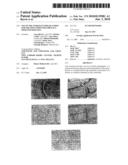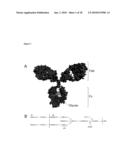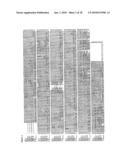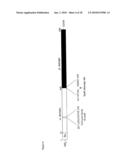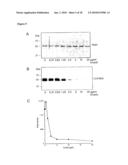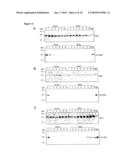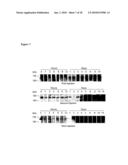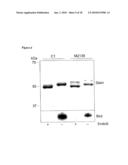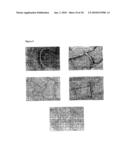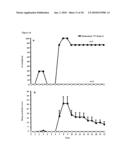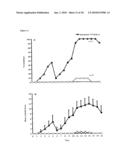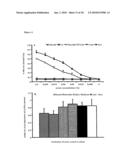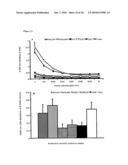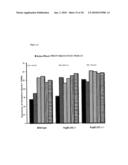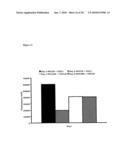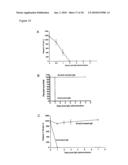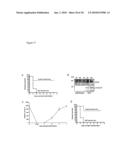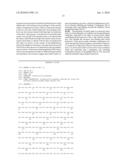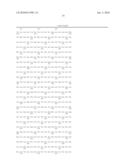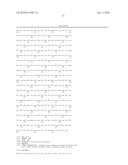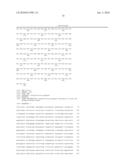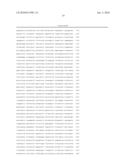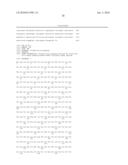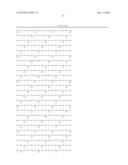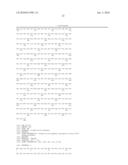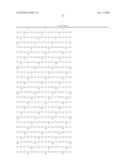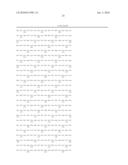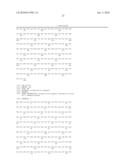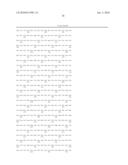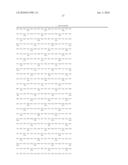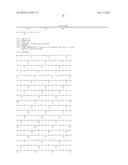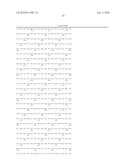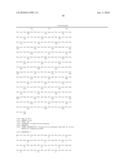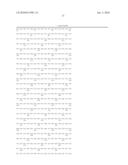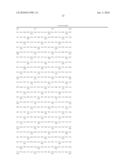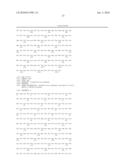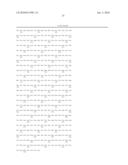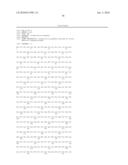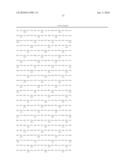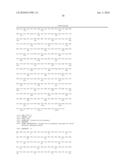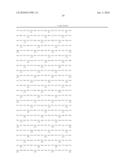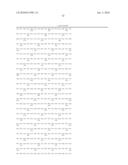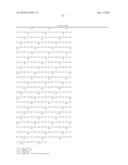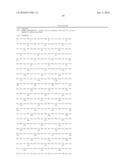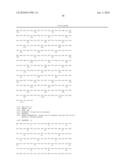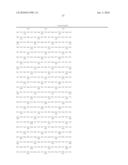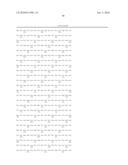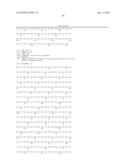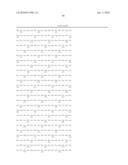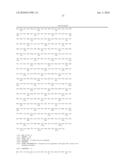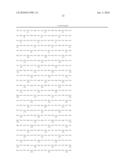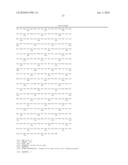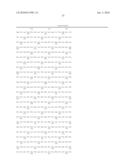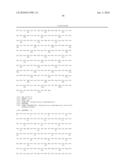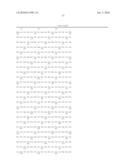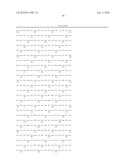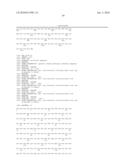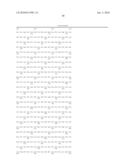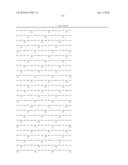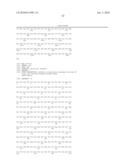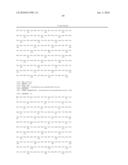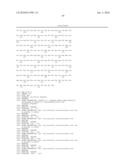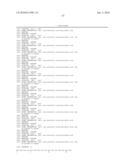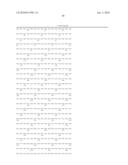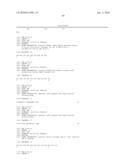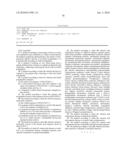Patent application title: USE OF THE ENDOGLYCOSIDASE ENDOS FOR TREATING IMMUNOGLOBULIN G MEDIATED DISEASES
Inventors:
Lars Björck (Lund, SE)
Mattias Collin (Lund, SE)
Arne Olsen (Onsala, SE)
Rikard Holmdahl (Lund, SE)
Rikard Holmdahl (Lund, SE)
Kutty Selva Nandakumar (Ambur, IN)
Oonagh Shannon (Veberod, SE)
Assignees:
Hansa Medical AB
IPC8 Class: AA61K3847FI
USPC Class:
424 9461
Class name: Enzyme or coenzyme containing hydrolases (3. ) (e.g., urease, lipase, asparaginase, muramidase, etc.) acting on glycosyl compound (3.2) (e.g., glycosidases lysozyme, nucleosidases, cellulase, etc.)
Publication date: 2010-06-03
Patent application number: 20100135981
Claims:
1-12. (canceled)
13. A method of treating or preventing a disease or condition mediated by IgG antibodies in a subject in need thereof, the method comprising administering to the subject a therapeutically effective amount of an EndoS polypeptide, or a polynucleotide encoding an EndoS polypeptide.
14. A method of treating, ex vivo, blood taken from a patient suffering from a disease or condition mediated by IgG antibodies, comprising contacting the blood with an EndoS polypeptide.
15. A method according to claim 14, wherein the blood is returned to the patient after contacting it with said EndoS polypeptide.
16. A method according to claim 13, wherein said EndoS polypeptide comprises:(a) the amino acid sequence of SEQ ID NO: 1;(b) a variant thereof having at least 50% identity to the amino acid sequence of SEQ ID NO: 1 and having IgG endoglycosidase activity; or(c) a fragment of either thereof having IgG endoglycosidase activity.
17. The method according to claim 16, wherein said polypeptide consists of the sequence shown in SEQ ID NO: 1.
18. The method according to claim 13, wherein said polynucleotide comprises:(a) the coding sequence of SEQ ID NO: 3;(b) a sequence which is degenerate as a result of the genetic code to the sequence as defined in (a);(c) a sequence having at least 60% identity to a sequence as defined in (a) or (b) and which encodes a polypeptide having IgG endoglycosidase activity; or(d) a fragment of any one of the sequences as defined in (a), (b) or (c) which encodes a polypeptide having IgG endoglycosidase activity.
19. The method according to claim 18, wherein said polynucleotide consists of the nucleic acid sequence shown in SEQ ID NO: 3.
20. The method of claim 13, wherein the disease or condition is an autoimmune disease, transplant rejection, post-operative treatment or acquired haemophilia.
21. The method according to claim 20, wherein said autoimmune disease is Addison's disease, alopecia greata, ankylosing spondilitis, antiphospholipid syndrome, aplastic anaemia, autoimmune gastritis, autoimmune hearing loss, autoimmune haemolytic anaemias, autoimmune hepatitis, autoimmune hypoparathyroidism, autoimmune hypophysitis, autoimmune inner ear disease, autoimmune lymphoproliferative syndrome, autoimmune myocarditis, autoimmune oophoritis, autoimmune orchitis, autoimmune polyendocrinopathy, Bechet's disease, bullous pemphigoid, cardiomyopathy, chronic inflammatory demyelinating polyneuropathy, Churg-Strauss syndrome, coeliac disease, Crohn's disease, CREST syndrome, Degos disease, epidermolysis bullosa acquisita, essential mixed cryoglobulinaemia, giant cells arteritis, glomerulonephritis, Goodpasture's syndrome, Graves' disease, Guillan-Barre syndrome, Hashimoto's thyroiditis, idiopathic thrombocytopenic purpura, inflammatory bowel disease, Kawasaki's disease, Meniere's syndrome, mixed connective tissue disease, Mooren's ulcer, multiple sclerosis, myasthenia gravis, pemphigus foliaceous, pemphigus vulgaris, pernicious anaemia, polyarteritis nodosa, polyglandular autoimmune syndrome type 1 (PAS-1), polyglandular autoimmune syndrome type 2 (PAS-2), polyglandular autoimmune syndrome type 3 (PAS-3), polymyositis/dermatomyositis, primary biliary cirrhosis, psoriasis, psoriatic arthritis, Raynaud's syndrome, Reiter's syndrome, rheumatoid arthritis, sarcoidosis, scleroderma, Sjogren's syndrome, subacute thyroiditis, sympathetic opthalmia, systemic lupus erythematosus, Takayasu's arteritis, type 1 diabetes mellitus, vitiligo, Vogt-Koyanagi-Harada disease or Wegener's granulomatosis.
22. The method according to claim 21, wherein said autoimmune disease is rheumatoid arthritis.
23. The method according to claim 21, wherein said autoimmune disease is systemic lupus erythematosus.
24. The method according to claim 21, wherein said autoimmune disease is idiopathic thrombocytopenic purpura.
25. The method according to claim 20, wherein said transplant rejection is allograft or xenograft rejection.
Description:
FIELD OF THE INVENTION
[0001]The present invention relates to a method for treating or preventing diseases or conditions mediated by IgG antibodies, such as autoimmune diseases, transplant rejection, post-operative treatment and acquired haemophilia.
BACKGROUND OF THE INVENTION
[0002]IgG is a heterotetramer composed of two heavy chains and two light chains held together by disulfide bonds forming three protein domains separated by a flexible and protease sensitive hinge region. The two identical Fab portions bind antigens and the single Fc portion is responsible for effector functions, including binding and activation of complement factor C1q and Fc receptors on leukocytes.
[0003]In addition to the polypeptide backbone the Fc portion contains a conserved glycan on each heavy chain attached to Asn-297. This oligosaccharide is of the complex biantennary type with a core fucose linked to the innermost N-acetylglucosamine (GlcNAc). These glycans are located in the interface between the CH2 domains (second constant domain of the heavy chains).
[0004]EndoS is an endoglycosidase secreted by the human pathogen Streptococcus pyogenes. EndoS specifically hydrolyzes the asparagine-linked glycan on IgG between the two core GlcNAc residues. In contrast to many related endoglycosidases that require or are enhanced by denaturation of the glycoprotein substrate, EndoS only hydrolyzes native IgG. No other substrate for EndoS has been found to date.
SUMMARY OF THE INVENTION
[0005]The present inventors have shown that EndoS is useful in treating and preventing diseases mediated by IgG antibodies. In particular, the inventors have shown that EndoS efficiently hydrolyzes IgG in human blood and in vivo in rabbits, that deglycosylation of IgG by EndoS abrogates its arthritis-inducing capacity in mice, and that EndoS has a protective effect in a mouse model of lethal IgG-driven idiopathic thrombocytopenic purpura (ITP). EndoS pretreatment of pathogenic antibodies inhibits the development of this disease, and the enzyme also rescues mice from already established disease when severe thrombocytopenia and subcutaneous bleeding have developed.
[0006]In accordance with the present invention, there is thus provided the use of an EndoS polypeptide, or a polynucleotide encoding an EndoS polypeptide, in the manufacture of a medicament for the treatment or prevention of a disease or condition mediated by IgG antibodies.
[0007]The present invention also provides: [0008]an EndoS peptide, or a polynucleotide encoding an EndoS polypeptide, for use in a method for treating or preventing a disease or condition mediated by IgG antibodies; [0009]a method of treating or preventing a disease or condition mediated by IgG antibodies in a subject in need thereof, the method comprising administering to the subject a therapeutically effective amount of an EndoS polypeptide, or a polynucleotide encoding an EndoS polypeptide; and [0010]a method of treating, ex vivo, blood taken from a patient suffering from a disease or condition mediated by IgG antibodies, comprising contacting the blood with an EndoS polypeptide.
BRIEF DESCRIPTION OF THE FIGURES
[0011]FIG. 1A is a structural model of human IgG1. Brackets indicate the antigen binding Fab portion and the Fc effector portion of IgG. The arrow indicates the two conserved glycans attached to Asn-297 of the heavy chains. FIG. 1B is a schematic representation of the fully substituted IgG heavy chain glycan. S2 indicates the fully sialylated glycoform, G0 and bracket indicate the extent of the G0 glycoform. LCA indicates the binding site for the Lens culinaris agglutinin used in lectin experiments and EndoS indicates the cleavage site for the enzyme.
[0012]FIG. 2 is a ClustalW amino acid sequence alignment of EndoS homologues from different S. pyogenes serotypes, S. equi and S. zooepidemicus. Strain names, species, and M serotypes are shown to the left. Amino acid identities and similarities are shown in grey and the consensus sequence is shown under the alignment. The conserved chitinase motif is boxed and the glutamic acid essential for activity is marked with an asterisk below the alignment.
[0013]FIG. 3 is a ClustalW amino acid sequence alignment of the EndoS α-domain with EndoF2 from Elizabethkingia meningoseptica and CP40 from Corynebacterium pseudotuberculosis. Protein names are shown to the left. Amino acid identities and similarities are shown in grey and the consensus sequence is shown under the alignment. The conserved chitinase motif is boxed and the glutamic acid essential for activity is marked with an asterisk below the alignment.
[0014]FIG. 4 shows the domain organization of EndoS. Schematic representation of the 995 amino acids of full-length EndoS (SEQ ID NO: 2). Ss indicates signal peptide, the chitinase family 18 active site motif in the α-domain is indicated, and the SpeB cleavage site generating the two domains is indicated with an arrow.
[0015]FIG. 5 shows an analysis of EndoS activity in human blood. FIG. 5A shows SDS-PAGE analysis of purified IgG from human blood incubated with increasing concentrations of recombinant EndoS (rEndoS). FIG. 5B shows an LCA lectin blot analysis of purified IgG from human whole blood incubated with increasing concentrations of rEndoS. FIG. 5C shows densitometric analysis of the lectin blot on IgG purified from human blood incubated with increasing concentrations of rEndoS.
[0016]FIG. 6 shows an analysis of in vivo activity of EndoS in rabbit. FIG. 6A shows SDS-PAGE (stain) and lectin blot analysis (LCA blot) of purified IgG from serum samples withdrawn from the rabbit at indicated time point after the first intravenous injection of 500 μg of rEndoS. FIG. 6B shows SDS-PAGE (stain) and lectin blot analysis (LCA blot) of purified IgG from serum samples withdrawn from the rabbit at indicated time point after a second administration of rEndoS. FIG. 6C shows SDS-PAGE (stain) and lectin blot analysis (LCA blot) of purified IgG from serum samples withdrawn from the rabbit at indicated time point after a third administration of rEndoS.
[0017]FIG. 7 shows the rabbit antibody response to rEndoS. Serum samples were withdrawn from the rabbit at indicated time point after the first, second and third injections of rEndoS. The sera were used as primary antisera in a Western blot on separate membrane strips with SDS-PAGE separated purified rEndoS.
[0018]FIG. 7A also shows the rabbit antibody response to rEndoS. Serum samples are the same as for FIG. 7. Insert: Western blot as in FIG. 7 using the serum samples after the first injection as primary antisera. Main figure: Serum samples following the first, second, and third injections were used as primary antisera in an ELISA experiment with immobilized EndoS. Increase in concentration (ng/ml) of anti-EndoS IgG compared to concentration before first injection is presented. One representative experiment is shown.
[0019]FIG. 8 shows SDS-PAGE (Stain) and lectin blot analysis (Blot) of IgG monoclonal antibodies (CIIC1 and M2139) incubated with and without EndoS and separated by 10% SDS-PAGE. Gels were analysed by Coomassie Blue staining (Stain) or by blotting to a membrane that was probed with GNL lectin (Blot). CIIC1 (IgG2a) monoclonal antibody was incubated with EndoS (Lane 1) and without EndoS (Lane 2); M2139 (IgG2b) monoclonal antibody was incubated with EndoS (Lane 3) and without Endo S (Lane 4).
[0020]FIG. 9 shows joint sections (10 μm) from rats treated with normal and EndoS-treated CII-binding antibodies: (a) M2139, (b) M2139D, (c) CIIC1, (d) CIICID and (e) control; and stained. Magnification is ×10. Antibodies deglycosylated using EndoS are indicated as "D". 1-2 day old neonatal rats were injected with 1 mg of CII-binding antibody (both normal and EndoS treated) i.p. Twenty-four hours after the antibody transfer, paws were dissected and snap frozen in OCT compound using isopentane and dry ice. Immuno-histochemical analysis was performed using biotinylated anti-mouse kappa (187.1) antibody and HRP conjugated secondary antibody as the detecting system using standard protocol.
[0021]FIG. 10 shows the incidence (a) and severity (b) of arthritis in mice receiving untreated or EndoS-treated anti-CII monoclonal antibodies. Groups of male (BALB/c×B10.Q) F1 mice were injected with 9 mg of either untreated (n=7) or EndoS treated (n=5) anti-CII monoclonal antibodies (M2139 and CIIC1) on day 0. All of the mice were injected with 50 μg of E. coli LPS i.p. on day 5. All the mice were included for calculations. Error bars indicate mean±SEM.
[0022]FIG. 11 shows the incidence (a) and severity (b) of arthritis in mice receiving untreated or EndoS-treated anti-CII monoclonal antibodies. Male B10.RIII mice were injected with 9 mg of either untreated (n=11) or EndoS treated (n=12) anti-CII monoclonal antibodies (M2139 and CIIC1) on day 0. All of the mice were injected with 50 μg of E. coli LPS i.p. on day 5. All the mice were included for calculations. Error bars indicate mean±SEM.
[0023]FIG. 12 shows deposition of complement component C1q on: (a) CII-coated antibody bound plates using different concentrations of normal (BALB/c×B10.Q) F1 serum; and (b) directly antibody coated plates at 0.25% normal (BALB/c×B10.Q) F1 serum. Error bars indicate±SD.
[0024]FIG. 13 shows deposition of complement component C3b on: (a) CII-coated antibody bound plates using different concentrations of normal (BALB/c×B10.Q) F1 serum; and (b) directly antibody coated plates at 0.125% normal (BALB/c×B10.Q) F1 serum. Error bars indicate±SD.
[0025]FIG. 14 shows the effect of deglycosylation of monoclonal antibodies on the neutrophil (PMNL) oxidative burst. Normal (M2139 or CIIC1) or deglycosylated (M2139-D or CIIC1-D) monoclonal antibodies were coated on carboxylated polystyrene microparticles (1 μm). The oxidative burst capacity of PMNLs from heparinized whole blood samples was determined using FACS after incubating them with antibody-coated beads. The results are mean values from 5 mice in each group. B10.Q mice having three different genotypes were used (FcgR+/+, FcgR-/- and FcgR+/-). The "medium" and "beads" groups constituted two different negative controls. The PMA group was the positive control. PMNLs were identified using RB6-APC conjugate.
[0026]FIG. 15 shows the level of anti-CII antibodies measured by ELISA in the serum of B10.RIII mice (day 1 and day 5) transferred with 9 mg of monoclonal antibody cocktail (M2139 and CIIC1 or M2139D and CIIC1D) i.v. Mean europium fluorescence units were measured using a multilabel counter (VICTOR 1420, Wallac).
[0027]FIG. 16 shows that EndoS pretreatment of pathogenic IgG antibodies inhibits antibody-mediated thrombocytopenia in mice. Panel A: Female BALB/c mice (n=3) received intraperitoneal injections of rabbit anti-mouse platelet IgG (αPLT-IgG). Blood samples were taken at regular intervals and platelet counts were determined using flow cytometry. Panel B: Survival plots of BALB/c mice injected with αPLT-IgG that had been pretreated with GST-EndoS (n=4) or GST (n=4). Panel C: Platelet counts over time as determined by flow cytometry on blood samples from mice that had received αPLT-IgG pretreated with GST-EndoS.
[0028]FIG. 17 shows that EndoS rescues mice from lethal IgG-mediated thrombocytopenia. Panel A: Survival plots of BALB/c mice injected with αPLT-IgG followed by GST-EndoS (n=8) or GST (n=8) treatment 3 hours after αPLT-IgG administration. Panel B: SDS-PAGE analysis (STAIN) and LCA lectin blot analysis (LCA BLOT) of IgG purified from GST-EndoS or GST-treated mice 24, 48, or 72 (only GST-EndoS) hours after injection of αPLT-Ig. Panel C: Blood samples was taken at regular intervals and platelet counts were determined using flow cytometry in mice that received GST-EndoS treatment. Panel D, survival plots of BALB/c mice injected with αPLT-Ig followed by GST-EndoS (n=7) or GST (n=7) treatment at the onset of clear signs of intra-abdominal bleeding (5-7 h after αPLT-Ig administration).
Brief Description of the Sequences
[0029]SEQ ID NO: 1 is an amino acid sequence of EndoS isolated from S. pyogenes AP1.
[0030]SEQ ID NO: 2 is an amino acid sequence of EndoS isolated from S. pyogenes AP1, including a signal sequence.
[0031]SEQ ID NO: 3 is a nucleic acid sequence encoding EndoS isolated from S. pyogenes AP1, including a signal sequence.
DETAILED DESCRIPTION OF THE INVENTION
[0032]The present invention provides a method for treating or preventing diseases or conditions mediated by IgG antibodies, which method comprises administering to a subject an EndoS polypeptide or a polynucleotide encoding an EndoS polypeptide.
[0033]The present inventors have found that EndoS hydrolyzes IgG in human blood and in vivo in rabbits, that deglycosylation of IgG by EndoS abrogates its arthritis--inducing capacity in mice, and that EndoS has a protective effect in a mouse model of lethal IgG-driven idiopathic thrombocytopenic purpura (ITP). EndoS pretreatment of pathogenic antibodies inhibits the development of this disease, and the enzyme also rescues mice from already established disease when severe thrombocytopenia and subcutaneous bleeding have developed. Accordingly, EndoS can be used to treat or prevent diseases or conditions mediated by IgG antibodies.
Polypeptides
[0034]The EndoS polypeptide is preferably S. pyogenes EndoS, or a variant or fragment of S. pyogenes EndoS which retains IgG endoglycosidase activity. The variant may be an EndoS polypeptide from another organism, such as another bacterium. The bacterium is preferably a Streptococcus, such as Streptococcus equi, Streptococcus zooepidemicus or, preferably, Streptococcus pyogenes. Alternatively, the variant may be from Corynebacterium pseudotuberculosis, for example the CP40 protein; Enterococcus faecalis, for example the EndoE protein; or Elizabethkingia meningoseptica (formerly Flavobacterium meningosepticum), for example the EndoF2 protein. The sequences of EndoS variants from various S. pyogenes serotypes and from S. equi and S. zooepidemicus are shown in FIG. 2. FIG. 3 shows an alignment of the α-domain of EndoS with EndoF2 from Elizabethkingia meningoseptica and CP40 from Corynebacterium pseudotuberculosis.
[0035]The EndoS polypeptide may comprise:
[0036](a) the amino acid sequence of SEQ ID NO: 1;
[0037](b) a variant thereof having at least 50% identity to the amino acid sequence of SEQ ID NO: 1 and having IgG endoglycosidase activity; or
[0038](c) a fragment of either thereof having IgG endoglycosidase activity.
[0039]Preferably, the polypeptide comprises, or consists of, the sequence of SEQ ID NO: 1. SEQ ID NO: 1 is the sequence of the mature form of EndoS, without the signal sequence, and corresponds to amino acids 37 to 995 of SEQ ID NO: 2.
[0040]The polypeptide may additionally include a signal sequence. Accordingly, the EndoS polypeptide may comprise:
[0041](a) the amino acid sequence of SEQ ID NO: 2;
[0042](b) a variant thereof having at least 50% identity to the amino acid sequence of SEQ ID NO: 2 and having IgG endoglycosidase activity; or
[0043](c) a fragment of either thereof having IgG endoglycosidase activity.
[0044]The EndoS polypeptide may consist of the sequence shown in SEQ ID NO: 2.
[0045]Variant polypeptides are those for which the amino acid sequence varies from that in SEQ ID NO: 1 or SEQ ID NO: 2, but which retain the same essential character or basic functionality as EndoS. The variant polypeptides may therefore display IgG endoglycosidase activity. Typically, polypeptides with more than about 50%, 55% or 65% identity, preferably at least 70%, at least 80%, at least 90% and particularly preferably at least 95%, at least 97% or at least 99% identity, with the amino acid sequence of SEQ ID NO: 1 or SEQ ID NO: 2 are considered variants of the protein. Such variants may include allelic variants and the deletion, modification or addition of single amino acids or groups of amino acids within the protein sequence, as long as the peptide maintains the basic functionality of EndoS. The identity of variants of SEQ ID NO: 1 or SEQ ID NO: 2 may be measured over a region of at least 100, at least 250, at least 500, at least 750, at least 800, at least 850, at least 900, at least 950, at least 955 or more contiguous amino acids of the sequence shown in SEQ ID NO: 1 or SEQ ID NO: 2, or more preferably over the full length of SEQ ID NO: 1 or SEQ ID NO: 2.
[0046]Amino acid identity may be calculated using any suitable algorithm. For example the UWGCG Package provides the BESTFIT program which can be used to calculate homology (for example used on its default settings) (Devereux et al (1984) Nucleic Acids Research 12, 387-395). The PILEUP and BLAST algorithms can be used to calculate homology or line up sequences (such as identifying equivalent or corresponding sequences (typically on their default settings), for example as described in Altschul S. F. (1993) J Mol Evol 36:290-300; Altschul, S, F et al (1990) J Mol Biol 215:403-10.
[0047]Software for performing BLAST analyses is publicly available through the National Center for Biotechnology Information (http://www.ncbi.nlm.nih.gov/). This algorithm involves first identifying high scoring sequence pair (HSPs) by identifying short words of length W in the query sequence that either match or satisfy some positive-valued threshold score T when aligned with a word of the same length in a database sequence. T is referred to as the neighbourhood word score threshold (Altschul et al, supra). These initial neighbourhood word hits act as seeds for initiating searches to find HSPs containing them. The word hits are extended in both directions along each sequence for as far as the cumulative alignment score can be increased. Extensions for the word hits in each direction are halted when: the cumulative alignment score falls off by the quantity X from its maximum achieved value; the cumulative score goes to zero or below, due to the accumulation of one or more negative-scoring residue alignments; or the end of either sequence is reached. The BLAST algorithm parameters W, T and X determine the sensitivity and speed of the alignment. The BLAST program uses as defaults a word length (W) of 11, the BLOSUM62 scoring matrix (see Henikoff and Henikoff (1992) Proc. Natl. Acad. Sci. USA 89: 10915-10919) alignments (B) of 50, expectation (E) of 10, M=5, N=4, and a comparison of both strands.
[0048]The BLAST algorithm performs a statistical analysis of the similarity between two sequences; see e.g., Karlin and Altschul (1993) Proc. Natl. Acad. Sci. USA 90: 5873-5787. One measure of similarity provided by the BLAST algorithm is the smallest sum probability (P(N)), which provides an indication of the probability by which a match between two polynucleotide or amino acid sequences would occur by chance. For example, a sequence is considered similar to another sequence if the smallest sum probability in comparison of the first sequence to the second sequence is less than about 1, preferably less than about 0.1, more preferably less than about 0.01, and most preferably less than about 0.001.
[0049]The variant sequences typically differ by at least 1, 2, 3, 5, 10, 20, 30, 50, 100 or more mutations (which may be substitutions, deletions or insertions of amino acids). For example, from 1 to 100, 2 to 50, 3 to 30 or 5 to 20 amino acid substitutions, deletions or insertions may be made. The modified polypeptide generally retains activity as an IgG-specific endoglycosidase. The substitutions are preferably conservative substitutions, for example according to the following Table. Amino acids in the same block in the second column and preferably in the same line in the third column may be substituted for each other:
TABLE-US-00001 ALIPHATIC Non-polar G A P I L V Polar - uncharged C S T M N Q Polar - charged D E K R AROMATIC H F W Y
[0050]Variants of the amino acid sequence of SEQ ID NO: 1 preferably contain residues 191 to 199 of SEQ ID NO: 1, i.e. Leu-191, Asp-192, Gly-193, Leu-194, Asp-195, Val-196, Asp-197, Val-198 and Glu-199 of SEQ ID NO: 1 (which correspond to residues 227 to 235 of SEQ ID NO: 2, i.e. Leu-227, Asp-228, Gly-229, Leu-230, Asp-231, Val-232, Asp-233, Val-234 and Glu-235 of SEQ ID NO: 2). These amino acids constitute a perfect chitinase family 18 active site, ending with glutamic acid. The glutamic acid in the active site of chitinases is essential for enzymatic activity. Most preferably, therefore, the variant of SEQ ID NO: 1 contains Glu-199 of SEQ ID NO: 1 and the variant of SEQ ID NO: 2 contains Glu-235 of SEQ ID NO: 2. The variant of SEQ ID NO: 1 may contain residues 191 to 199 of SEQ ID NO: 1 having one or more conservative substitutions, provided that the variant contains Glu-199 of SEQ ID NO: 1. Alternatively, the variant of SEQ ID NO: 2 may contain residues 227 to 235 of SEQ ID NO: 2 having one or more conservative substitutions, provided that the variant contains Glu-235 of SEQ ID NO: 2.
[0051]The fragment of the EndoS polypeptide used in the invention is typically at least 10, for example at least 20, 30, 40, 50 or more amino acids in length, up to 100, 200, 250, 300, 500, 750, 800, 850, 900, 950 or 955 amino acids in length, as long as it retains the IgG endoglycosidase activity of EndoS. Preferably, the fragment of the EndoS polypeptide used in the invention encompasses residues 191 to 199 of SEQ ID NO: 1, i.e. Leu-191, Asp-192, Gly-193, Leu-194, Asp-195, Val-196, Asp-197, Val-198 and Glu-199 of SEQ ID NO: 1 (residues 227 to 235 of SEQ ID NO: 2, i.e. Leu-227, Asp-228, Gly-229, Leu-230, Asp-231, Val-232, Asp-233, Val-234 and Glu-235 of SEQ ID NO: 2). A preferred fragment of SEQ ID NO: 2 consists of amino acids 37 to 995 of SEQ ID NO: 2, i.e. SEQ ID NO: 1, which corresponds to the form of EndoS secreted from S. pyogenes after removal of the signal peptide. Another preferred fragment of the invention consists of amino acids 1 to 409 of SEQ ID NO: 1 (amino acids 37 to 445 of SEQ ID NO: 2), which corresponds to the enzymatically active α-domain of EndoS generated by cleavage by the streptococcal cysteine proteinase SpeB.
[0052]The polypeptides used in the invention may be chemically modified, e.g. post-translationally modified. For example, they may be glycosylated, phosphorylated or comprise modified amino acid residues. They may be modified by the addition of histidine residues to assist their purification or by the addition of a signal sequence to promote insertion into the cell membrane. Such modified polypeptides fall within the scope of the term "polypeptide" used herein.
[0053]Typically, polypeptides for use in accordance with the invention display immunoglobulin endoglycosidase activity, and in particular IgG endoglycosidase activity. Preferably, the polypeptide hydrolyzes the β-1,4-di-N-acetylchitobiose core of the asparagine-linked glycan of IgG. Preferably the activity is specific for IgG. The endoglycosidase activity may be determined by means of a suitable assay. For example, a test polypeptide may be incubated with IgG at a suitable temperature, such as 37° C. The starting materials and the reaction products may then be analysed by SDS PAGE. Typically, the molecular mass of the IgG heavy chain is reduced by approximately 3 kDa if the test polypeptide has IgG endoglycosidase activity. Another assay for determining whether a test polypeptide has IgG endoglycosidase activity is by detection of glycosylated IgG using Lens culinaris agglutinin lectin (LCA), optionally using horseradish peroxidase and peroxidase substrate. Typically, the carbohydrate signal is reduced if the test polypeptide has IgG endoglycosidase activity. Another assay for determining whether a test polypeptide has IgG endoglycosidase activity is by incubation of a test polypeptide with purified IgG Fc fragments followed by reduction of the sample with 10 mM dithiotreitol and mass spectroscopy (MALDI-TOF) analysis. Typically, the mass of monomeric IgG Fc is reduced by 1417±14 Da if the test polypeptide has IgG endoglycosidase activity.
[0054]The endoglycosidase activity of the polypeptides can be further characterised by inhibition studies.
[0055]The endoglycosidase activity of the polypeptide is generally IgG-specific in that the polypeptide may not degrade the other classes of Ig, namely IgM, IgA, IgD and IgE, when incubated with these immunoglobulins under conditions that permit cleavage of IgG. The EndoS polypeptide is capable of hydrolyzing IgG molecules present in the subject to be treated. Thus, where the subject is a human, the EndoS polypeptide is capable of hydrolyzing human IgG. EndoS is capable of hydrolyzing human IgG of all four subclasses (IgG1-4). In preferred embodiments, the EndoS polypeptide has the ability to hydrolyze human, Rhesus monkey, mouse, rat, rabbit, horse, goat, dog and swine IgG.
[0056]Polypeptides for use in the invention may be in a substantially isolated form. It will be understood that the polypeptide may be mixed with carriers or diluents which will not interfere with the intended purpose of the polypeptide and still be regarded as substantially isolated. A polypeptide for use in the invention may also be in a substantially purified form, in which case it will generally comprise the polypeptide in a preparation in which more than 50%, e.g. more than 80%, 90%, 95% or 99%, by weight of the polypeptide in the preparation is a polypeptide of the invention.
[0057]Polypeptides for use in the present invention may be isolated from any suitable organism that expresses an EndoS polypeptide or a variant of an EndoS polypeptide. Typically, the EndoS polypeptide is isolated from suitable EndoS expressing strains of Streptococcus, preferably strains of S. pyogenes. Suitable organisms and strains may be identified by a number of techniques. For example, S. pyogenes strains may initially be tested for the presence an ndoS gene. Polynucleotide primers or probes may be designed based on, for example, SEQ ID NOs: 1, 2 or 3. The presence of the ndoS gene can then be verified by PCR using such primers or by hybridisation of probes to genomic DNA of the S. pyogenes strain.
[0058]Streptococcal strains expressing active EndoS or a variant thereof can be identified by assaying for IgG endoglycosidase activity in the culture supernatant or by immunodetection using antibodies directed towards EndoS. The Streptococcal strains that have been verified as expressing active EndoS are the S. pyogenes M1 serotype strains AP1 and SF370, the S. equi strain 4047 and the S. zooepidermicus strain H70. In addition, the ndoS gene is found in the following S. pyogenes strains: M1 serotype strains SSI-1 and MGAS5005, M2 serotype strain MGAS10270, M3 serotype strain MGAS315, M4 serotype strain MGAS10750, M5 serotype strain Manfredo, M6 serotype strain MGAS10394, M12 serotype strain MGAS9429, M18 serotype strain MGAS8232, M28 serotype strain MGAS6180 and M49 serotype strain 591.
[0059]Isolation and purification of EndoS from an expressing S. pyogenes culture, or from cultures of other cells expressing EndoS is typically on the basis of IgG endoglycosidase activity. Preferably the purification method involves an ammonium sulphate precipitation step and an ion exchange chromatography step. According to one method, the culture medium is fractionated by adding increasing amounts of ammonium sulphate. The amounts of ammonium sulphate may be 10 to 80%. Preferably the culture medium is fractionated with 50% ammonium sulphate, and the resulting supernatant is further precipitated with 70% ammonium sulphate. Pelleted polypeptides may then be subjected to ion exchange chromatography, for example by FPLC on a Mono Q column. Eluted fractions may be assayed for IgG endoglycosidase activity and peak activity fractions may be pooled. Fractions may be analysed by SDS PAGE. Fractions may be stored at -80° C. In an alternative method to purify EndoS, EndoS without the signal sequence (i.e. having the sequence of SEQ ID NO: 1) is expressed in Escherichia coli using GST Gene Fusion System (Amersham-Pharmacia Biotech, Uppsala, Sweden). A 2929 base pair PCR product covering bases 304 to 3232 of the ndoS sequence is amplified from S. pyogenes genomic DNA using primers 5'-ACT-GGG-ATC-CCG-GAG-GAG-AAG-ACT-3' with a BamHI site (underlined) and 5'-TTA-ATC-TCG-AGG-TTG-CTA-TCT-AAG-3' with an XhoI site (underlined). This fragment is digested with BamHI and XhoI and ligated into the pGEX-5X-3 generating plasmid pGEXndoS that is used to transform E. coli BL21(DE3)pLys. pGEXndoS/BL21(DE3)pLys is induced with 0.1 mM isopropyl β-D-thiogalactopyranoside. After induction, bacteria are lysed using BugBuster® (Novagen) and the GST-EndoS fusion protein is purified on Glutathione-Sepharose®. The GST tag is removed using factor Xa according to protocols (Amersham-Pharmacia Biotech), and residual factor Xa is removed using Xarrest®-agarose (Novagen). This results in a preparation of recombinant EndoS (rEndoS) that is homogenous as assessed by SDS-PAGE and Western blot using EndoS-specific antibodies. Prior to in vivo experiments protein samples are sterile-filtered through a 0.2 μm filter (Millipore). Purified EndoS protein is stored at -80° C. in phosphate buffered saline.
[0060]Polypeptides for use in the invention may also be prepared as fragments of such isolated polypeptides. Further, the EndoS polypeptides may also be made synthetically or by recombinant means. For example, a recombinant EndoS polypeptide may be produced by transfecting mammalian cells in culture with an expression vector comprising a nucleotide sequence encoding the polypeptide operably linked to suitable control sequences, culturing the cells, extracting and purifying the EndoS polypeptide produced by the cells.
[0061]The amino acid sequence of polypeptides for use in the invention may be modified to include non-naturally occurring amino acids or to increase the stability of the compound. When the polypeptides are produced by synthetic means, such amino acids may be introduced during production. The polypeptides may also be modified following either synthetic or recombinant production.
[0062]Polypeptides for use in the invention may also be produced using D-amino acids. In such cases the amino acids will be linked in reverse sequence in the C to N orientation. This is conventional in the art for producing such polypeptides.
[0063]A number of side chain modifications are known in the art and may be made to the side chains of the EndoS polypeptides, provided that the polypeptides retain IgG endoglycosidase activity.
Polynucleotides
[0064]A polynucleotide encoding an EndoS polypeptide or variant may be used to treat or prevent a disease or condition mediated by pathogenic IgG antibodies. In particular the polynucleotide may comprise or consist of: (a) the coding sequence of SEQ ID NO: 3; (b) a sequence which is degenerate as a result of the genetic code to the sequence as defined in (a); (c) a sequence having at least 60% identity to a sequence as defined in (a) or (b) and which encodes a polypeptide having IgG endoglycosidase activity; or (d) a fragment of any one of the sequences as defined in (a), (b) or (c) which encodes a polypeptide having IgG endoglycosidase activity.
[0065]Typically the polynucleotide is DNA. However, the polynucleotide may be a RNA polynucleotide. The polynucleotide may be single or double stranded, and may include within it synthetic or modified nucleotides.
[0066]A polynucleotide of the invention can typically hybridize to the coding sequence or the complement of the coding sequence of SEQ ID NO: 3 at a level significantly above background. Background hybridization may occur, for example, because of other DNAs present in a DNA library. The signal level generated by the interaction between a polynucleotide of the invention and the coding sequence or complement of the coding sequence of SEQ ID NO: 3 is typically at least 10 fold, preferably at least 100 fold, as intense as interactions between other polynucleotides and the coding sequence of SEQ ID NO: 3. The intensity of interaction may be measured, for example, by radiolabelling the probe, e.g. with 32P. Selective hybridisation may typically be achieved using conditions of medium to high stringency. However, such hybridisation may be carried out under any suitable conditions known in the art (see Sambrook et al, Molecular Cloning: A Laboratory Manual, 1989). For example, if high stringency is required suitable conditions include from 0.1 to 0.2×SSC at 60° C. up to 65° C. If lower stringency is required suitable conditions include 2×SSC at 60° C.
[0067]The coding sequence of SEQ ID NO: 3 may be modified by nucleotide substitutions, for example from 1, 2 or 3 to 10, 25, 50, 100, 200, 500 or 750 substitutions. The polynucleotide of SEQ ID NO: 3 may alternatively or additionally be modified by one or more insertions and/or deletions and/or by an extension at either or both ends. Additional sequences such as signal sequences may also be included. The modified polynucleotide generally encodes a polypeptide which has IgG specific endoglycosidase activity. Degenerate substitutions may be made and/or substitutions may be made which would result in a conservative amino acid substitution when the modified sequence is translated, for example as shown in the Table above.
[0068]A nucleotide sequence which is capable of selectively hybridizing to the complement of the DNA coding sequence of SEQ ID NO: 3 will generally have at least 60%, at least 70%, at least 80%, at least 90%, at least 95%, at least 98% or at least 99% sequence identity to the coding sequence of SEQ ID NO: 3 over a region of at least 20, preferably at least 30, for instance at least 40, at least 60, at least 100, at least 200, at least 500, more preferably at least 750 contiguous nucleotides or most preferably over the full length of SEQ ID NO: 3 or the length of SEQ ID NO: 3 encoding a polypeptide having the sequence shown in SEQ ID NO: 1 or 2. Sequence identity may be determined by any suitable method, for example as described above.
[0069]Any combination of the above mentioned degrees of sequence identity and minimum sizes may be used to define polynucleotides of the invention, with the more stringent combinations (i.e. higher sequence identity over longer lengths) being preferred. Thus, for example a polynucleotide which has at least 90% sequence identity over 60, preferably over 100 nucleotides forms one aspect of the invention, as does a polynucleotide which has at least 95% sequence identity over 500 nucleotides.
[0070]Polynucleotide fragments will preferably be at least 20, for example at least 25, at least 30 or at least 50 nucleotides in length. They will typically be up to 100, 150, 250 or 500 nucleotides in length. Fragments can be longer than 500 nucleotides in length, for example up to 600, 700, 800, 900, 1000, 1500, 2000, 2500 or 3000 nucleotides in length, or even up to a few nucleotides, such as five, ten or fifteen nucleotides, short of the coding sequence of SEQ ID NO: 3.
[0071]Polynucleotides for use in the invention may be produced recombinantly, synthetically, or by any means available to those of skill in the art. They may also be cloned by standard techniques. The polynucleotides are typically provided in isolated and/or purified form.
[0072]In general, short polynucleotides will be produced by synthetic means, involving a stepwise manufacture of the desired nucleic acid sequence one nucleotide at a time. Techniques for accomplishing this using automated techniques are readily available in the art.
[0073]Longer polynucleotides will generally be produced using recombinant means, for example using PCR (polymerase chain reaction) cloning techniques. This will involve making a pair of primers (e.g. of about 15-30 nucleotides) to a region of the ndoS gene which it is desired to clone, bringing the primers into contact with DNA obtained from a bacterial cell, performing a polymerase chain reaction under conditions which bring about amplification of the desired region, isolating the amplified fragment (e.g. by purifying the reaction mixture on an agarose gel) and recovering the amplified DNA. The primers may be designed to contain suitable restriction enzyme recognition sites so that the amplified DNA can be cloned into a suitable cloning vector.
[0074]Such techniques may be used to obtain all or part of the ndoS gene sequence described herein. Although in general the techniques mentioned herein are well known in the art, reference may be made in particular to Sambrook et al. (1989).
[0075]EndoS polynucleotides as described herein have utility in production of the polypeptides for use in the present invention, which may take place in vitro, in vivo or ex vivo. The polynucleotides may be used as therapeutic agents in their own right or may be involved in recombinant protein synthesis.
[0076]The polynucleotides for use in the invention are typically incorporated into a recombinant replicable vector. The vector may be used to replicate the nucleic acid in a compatible host cell. Therefore, polynucleotides for use in the invention may be made by introducing an EndoS polynucleotide into a replicable vector, introducing the vector into a compatible host cell and growing the host cell under conditions which bring about replication of the vector. The host cell may, for example, be an E. coli cell.
[0077]Preferably the vector is an expression vector comprising a nucleic acid sequence that encodes an EndoS polypeptide. Such expression vectors are routinely constructed in the art of molecular biology and may for example involve the use of plasmid DNA and appropriate initiators, promoters, enhancers and other elements, such as for example polyadenylation signals, which may be necessary and which are positioned in the correct orientation in order to allow for protein expression. Other suitable vectors would be apparent to persons skilled in the art. By way of further example in this regard we refer to Sambrook et al. (1989).
[0078]Preferably, a polynucleotide for use in the invention in a vector is operably linked to a control sequence which is capable of providing for the expression of the coding sequence by the host cell, i.e. the vector is an expression vector. The term "operably linked" refers to a juxtaposition wherein the components described are in a relationship permitting them to function in their intended manner. A regulatory sequence, such as a promoter, "operably linked" to a coding sequence is positioned in such a way that expression of the coding sequence is achieved under conditions compatible with the regulatory sequence.
[0079]The vectors may be for example, plasmid, virus or phage vectors provided with a origin of replication, optionally a promoter for the expression of the said polynucleotide and optionally a regulator of the promoter. The vector is typically adapted to be used in vivo.
[0080]Promoters and other expression regulation signals may be selected to be compatible with the host cell for which expression is designed. Mammalian promoters, such as β-actin promoters, may be used. Tissue-specific promoters are especially preferred. Viral promoters may also be used, for example the Moloney murine leukaemia virus long terminal repeat (MMLV LTR), the rous sarcoma virus (RSV) LTR promoter, the SV40 promoter, the human cytomegalovirus (CMV) IE promoter, adenovirus, HSV promoters (such as the HSV IE promoters), or HPV promoters, particularly the HPV upstream regulatory region (URR). Viral promoters are readily available in the art.
[0081]The vector may further include sequences flanking the polynucleotide giving rise to polynucleotides which comprise sequences homologous to eukaryotic genomic sequences, preferably mammalian genomic sequences. This will allow the introduction of the polynucleotides of the invention into the genome of eukaryotic cells by homologous recombination. In particular, a plasmid vector comprising the expression cassette flanked by viral sequences can be used to prepare a viral vector suitable for delivering the polynucleotides of the invention to a mammalian cell. Other examples of suitable viral vectors include herpes simplex viral vectors and retroviruses, including lentiviruses, adenoviruses, adeno-associated viruses and HPV viruses. Gene transfer techniques using these viruses are known to those skilled in the art. Retrovirus vectors for example may be used to stably integrate the polynucleotide giving rise to the polynucleotide into the host genome. Replication-defective adenovirus vectors by contrast remain episomal and therefore allow transient expression.
Diseases and Conditions
[0082]The EndoS polypeptide, or polynucleotide, may be used to treat or prevent diseases or conditions mediated by pathogenic IgG antibodies. It is well known in the art that IgG antibodies are involved in the pathogenesis of a number of different diseases and conditions. The present inventors have found that the role of pathogenic IgG antibodies in such diseases can be inhibited using an EndoS polypeptide or polynucleotide.
[0083]The disease or condition can be an autoimmune disease. Such diseases include Addison's disease, alopecia greata, ankylosing spondilitis, antiphospholipid syndrome, aplastic anaemia, autoimmune gastritis, autoimmune hearing loss, autoimmune haemolytic anaemias, autoimmune hepatitis, autoimmune hypoparathyroidism, autoimmune hypophysitis, autoimmune inner ear disease, autoimmune lymphoproliferative syndrome, autoimmune myocarditis, autoimmune oophoritis, autoimmune orchitis, autoimmune polyendocrinopathy, Bechet's disease, bullous pemphigoid, cardiomyopathy, chronic inflammatory demyelinating polyneuropathy, Churg-Strauss syndrome, coeliac disease, Crohn's disease, CREST syndrome, Degas disease, epidermolysis bullosa acquisita, essential mixed cryoglobulinaemia, giant cells arteritis, glomerulonephritis, Goodpasture's syndrome, Graves' disease, Guillan-Barre syndrome, Hashimoto's thyroiditis, idiopathic thrombocytopenic purpura, inflammatory bowel disease, Kawasaki's disease, Meniere's syndrome, mixed connective tissue disease, Mooren's ulcer, multiple sclerosis, myasthenia gravis, pemphigus foliaceous, pemphigus vulgaris, pernicious anaemia, polyarteritis nodosa, polyglandular autoimmune syndrome type 1 (PAS-1), polyglandular autoimmune syndrome type 2 (PAS-2), polyglandular autoimmune syndrome type 3 (PAS-3), polymyositis/dermatomyositis, primary biliary cirrhosis, psoriasis, psoriatic arthritis, Raynaud's syndrome, Reiter's syndrome, rheumatoid arthritis, sarcoidosis, scleroderma, Sjogren's syndrome, subacute thyroiditis, sympathetic opthalmia, systemic lupus erythematosus, Takayasu's arteritis, type 1 diabetes mellitus, vitiligo, Vogt-Koyanagi-Harada disease or Wegener's granulomatosis. Preferably the autoimmune disease is rheumatoid arthritis (RA), systemic lupus erythematosus or idiopathic thrombocytopenic purpura.
[0084]The disease or condition can be asthma. The asthma can be acute or chronic asthma.
[0085]IgG activates the classical pathway of the complement system. EndoS polypeptides and polynucleotides can therefore be used to treat diseases and conditions where complement activation is detrimental to the patient. For example, the EndoS polypeptides and polynucleotides can be used to treat transplantation-derived disorders, for example transplant rejection (such as acute or chronic allograft or xenograft rejection) and graft-versus-host disease. The transplantation-derived disorder may occur due to the transplantation of a tissue or an organ in a patient.
[0086]EndoS polypeptides and polynucleotides are also of use in post-operative treatment, for example in the treatment of patients who have undergone heart by-pass operations.
[0087]Further, EndoS polypeptides and polynucleotides can be used for the treatment of acquired haemophilia, i.e to remove IgG in haemophilia patients who have developed autoantibodies against coagulation factors.
[0088]The subject is typically a mammalian subject, such as a mouse, rat or primate (e.g. a marmoset or monkey). The subject may be human or a non-human animal. Where the subject is a laboratory animal such as a mouse, rat or primate, the animal may be treated to induce a disease or condition mediated by pathogenic IgG antibodies. For example, the mouse anti-CII antibody induced arthritis (CAIA) model described by Nandakumar et al. (Am. J. Pathol. 163(5): 1827-1837, 2003), or a modified version of that model, may be used.
Therapy and Prophylaxis
[0089]The present invention provides the use of EndoS polypeptides and polynucleotides to treat or prevent a disease or condition mediated by pathogenic IgG antibodies. Treatment may be therapeutic or prophylactic.
[0090]The EndoS polypeptide or polynucleotide may be administered to an individual in order to prevent the onset of one or more symptoms of the disease or condition. In this embodiment, the subject may be asymptomatic. The subject may have a genetic predisposition to the disease. A prophylactically effective amount of the polypeptide or polynucleotide is administered to such an individual. A prophylactically effective amount is an amount which prevents the onset of one or more symptoms of a disease or condition.
[0091]A therapeutically effective amount of the EndoS polypeptide or polynucleotide is an amount effective to ameliorate one or more symptoms of a disease or condition. Preferably, the individual to be treated is human.
[0092]The EndoS polypeptide or polynucleotide may be administered to the subject by any suitable means. The polypeptide or polynucleotide may be administered by enteral or parenteral routes such as via oral, buccal, anal, pulmonary, intravenous, intra-arterial, intramuscular, intraperitoneal, intraarticular, topical or other appropriate administration routes.
[0093]The EndoS polypeptide or polynucleotide may be administered to the subject in such a way as to target therapy to a particular site. For example, an EndoS polypeptide may be administered directly to the site of a transplanted organ. The EndoS polypeptide may be injected locally, for example intraarticularly or in one or more joints. Local administration of EndoS to the joints is particularly preferable for the prophylaxis or treatment of rheumatoid arthritis (RA). The EndoS polypeptide may be conjugated with reagents that bind cartilage specifically. For EndoS polynucleotides, expression vectors encoding the EndoS polypeptide may be used to direct expression of EndoS to a particular tissue, for example by using tissue-specific promoters or RNAi.
[0094]The formulation of any of the polypeptides and polynucleotides mentioned herein will depend upon factors such as the nature of the polypeptide or polynucleotide and the condition to be treated. The polypeptide or polynucleotide may be administered in a variety of dosage forms. It may be administered orally (e.g. as tablets, troches, lozenges, aqueous or oily suspensions, dispersible powders or granules), parenterally, subcutaneously, intravenously, intramuscularly, intrasternally, transdermally or by infusion techniques. The polypeptide or polynucleotide may also be administered as suppositories. A physician will be able to determine the required route of administration for each particular patient.
[0095]Typically the polypeptide or polynucleotide is formulated for use with a pharmaceutically acceptable carrier or diluent and this may be carried out using routine methods in the pharmaceutical art. The pharmaceutical carrier or diluent may be, for example, an isotonic solution. For example, solid oral forms may contain, together with the active compound, diluents, e.g. lactose, dextrose, saccharose, cellulose, corn starch or potato starch; lubricants, e.g. silica, talc, stearic acid, magnesium or calcium stearate, and/or polyethylene glycols; binding agents; e.g. starches, arabic gums, gelatin, methylcellulose, carboxymethylcellulose or polyvinyl pyrrolidone; disaggregating agents, e.g. starch, alginic acid, alginates or sodium starch glycolate; effervescing mixtures; dyestuffs; sweeteners; wetting agents, such as lecithin, polysorbates, laurylsulphates; and, in general, non-toxic and pharmacologically inactive substances used in pharmaceutical formulations. Such pharmaceutical preparations may be manufactured in known manner, for example, by means of mixing, granulating, tabletting, sugar-coating, or film coating processes.
[0096]Liquid dispersions for oral administration may be syrups, emulsions and suspensions. The syrups may contain as carriers, for example, saccharose or saccharose with glycerine and/or mannitol and/or sorbitol.
[0097]Suspensions and emulsions may contain as carrier, for example a natural gum, agar, sodium alginate, pectin, methylcellulose, carboxymethylcellulose, or polyvinyl alcohol. The suspensions or solutions for intramuscular injections may contain, together with the active compound, a pharmaceutically acceptable carrier, e.g. sterile water, olive oil, ethyl oleate, glycols, e.g. propylene glycol, and if desired, a suitable amount of lidocaine hydrochloride.
[0098]Solutions for intravenous or infusions may contain as carrier, for example, sterile water or preferably they may be in the form of sterile, aqueous, isotonic saline solutions.
[0099]For suppositories, traditional binders and carriers may include, for example, polyalkylene glycols or triglycerides; such suppositories may be formed from mixtures containing the active ingredient in the range of 0.5% to 10%, preferably 1% to 2%.
[0100]Oral formulations include such normally employed excipients as, for example, pharmaceutical grades of mannitol, lactose, starch, magnesium stearate, sodium saccharine, cellulose, magnesium carbonate, and the like. These compositions take the form of solutions, suspensions, tablets, pills, capsules, sustained release formulations or powders and contain 10% to 95% of active ingredient, preferably 25% to 70%. Where the pharmaceutical composition is lyophilised, the lyophilised material may be reconstituted prior to administration, e.g. a suspension. Reconstitution is preferably effected in buffer.
[0101]Capsules, tablets and pills for oral administration to a patient may be provided with an enteric coating comprising, for example, Eudragit "S", Eudragit "L", cellulose acetate, cellulose acetate phthalate or hydroxypropylmethyl cellulose.
[0102]Pharmaceutical compositions suitable for delivery by needleless injection, for example, transdermally, may also be used.
[0103]A therapeutically effective amount of polypeptide or polynucleotide is administered. The dose may be determined according to various parameters, especially according to the polypeptide or polynucleotide used; the age, weight and condition of the patient to be treated; the route of administration; and the required regimen. Again, a physician will be able to determine the required route of administration and dosage for any particular patient. A typical daily dose is from about 0.1 to 50 mg per kg, preferably from about 0.1 mg/kg to 10 mg/kg of body weight, according to the activity of the specific inhibitor, the age, weight and conditions of the subject to be treated, the type and severity of the disease and the frequency and route of administration. Preferably, daily dosage levels are from 5 mg to 2 g.
[0104]The EndoS nucleotide sequences described above and expression vectors containing such sequences can also be used as pharmaceutical formulations as outlined above. Preferably, the nucleic acid, such as RNA or DNA, in particular DNA, is provided in the form of an expression vector, which may be expressed in the cells of the individual to be treated. The vaccines may comprise naked nucleotide sequences or be in combination with cationic lipids, polymers or targeting systems. The vaccines may be delivered by any available technique. For example, the nucleic acid may be introduced by needle injection, preferably intradermally, subcutaneously or intramuscularly. Alternatively, the nucleic acid may be delivered directly across the skin using a nucleic acid delivery device such as particle-mediated gene delivery. The nucleic acid may be administered topically to the skin, or to mucosal surfaces for example by intranasal, oral, intravaginal or intrarectal administration.
[0105]Uptake of nucleic acid constructs may be enhanced by several known transfection techniques, for example those including the use of transfection agents. Examples of these agents includes cationic agents, for example, calcium phosphate and DEAE-Dextran and lipofectants, for example, lipofectam and transfectam. The dosage of the nucleic acid to be administered can be altered. Typically the nucleic acid is administered in the range of 1 pg to 1 mg, preferably to 1 pg to 10 μg nucleic acid for particle mediated gene delivery and 10 μg to 1 mg for other routes.
[0106]The present invention also provides a method of treating, ex vivo, blood taken from a patient suffering from a disease or condition mediated by pathogenic IgG antibodies comprising contacting the blood with an EndoS polypeptide. EndoS may thus be used for extracorporeal treatment of blood. The EndoS may be used to treat one or more components of blood, such as plasma or serum. The ex vivo method described herein may be practised on blood that has already been removed from the body of a patient. The blood or blood product may optionally be returned to the patient after being contacted with an EndoS polypeptide.
[0107]The following Examples illustrate the invention:
Example 1
EndoS Efficiently Hydrolyzes IgG in Human Blood
[0108]In order to be efficient as a therapeutic agent against pathological IgG, EndoS needs to be active at low concentrations in a human whole blood environment. To investigate this, recombinant EndoS (rEndoS) without the signal sequence (i.e. having the sequence of SEQ ID NO: 1) was produced and purified as previously described (Collin & Olsen, 2001, Infect. Immun. 69: 7187-7189). Increasing final concentrations (0, 0.31, 0.63, 1.25, 2.5, 5, 10, and 20 μg/ml) of rEndoS were incubated in 500 μl of heparinized human blood from healthy volunteers with rotation end over end for 1 hour at 37° C. Samples were centrifuged at 720×g for 10 min at 4° C. followed by purification of IgG in plasma using protein G Sepharose according to manufacturer's instructions (GE Healthcare Biosciences, Uppsala, Sweden). There was no difference in binding efficiency to protein G between fully glycosylated IgG and EndoS treated IgG, which is in concordance with previous findings for the IgG binding proteins protein H (from S. pyogenes) and protein A (from Staphylococcus aureus) (Collin & Olsen 2001, EMBO J. 20: 3046-3055). Purified IgG was separated on 10% SDS-PAGE, stained with Coomassie or electroblotted onto PVDF (Immobilon-P, Millipore, Bedford, Mass.). Glycosylated IgG was detected using 5 μg/ml of biotinylated Lens culinaris agglutinin lectin (LCA) and 1 μg/ml of Streptavidin-Horseradish peroxidase (Vector Laboratories, Burlingame, Calif.) and SuperSignal West Pico peroxidase substrate (Pierce, Rockford, Ill.). Membranes were analyzed using a Chemidoc XRS imaging system and Quantity One image analysis software (Bio-Rad, Hercules, Calif.).
[0109]These experiments showed that increasing concentrations of EndoS gradually shift the IgG heavy chain to an approximately 3 kDa smaller apparent molecular mass and that almost no full size heavy chain could be seen above a concentration of 2.5-5 μg/ml of rEndoS (FIG. 5A). The LCA lectin blot experiments on the same samples showed that increasing concentration of rEndoS gradually gives a lower carbohydrate signal and that there is virtually no signal above rEndoS concentrations of 2.5-5 μg/ml (FIG. 5B). It has previously been shown that lack of lectin signals corresponds well with complete IgG glycan hydrolysis as analyzed by mass spectroscopy (Collin & Fischetti, 2004, J. Biol. Chem. 279: 22558-22570). Furthermore, peak density analysis shows a dose-response curve which flattens out at background levels around an rEndoS concentration of 5 μg/ml (FIG. 5C).
[0110]These results indicate that 5 μg/ml of rEndoS in 1 hour completely hydrolyzes the IgG pool in human blood. Assuming an IgG plasma concentration of 10 mg/ml this would mean complete hydrolysis of IgG in 1 hour at an rEndoS to IgG ratio of 1:2000. Thus, rEndoS shows a remarkably efficient hydrolysis of the functionally important IgG glycan in such a complex environment as human blood.
Example 2
EndoS Efficiently Hydrolyzes IgG in Rabbits
[0111]In order to further substantiate the use of EndoS as a therapeutic agent, the IgG glycan hydrolyzing activity of EndoS in the circulation of live animals was investigated. Swedish loop rabbits with a body weight of approximately 3 kg were injected intravenously with 1 mg of rEndoS, corresponding to an approximate rEndoS to IgG ratio of 1:2000 given that rEndoS distributes in blood only. Animals showed no signs of disease. Serum samples were withdrawn at 0, 1, 2, 4, 6, 8 and 12 hours, and 1, 2, 3, 4, 5, 6, 8, and 10 days. Serum IgG was analyzed for glycosylation status using SDS-PAGE and lectin blot analysis as described above for human blood.
[0112]These experiments showed that before injection, the apparent molecular mass of the heavy chains of IgG was comparable to fully glycosylated intact rabbit IgG (FIG. 6A, Stain, Hour 0, and IgG). In contrast, 1 hour after rEndoS injection there was already a partial shift of the IgG heavy chains towards an approximately 3 kDa smaller protein band. Four hours after rEndoS injection IgG heavy chains were completely shifted to the lower apparent molecular mass form and this was sustained until the last sample at day 10 after injection (FIG. 6A, Stain, Hour 4 to Day 10). Lectin blot analysis of the same samples revealed that the IgG heavy chain carbohydrate signal was nearly abolished 6-8 hours after rEndoS injection and this was sustained until day 10 where there was only a slight increase in lectin signal (FIG. 6A, LCA Blot).
[0113]In order to see if rEndoS was active within an animal that had already been exposed to the enzyme, a second injection with 1 mg of rEndoS was performed 35 days after the first injection. Again, animals seemed unaffected by the injection and serum samples were withdrawn and analyzed as above. SDS-PAGE revealed that before the second injection, IgG heavy chain migrated as fully glycosylated control rabbit IgG heavy chain (FIG. 6B, Hour 0, IgG). After 1 hour the IgG heavy chain was partially shifted towards a 3 kDa lower apparent molecular mass, and after 6-8 hours the IgG heavy chain was completely shifted and this shift was sustained until day 10-14 following this second administration (FIG. 6B, Stain, Hour 1 to Day 14). Lectin blot analysis revealed that the IgG heavy chain carbohydrate signal was nearly abolished 1-2 days after rEndoS injection and this was sustained until day 8 where there was a slight increase in lectin signal with a further slight increase between day 10 and 14 (FIG. 6B, LCA Blot, Day 1-14).
[0114]In order to investigate if rEndoS still had activity within an animal that had been exposed intravenously twice to rEndoS, a third injection with 1 mg of rEndoS was performed 130 days after the first injection. Again, animals were unaffected by the injection and serum samples were withdrawn and analyzed as above. SDS-PAGE revealed that prior to the third injection, IgG heavy chain migrated as fully glycosylated control rabbit IgG heavy chain (FIG. 6C, Hour 0, IgG). After 1 hour the IgG heavy chain was partially shifted towards a 3 kDa lower molecular mass, and this shift was sustained until day 8-10 following this third administration (FIG. 6C, Stain, Hour 1 to Day 14). Lectin blot analysis revealed that the IgG heavy chain carbohydrate signal was abolished one hour after the third rEndoS injection and this was sustained until day 5 where there was a slight increase in lectin signal with a further increase between day 6 and 14 (FIG. 6C, LCA Blot, Day 1-14).
[0115]Taken together, these results indicate that low concentrations of EndoS efficiently hydrolyze the heavy chain glycan on the whole rabbit IgG pool in vivo. Furthermore, previous intravenous exposure to EndoS does not significantly affect the in vivo enzymatic activity of EndoS.
Example 3
EndoS is Active in Rabbits Despite Antibodies Directed Towards the Enzyme
[0116]Since EndoS had full activity when injected a second and a third time, it was of interest to determine whether this was due to no or low immune response against the enzyme, or if there were specific antibodies against EndoS that did not interfere with enzymatic activity. This was of particular interest since it is known that both healthy individuals and those infected with S. pyogenes have antibodies against EndoS (Åkesson et al, 2004, J. Infect. Dis. 189: 797-804).
[0117]In order to investigate this, purified rEndoS was separated on 10% SDS-PAGE and electroblotted onto PVDF that was cut into 1.5 mm strips. Strips were incubated with 1:500 dilutions of all the serum samples from the first, second and third injections, followed by incubation with peroxidase-labeled goat anti-rabbit antibodies (Pierce). Strips were developed using chemiluminiscence as described above for lectin blots.
[0118]This experiment revealed that before the first injection there were already antibodies reacting with rEndoS (FIG. 7, First injection, Hour 0). There was only a slight increase in reactivity towards rEndoS 10 days after injection (FIG. 7, First injection and FIG. 7A insert), but there was a gap in the reactivity between 6 and 8 hours after injection (FIG. 7, First injection). One possible reason for this finding is that specific antibodies binding to rEndoS are complexed and removed from circulation by the reticulo-endothelial system. Just prior to the second injection of rEndoS the reactivity against rEndoS was comparable or slightly higher than before the first injection, and the reactivity did not increase during the first 3 days after injection (FIG. 7, Second injection, Hour 0-Day 3). From day 4 to 14 after the second injection, the reactivity against rEndoS gradually increased (FIG. 7, Second injection, Day 4-14). Before the third injection of rEndoS, the reactivity against rEndoS was slightly higher than before the second injection, and the reactivity did not increase during the first day after injection (FIG. 7, Third injection, Hour 0-Day 1). From day 2 to 14 after the third injection, the reactivity against rEndoS increased (FIG. 7, Third injection, Day 2-14) although the high signal levels made determination of the level of increase difficult.
[0119]Given the very high signal levels in the Western blots from samples obtained after the second and third injections, samples prior to and after all three injections were also analyzed by ELISA. For ELISA experiments, 2 μg of EndoS was used to coat microtiter plates (Nunc, Roskilde, Denmark), followed by blocking with 20 mg/ml of bovine serum albumin in PBS. Sera from animals before EndoS injections and 0.5, 1, 5, and 10 days after injections were used as primary antiserum in serial dilutions of 1:100 to 1:200,000. Peroxidase-labeled goat anti-rabbit antibodies (Pierce) were used as secondary antibodies and ABTS (Roche, Ind.) as peroxidase substrate. A standard curve for rabbit IgG was generated by coating microtiter plates as above with serial dilutions of polyclonal rabbit IgG (Sigma) and peroxidase-labeled goat anti-rabbit antibodies as secondary antibodies. Plates were analyzed at 405 nm in a Victor3 multi label reader (Perkin-Elmer, Waltham, Miss.).
[0120]The ELISA experiments confirmed that just prior to the second injection of EndoS, the reactivity against EndoS was comparable or slightly higher than before the first injection, and the reactivity still had not increased at 5 days after injection (FIG. 7A, First and second injection). From day 5 to 10 after the second injection, the reactivity against EndoS gradually increased (FIG. 7A, Second injection, Day 5-10). Before the third injection of EndoS, the ELISA data confirmed that the reactivity against EndoS was slightly higher than before the second injection, and the reactivity did not increase during the first day after injection (FIG. 7A, Third injection, Day 0-1). From day 5 to 10 after the third injection, the ELISA data revealed that reactivity against EndoS increased dramatically (FIG. 7A, Third injection, Day 5-10).
[0121]These results indicate that there are antibodies directed towards EndoS in unexposed animals and that rEndoS elicits an immune response in rabbits upon repated intravenous exposure. However, these antibodies do not interfere with the activity of rEndoS in the circulation during three consecutive administrations. Furthermore, repeated administration does not affect the approximately 12 hours circulation time (defined as the ability to detect EndoS) of the enzyme as analyzed by immunoprecipitation and Western blot analysis of EndoS from rabbit serum samples.
Example 4
EndoS Cleaves CII-Specific Monoclonal Antibodies
[0122]SDS-PAGE and lectin blot analysis of IgG monoclonal antibodies (CIIC1 and M2139) incubated with and without EndoS and separated by 10% SDS-PAGE was carried out and the results are shown in FIG. 8.
[0123]EndoS specifically hydrolyzes the β-1,4-di-N-acetylchitobiose core of the asparagine-linked glycan of immunoglobulin (IgG). After the removal of the carbohydrate side chain using EndoS, IgG molecular weight is reduced. The difference in size of the γ-chains can be clearly seen in the stained gel picture between the IgG sample treated with EndoS and non-treated IgG.
[0124]To confirm that the size alteration of IgG was caused by EndoS activity and resulted in the removal of the glycan moiety on γ-chains rather than proteolytic degradation, a lectin blot analysis was performed. The lectin from Galanthus nivalis (GNL) preferentially recognizes α-1,3 mannose residues found in the biantennary glycan on γ-chains. Lectin blot analysis of the same samples with the GNL lectin revealed a significantly reduced signal when incubated with EndoS. In contrast, the γ-chains were still glycosylated when incubated in the absence of EndoS. These data indicate that EndoS has the ability to remove structures containing α-1,3 mannose from the γ-chains of mouse IgG.
Example 5
Deglycosylated Antibodies Bind to Cartilage In Vivo
[0125]This experiment was performed to understand whether the removal of carbohydrate moieties from collagen type II (CII) specific IgG monoclonal antibody (mAb) affected its binding capacity to collagen type II in vivo.
[0126]1-2 day old neonatal rats were injected with 1 mg of CII-binding antibody (both normal and EndoS treated) i.p. Twenty-four hours after the antibody transfer, paws were dissected and snap frozen in OCT compound using isopentane and dry ice. Immuno-histochemical analysis was performed using biotinylated anti-mouse kappa (187.1) antibody and HRP conjugated secondary antibody as the detecting system using standard protocol. The results are shown in FIG. 9. There was no difference in the binding pattern of EndoS treated and untreated antibodies to the joint cartilage in vivo.
Example 6
Loss of Arthritogenicity by Deglycosylation of Anti-CII Monoclonal Antibodies
[0127]CII-specific monoclonal antibodies induce an acute form of arthritis in mice, the so-called collagen antibody induced arthritis (CAIA) described in Nandakumar et al (2003). CAIA resembles the effector phase of arthritis without involving the priming phase of the immune response. This antibody-mediated arthritis is dependent on complement components, FcγRs, effector cytokines TNF-α and IL-1β and on neutrophils and macrophages. CAIA was used in the present study to understand the importance of deglycosylation of IgG by EndoS treatment. A monoclonal antibody cocktail containing two antibodies: M2139 mAb (IgG2b), which binds to J1 epitope (551-564; GERGAAGIAGPK), and CIIC1 (IgG2a), which binds to C1I (359-363; ARGLT) of collagen type II, was used to induce an acute form of arthritis, CAIA.
[0128]In order to determine whether the removal of carbohydrate side chains affects the arthritis-inducing capacity of pathogenic monoclonal antibodies to collagen type II, this cocktail of monoclonal antibodies, treated with EndoS or untreated, was injected into mice. Groups of male (BALB/c×B10.Q) F1 mice were injected with 9 mg of either untreated (n=7) or EndoS treated (n=5) anti-CII monoclonal antibodies (M2139 and CIIC1) on day 0. All of the mice were injected with 50 μg of E. coli LPS i.p. on day 5. Arthritis incidence (a) and mean arthritis score (b) are shown in FIG. 10.
[0129]As can be seen from FIGS. 10a and 10b, there was absolute inhibition of clinical arthritis in (BALB/c×B10.Q) F1 mice that were earlier shown to be highly susceptible for collagen antibody induced arthritis (CAIA). Thus, it is clear that removal of carbohydrate from γ-chains of IgG by EndoS abrogates its arthritis-inducing capacity (arthritogenicity).
[0130]To confirm the loss of arthritogenicity of monoclonal antibodies by removal of carbohydrate side chains of IgG, CAIA was induced in mice having another genetic background, B10.RIII.
[0131]Male B10.RIII mice were injected with 9 mg of either untreated (n=11) or EndoS treated (n=12) anti-CII monoclonal antibodies (M2139 and CIIC1) on day 0. All of the mice were injected with 50 μg of E. coli LPS i.p. on day 5. Arthritis incidence (a) and mean arthritis score (b) are shown in FIG. 11. As can be seen from FIG. 11, in the B10.RIII mice, there was significantly reduced incidence and severity of arthritis induced by the EndoS-treated mAb cocktail compared to the untreated cocktail of mAbs.
Example 7
[0132]Complement activation by CII-reactive monoclonal antibodies in vitro In order to understand why the removal of carbohydrate from γ-chains of IgG reduced or abolished the clinical arthritis-inducing capacity of mAbs, in vitro experiments were performed with the EndoS treated and untreated antibodies to assess their capacity to induce complement activation.
[0133]FIG. 12 shows the first complement component Clq deposition on mAbs binding to collagen type II (a) or directly to a plastic surface (b). There was no difference in the activation of complement system by EndoS treated (M2139D) and untreated (M2139) antibodies. CIIC1 (both EndoS treated and untreated) mAb did not activate the complement at all. G11 (IgG2b) and L243 (IgG2a) are control monoclonal antibodies binding to irrelevant antigens.
[0134]FIG. 13 shows the deposition of cleaved product (C3b) of complement component C3 on mAbs binding to collagen type II (a) or directly to a plastic surface (b). There was no difference in the activation of complement system by EndoS treated (M2139D) and untreated (M2139) antibodies. CHCl (both EndoS treated and untreated) mAb did not activate the complement at all. G11 (IgG2b) and L243 (IgG2a) are control monoclonal antibodies binding to irrelevant antigens.
Example 8
Effect of Deglycosylation of CII-Specific Monoclonal Antibodies on Neutrophil (PMNL) Oxidative Burst
[0135]In order to determine whether there is a functional difference in the capacity of glycosylated and deglycosylated antibodies in inducing the oxidative burst by polymorphonuclear leukocytes, PMNL (neutrophils), polystyrene microparticles were coated with EndoS treated and untreated antibodies and incubated with whole blood from mice having three different genotypes (FcgR+/+, FcgR-/- and FcgR+/-). Oxidative burst assays were then performed using FACS (Fluorescence Activated Cell Sorting) analysis. PMNLs were identified using RB6 antibodies.
[0136]The results are shown in FIG. 14. There was no difference in the activation of oxidative burst between glycosylated and deglycosylated antibodies.
Example 9
Histology of Mouse Paws
[0137]To check the histological status of joints from mouse paws that received glycosylated or EndoS treated mAbs, standard hematoxylin-eosin staining was used to stain 6 μm sections of formalin fixed decalcified joints from (BALB/c×B10.Q) F1 mice (n=3-4) injected with 9 mg of untreated, deglycosylated or an equal mixture of untreated and EndoS treated antibody cocktail.
[0138]The results showed that there was a massive infiltration of cells and cartilage and bone erosion in the joints from mice injected with glycosylated antibodies. In contrast, mouse paws injected with EndoS treated antibodies showed only minor bone erosion and no massive cell infiltration. The cartilage looked normal in these mice.
Example 10
Clearance of Normal and Deglycosylated Antibodies In Vivo
[0139]In order to determine whether the reduced arthritogenicity of deglycosylated antibodies was due to early and enhanced clearance of these antibodies from the mouse compared to glysosylated antibodies, analysis of collagen type II binding antibodies by ELISA (enzyme linked immunosorbent assay) was performed using the sera collected from B10.RIII mice on day 1 and 5. The results are shown in FIG. 15. There was no difference between the levels of antibodies present in the serum of mice injected with glysosylated and EndoS treated mAbs, suggesting a normal clearance level of the deglycosylated antibodies from mice.
Example 11
Immune Complex Formation by Deglycoslyated Antibodies
[0140]We wished to determine whether any obvious differences exist between glycosylated and EndoS treated antibodies, apart from binding differences to FcγR molecules. It is most likely that the first step in the initial triggering event in the antibody transfer arthritis model is the formation of collagen--IgG immune complexes on the cartilage surface or in the synovium. Collagen epitopes are located in a repetitive structure formed on the cartilage surface, and hence it is possible that the two different antibodies can form multimeric complexes on the joint surfaces favouring arthritogenicity either by optimal complement activation or by binding to FcγR bearing cells.
[0141]In order to investigate the issue of stable immune complex formation, single immunodiffusion of antibodies was performed on agarose. Rat CII was impregnated in 1% agarose (low gelling temperature agarose 26-30° C.) gel at 1 mg/ml in PBS containing 0.05% sodium azide. 25 ul of antibodies at 1 mg/ml concentration were loaded per well. Gel was stained with Coomassie Blue. The results showed that deglycosylated antibodies did not form stable immune complexes compared to glysosylated mAbs. This inability to form stable immune complexes could be another explanation for the loss of arthritogenicity of deglycosylated antibodies.
Example 12
EndoS Rescues Mice from Lethal Antibody-Mediated Thrombocytopenia
[0142]Having established that EndoS efficiently hydrolyses the IgG glycan in vivo and that animals tolerated administration of the enzyme, we investigated the use of EndoS to treat a serious IgG-mediated disease. The disease model chosen was a mouse model of immune thrombocytopenic purpura (ITP). In this model polyclonal rabbit IgG directed against mouse platelets (αPLT-IgG) is injected intraperitoneally, leading to severe thrombocytopenia, bleedings, and ultimately death at higher doses of IgG.
[0143]Rabbit antiserum against mouse platelets was purchased from Inter-Cell Technologies (Jupiter, Fla.). The IgG fraction was isolated from this serum using protein G Sepharose. Protein purity was confirmed by SDS-PAGE analysis and protein concentration was determined using Advanced Protein Assay Reagent (Cytoskeleton, Denver, Colo.). For experiments using pre-treated IgG, purified rabbit anti-mouse platelet IgG (αPLT-IgG) was incubated with purified GST-EndoS or GST, at an enzyme to substrate ratio of 1:500 at 37° C. for 24 hours followed by removal of GST-EndoS and GST on a Glutathione-Sepharose (GE Healthcare). IgG glycan hydrolysis was confirmed by SDS-PAGE and lectin blotting using LCA as described above. Female BALB/c mice (approx. weight 20 g) were housed under standard conditions of light and temperature and were fed standard laboratory chow and water ad libitum. 1.2 mg of anti-mouse platelet IgG (untreated, EndoS treated, or GST treated) in 0.25 ml PBS was administered to the animals by intraperitoneal (i.p.) injection. Animals were monitored for mucocutaneous bleeds, physical activity, isolation from the group, and the survival time was recorded.
[0144]Immediately prior to the injection of rabbit anti-mouse platelet IgG and at regular intervals during the course of experiments, blood samples were collected from mice. From the pre-warmed tail vein, 5 μl of whole blood was collected into tubes containing 45 μl of 0.1 M sodium citrate/citric acid in PBS (pH 6.5). The platelet population in these blood samples was identified by flow cytometry. Samples were labeled with hamster anti-mouse CD-61 PE (BD Biosciences, San Jose, Calif.) for 10 min at room temperature. Ten μl of SPHEROa Rainbow Calibration Particles (BD Biosciences) were added to each tube, to enable counting. The red cell populations was lyzed using Utilysea (Dako Cytomation, Glostrup, Denmark) and the samples were analyzed on a FacsCalibur flow cytometer (BD Biosciences) in the logarithmic mode. The platelet number in the blood samples after lysis of red blood cells, was continued by manual counting in a Neubauer chamber.
[0145]In a pilot experiment, three female BALB/c mice were injected with 1.2 mg of αPLT-IgG and platelet counts were followed over time using flow cytometry and microscopy as described above. This revealed that all three mice rapidly developed thrombocytopenia and death occurred within 24 hours after αPLT-Ig administration (FIG. 16A).
[0146]Next, we tested if pre-treatment of αPLT-IgG with GST-EndoS, or GST as a control, prior to administration to mice had any effects on the development of disease and survival rate. All animals (n=4) injected with GST-EndoS-treated αPLT-IgG survived without developing any signs of disease, while all animals (n=4) injected with GST-treated αPLT-Ig developed severe subcutaneous bleeding and died within 24 hours (FIG. 16B). This represents a statistically significant difference between the two groups of animals (p=0.0082). Furthermore, daily platelet count analysis by flow cytometry revealed that GST-EndoS-treated αPLT-IgG had no significant effect on mouse platelet count, while GST-treated αPLT-IgG caused a rapid drop in platelet counts (FIG. 16C). These experiments demonstrated that EndoS-treatment of αPLT-IgG ex vivo abrogated the pathogenicity of the IgG antibodies, results, which in combination with the in vivo activity of EndoS, stimulated us to investigate whether EndoS could be administered to mice after initiation of disease to prevent the development of lethal thrombocytopenia. Mice (n=8 per group) were injected with 1.2 mg of αPLT-IgG followed by intraperitoneal injection of 100 μg of GST-EndoS or GST 3 hours after the administration of αPLT-Ig. All animals (8/8) that were treated with GST died within two days, while only 2/8 animals treated with GST-EndoS died (FIG. 17A). This represents a statistically significant difference in survival rate between the groups (p=0.003). SDS-PAGE and lectin blot analysis of total IgG from GST-EndoS or GST treated mice, showed that the heavy chain glycan was completely hydrolyzed at 24, 48 and 72 hours post αPLT-IgG treatment in GST-EndoS-treated animals, while the IgG in GST-treated animals was fully glycoslated until death occurred at 24 hours (FIG. 17B). Furthermore, the platelet count as analyzed by flow cytometry showed that administration of αPLT-IgG induces a rapid fall in platelet count, but in GST-EndoS-treated mice the platelet count began to rise steadily and reached normal values after 2-3 days (FIG. 17C).
[0147]In order to challenge our hypothesis further, we attempted to mimic the clinical situation of ITP patients. When these patients seek medical attention, the platelet count is often very low and subcutaneous and other bleeding complications are already manifest. We therefore induced disease in mice (n=14) with αPLT-IgG, but did not initiate treatment with GST-EndoS or GST until animals exhibited clearly visible cutaneous hematomas 5-7 hours after αPLT-IgG injection. In these experiments 5/7 of mice treated with GST-EndoS survived and recovered, while all (7/7) mice treated with GST died within 2 days, again representing a statistically significant difference in the survival rate between the two groups (p=0.0015) (FIG. 17D). Combined, our results demonstrate that the pathogenic properties of αPLT-IgG in mice is dependent on the glycosylations state of the antibodies and that EndoS both ex vivo and in vivo drastically reduces the pathogenicity of anti-platelet IgG antibodies. In summary, EndoS had dramatic positive effects on the platelet count and survival, both when pathogenic antibodies were pretreated with the enzyme and when EndoS was administered early or late during the course of disease. To the inventors knowledge, this is the first time that in vivo hydrolysis of IgG glycans has been used as an experimental treatment of an autoimmune disease.
[0148]The mechanisms underlying the positive effects of EndoS are from a theoretical viewpoint quite clear, since the inventors have previously found that EndoS hydrolysis of IgG inhibits IgG of all subclasses from binding to FcRs and also reduces complement activation. What is of particular interest is that not only does EndoS inhibit IgG from binding FcRs, but it can also release already FcR-bound IgG by hydrolysis of the heavy chain glycan. It should also be noted that there seems to be one IgG-FcR interaction that is not affected like the others; EndoS hydrolyzed IgG does under certain circumstances bind better to human FcR11b than non-hydrolyzed IgG (data not shown). In the context of anti-inflammatory activity this might be of relevance, since IgG interactions with FcR11b have been shown to be important for the anti-inflammatory activity of Intravenous immunoglobulin (WIG) that is used to treat autoimmune conditions. Without being bound by any hypothesis, the inventors suggest that EndoS under certain circumstances may have a dual anti-inflammatory activity by directly inhibiting the binding of pathogenic IgG to activating FcRs, and shifting towards the inhibitory action mediated through FcR11b.
[0149]The properties of EndoS make it an attractive alternative to current therapies of conditions involving pathogenic antibodies, especially in the light of several recent studies establishing the IgG glycan as a key to IgG effector modulation. This includes the inventors own findings that EndoS hydrolysis of this glycan nearly abolishes complement activation through the classical pathway and reduces binding to Fc-receptors on leukocytes. Based on the inventors observations, it is shown that EndoS can be used to treat conditions where IgG antibodies play a pathogenic role, including autoimmune diseases as exemplified here by ITP, and acute antibody-mediated organ allograft rejections.
Sequence CWU
1
SEQUENCE LISTING
<160> NUMBER OF SEQ ID NOS: 29
<210> SEQ ID NO 1
<211> LENGTH: 959
<212> TYPE: PRT
<213> ORGANISM: Streptococcus pyogenes
<220> FEATURE:
<223> OTHER INFORMATION: Streptococcus pyogenes serotype M1 strain
AP1
secreted endoglycosidase EndoS mature form
<400> SEQUENCE: 1
Glu Glu Lys Thr Val Gln Val Gln Lys Gly Leu Pro Ser Ile Asp Ser
1 5 10 15
Leu His Tyr Leu Ser Glu Asn Ser Lys Lys Glu Phe Lys Glu Glu Leu
20 25 30
Ser Lys Ala Gly Gln Glu Ser Gln Lys Val Lys Glu Ile Leu Ala Lys
35 40 45
Ala Gln Gln Ala Asp Lys Gln Ala Gln Glu Leu Ala Lys Met Lys Ile
50 55 60
Pro Glu Lys Ile Pro Met Lys Pro Leu His Gly Pro Leu Tyr Gly Gly
65 70 75 80
Tyr Phe Arg Thr Trp His Asp Lys Thr Ser Asp Pro Thr Glu Lys Asp
85 90 95
Lys Val Asn Ser Met Gly Glu Leu Pro Lys Glu Val Asp Leu Ala Phe
100 105 110
Ile Phe His Asp Trp Thr Lys Asp Tyr Ser Leu Phe Trp Lys Glu Leu
115 120 125
Ala Thr Lys His Val Pro Lys Leu Asn Lys Gln Gly Thr Arg Val Ile
130 135 140
Arg Thr Ile Pro Trp Arg Phe Leu Ala Gly Gly Asp Asn Ser Gly Ile
145 150 155 160
Ala Glu Asp Thr Ser Lys Tyr Pro Asn Thr Pro Glu Gly Asn Lys Ala
165 170 175
Leu Ala Lys Ala Ile Val Asp Glu Tyr Val Tyr Lys Tyr Asn Leu Asp
180 185 190
Gly Leu Asp Val Asp Val Glu His Asp Ser Ile Pro Lys Val Asp Lys
195 200 205
Lys Glu Asp Thr Ala Gly Val Glu Arg Ser Ile Gln Val Phe Glu Glu
210 215 220
Ile Gly Lys Leu Ile Gly Pro Lys Gly Val Asp Lys Ser Arg Leu Phe
225 230 235 240
Ile Met Asp Ser Thr Tyr Met Ala Asp Lys Asn Pro Leu Ile Glu Arg
245 250 255
Gly Ala Pro Tyr Ile Asn Leu Leu Leu Val Gln Val Tyr Gly Ser Gln
260 265 270
Gly Glu Lys Gly Gly Trp Glu Pro Val Ser Asn Arg Pro Glu Lys Thr
275 280 285
Met Glu Glu Arg Trp Gln Gly Tyr Ser Lys Tyr Ile Arg Pro Glu Gln
290 295 300
Tyr Met Ile Gly Phe Ser Phe Tyr Glu Glu Asn Ala Gln Glu Gly Asn
305 310 315 320
Leu Trp Tyr Asp Ile Asn Ser Arg Lys Asp Glu Asp Lys Ala Asn Gly
325 330 335
Ile Asn Thr Asp Ile Thr Gly Thr Arg Ala Glu Arg Tyr Ala Arg Trp
340 345 350
Gln Pro Lys Thr Gly Gly Val Lys Gly Gly Ile Phe Ser Tyr Ala Ile
355 360 365
Asp Arg Asp Gly Val Ala His Gln Pro Lys Lys Tyr Ala Lys Gln Lys
370 375 380
Glu Phe Lys Asp Ala Thr Asp Asn Ile Phe His Ser Asp Tyr Ser Val
385 390 395 400
Ser Lys Ala Leu Lys Thr Val Met Leu Lys Asp Lys Ser Tyr Asp Leu
405 410 415
Ile Asp Glu Lys Asp Phe Pro Asp Lys Ala Leu Arg Glu Ala Val Met
420 425 430
Ala Gln Val Gly Thr Arg Lys Gly Asp Leu Glu Arg Phe Asn Gly Thr
435 440 445
Leu Arg Leu Asp Asn Pro Ala Ile Gln Ser Leu Glu Gly Leu Asn Lys
450 455 460
Phe Lys Lys Leu Ala Gln Leu Asp Leu Ile Gly Leu Ser Arg Ile Thr
465 470 475 480
Lys Leu Asp Arg Ser Val Leu Pro Ala Asn Met Lys Pro Gly Lys Asp
485 490 495
Thr Leu Glu Thr Val Leu Glu Thr Tyr Lys Lys Asp Asn Lys Glu Glu
500 505 510
Pro Ala Thr Ile Pro Pro Val Ser Leu Lys Val Ser Gly Leu Thr Gly
515 520 525
Leu Lys Glu Leu Asp Leu Ser Gly Phe Asp Arg Glu Thr Leu Ala Gly
530 535 540
Leu Asp Ala Ala Thr Leu Thr Ser Leu Glu Lys Val Asp Ile Ser Gly
545 550 555 560
Asn Lys Leu Asp Leu Ala Pro Gly Thr Glu Asn Arg Gln Ile Phe Asp
565 570 575
Thr Met Leu Ser Thr Ile Ser Asn His Val Gly Ser Asn Glu Gln Thr
580 585 590
Val Lys Phe Asp Lys Gln Lys Pro Thr Gly His Tyr Pro Asp Thr Tyr
595 600 605
Gly Lys Thr Ser Leu Arg Leu Pro Val Ala Asn Glu Lys Val Asp Leu
610 615 620
Gln Ser Gln Leu Leu Phe Gly Thr Val Thr Asn Gln Gly Thr Leu Ile
625 630 635 640
Asn Ser Glu Ala Asp Tyr Lys Ala Tyr Gln Asn His Lys Ile Ala Gly
645 650 655
Arg Ser Phe Val Asp Ser Asn Tyr His Tyr Asn Asn Phe Lys Val Ser
660 665 670
Tyr Glu Asn Tyr Thr Val Lys Val Thr Asp Ser Thr Leu Gly Thr Thr
675 680 685
Thr Asp Lys Thr Leu Ala Thr Asp Lys Glu Glu Thr Tyr Lys Val Asp
690 695 700
Phe Phe Ser Pro Ala Asp Lys Thr Lys Ala Val His Thr Ala Lys Val
705 710 715 720
Ile Val Gly Asp Glu Lys Thr Met Met Val Asn Leu Ala Glu Gly Ala
725 730 735
Thr Val Ile Gly Gly Ser Ala Asp Pro Val Asn Ala Arg Lys Val Phe
740 745 750
Asp Gly Gln Leu Gly Ser Glu Thr Asp Asn Ile Ser Leu Gly Trp Asp
755 760 765
Ser Lys Gln Ser Ile Ile Phe Lys Leu Lys Glu Asp Gly Leu Ile Lys
770 775 780
His Trp Arg Phe Phe Asn Asp Ser Ala Arg Asn Pro Glu Thr Thr Asn
785 790 795 800
Lys Pro Ile Gln Glu Ala Ser Leu Gln Ile Phe Asn Ile Lys Asp Tyr
805 810 815
Asn Leu Asp Asn Leu Leu Glu Asn Pro Asn Lys Phe Asp Asp Glu Lys
820 825 830
Tyr Trp Ile Thr Val Asp Thr Tyr Ser Ala Gln Gly Glu Arg Ala Thr
835 840 845
Ala Phe Ser Asn Thr Leu Asn Asn Ile Thr Ser Lys Tyr Trp Arg Val
850 855 860
Val Phe Asp Thr Lys Gly Asp Arg Tyr Ser Ser Pro Val Val Pro Glu
865 870 875 880
Leu Gln Ile Leu Gly Tyr Pro Leu Pro Asn Ala Asp Thr Ile Met Lys
885 890 895
Thr Val Thr Thr Ala Lys Glu Leu Ser Gln Gln Lys Asp Lys Phe Ser
900 905 910
Gln Lys Met Leu Asp Glu Leu Lys Ile Lys Glu Met Ala Leu Glu Thr
915 920 925
Ser Leu Asn Ser Lys Ile Phe Asp Val Thr Ala Ile Asn Ala Asn Ala
930 935 940
Gly Val Leu Lys Asp Cys Ile Glu Lys Arg Gln Leu Leu Lys Lys
945 950 955
<210> SEQ ID NO 2
<211> LENGTH: 995
<212> TYPE: PRT
<213> ORGANISM: Streptococcus pyogenes
<220> FEATURE:
<223> OTHER INFORMATION: Streptococcus pyogenes serotype M1 strain
AP1
full-length endoglycosidase EndoS including signal peptide
<400> SEQUENCE: 2
Met Asp Lys His Leu Leu Val Lys Arg Thr Leu Gly Cys Val Cys Ala
1 5 10 15
Ala Thr Leu Met Gly Ala Ala Leu Ala Thr His His Asp Ser Leu Asn
20 25 30
Thr Val Lys Ala Glu Glu Lys Thr Val Gln Val Gln Lys Gly Leu Pro
35 40 45
Ser Ile Asp Ser Leu His Tyr Leu Ser Glu Asn Ser Lys Lys Glu Phe
50 55 60
Lys Glu Glu Leu Ser Lys Ala Gly Gln Glu Ser Gln Lys Val Lys Glu
65 70 75 80
Ile Leu Ala Lys Ala Gln Gln Ala Asp Lys Gln Ala Gln Glu Leu Ala
85 90 95
Lys Met Lys Ile Pro Glu Lys Ile Pro Met Lys Pro Leu His Gly Pro
100 105 110
Leu Tyr Gly Gly Tyr Phe Arg Thr Trp His Asp Lys Thr Ser Asp Pro
115 120 125
Thr Glu Lys Asp Lys Val Asn Ser Met Gly Glu Leu Pro Lys Glu Val
130 135 140
Asp Leu Ala Phe Ile Phe His Asp Trp Thr Lys Asp Tyr Ser Leu Phe
145 150 155 160
Trp Lys Glu Leu Ala Thr Lys His Val Pro Lys Leu Asn Lys Gln Gly
165 170 175
Thr Arg Val Ile Arg Thr Ile Pro Trp Arg Phe Leu Ala Gly Gly Asp
180 185 190
Asn Ser Gly Ile Ala Glu Asp Thr Ser Lys Tyr Pro Asn Thr Pro Glu
195 200 205
Gly Asn Lys Ala Leu Ala Lys Ala Ile Val Asp Glu Tyr Val Tyr Lys
210 215 220
Tyr Asn Leu Asp Gly Leu Asp Val Asp Val Glu His Asp Ser Ile Pro
225 230 235 240
Lys Val Asp Lys Lys Glu Asp Thr Ala Gly Val Glu Arg Ser Ile Gln
245 250 255
Val Phe Glu Glu Ile Gly Lys Leu Ile Gly Pro Lys Gly Val Asp Lys
260 265 270
Ser Arg Leu Phe Ile Met Asp Ser Thr Tyr Met Ala Asp Lys Asn Pro
275 280 285
Leu Ile Glu Arg Gly Ala Pro Tyr Ile Asn Leu Leu Leu Val Gln Val
290 295 300
Tyr Gly Ser Gln Gly Glu Lys Gly Gly Trp Glu Pro Val Ser Asn Arg
305 310 315 320
Pro Glu Lys Thr Met Glu Glu Arg Trp Gln Gly Tyr Ser Lys Tyr Ile
325 330 335
Arg Pro Glu Gln Tyr Met Ile Gly Phe Ser Phe Tyr Glu Glu Asn Ala
340 345 350
Gln Glu Gly Asn Leu Trp Tyr Asp Ile Asn Ser Arg Lys Asp Glu Asp
355 360 365
Lys Ala Asn Gly Ile Asn Thr Asp Ile Thr Gly Thr Arg Ala Glu Arg
370 375 380
Tyr Ala Arg Trp Gln Pro Lys Thr Gly Gly Val Lys Gly Gly Ile Phe
385 390 395 400
Ser Tyr Ala Ile Asp Arg Asp Gly Val Ala His Gln Pro Lys Lys Tyr
405 410 415
Ala Lys Gln Lys Glu Phe Lys Asp Ala Thr Asp Asn Ile Phe His Ser
420 425 430
Asp Tyr Ser Val Ser Lys Ala Leu Lys Thr Val Met Leu Lys Asp Lys
435 440 445
Ser Tyr Asp Leu Ile Asp Glu Lys Asp Phe Pro Asp Lys Ala Leu Arg
450 455 460
Glu Ala Val Met Ala Gln Val Gly Thr Arg Lys Gly Asp Leu Glu Arg
465 470 475 480
Phe Asn Gly Thr Leu Arg Leu Asp Asn Pro Ala Ile Gln Ser Leu Glu
485 490 495
Gly Leu Asn Lys Phe Lys Lys Leu Ala Gln Leu Asp Leu Ile Gly Leu
500 505 510
Ser Arg Ile Thr Lys Leu Asp Arg Ser Val Leu Pro Ala Asn Met Lys
515 520 525
Pro Gly Lys Asp Thr Leu Glu Thr Val Leu Glu Thr Tyr Lys Lys Asp
530 535 540
Asn Lys Glu Glu Pro Ala Thr Ile Pro Pro Val Ser Leu Lys Val Ser
545 550 555 560
Gly Leu Thr Gly Leu Lys Glu Leu Asp Leu Ser Gly Phe Asp Arg Glu
565 570 575
Thr Leu Ala Gly Leu Asp Ala Ala Thr Leu Thr Ser Leu Glu Lys Val
580 585 590
Asp Ile Ser Gly Asn Lys Leu Asp Leu Ala Pro Gly Thr Glu Asn Arg
595 600 605
Gln Ile Phe Asp Thr Met Leu Ser Thr Ile Ser Asn His Val Gly Ser
610 615 620
Asn Glu Gln Thr Val Lys Phe Asp Lys Gln Lys Pro Thr Gly His Tyr
625 630 635 640
Pro Asp Thr Tyr Gly Lys Thr Ser Leu Arg Leu Pro Val Ala Asn Glu
645 650 655
Lys Val Asp Leu Gln Ser Gln Leu Leu Phe Gly Thr Val Thr Asn Gln
660 665 670
Gly Thr Leu Ile Asn Ser Glu Ala Asp Tyr Lys Ala Tyr Gln Asn His
675 680 685
Lys Ile Ala Gly Arg Ser Phe Val Asp Ser Asn Tyr His Tyr Asn Asn
690 695 700
Phe Lys Val Ser Tyr Glu Asn Tyr Thr Val Lys Val Thr Asp Ser Thr
705 710 715 720
Leu Gly Thr Thr Thr Asp Lys Thr Leu Ala Thr Asp Lys Glu Glu Thr
725 730 735
Tyr Lys Val Asp Phe Phe Ser Pro Ala Asp Lys Thr Lys Ala Val His
740 745 750
Thr Ala Lys Val Ile Val Gly Asp Glu Lys Thr Met Met Val Asn Leu
755 760 765
Ala Glu Gly Ala Thr Val Ile Gly Gly Ser Ala Asp Pro Val Asn Ala
770 775 780
Arg Lys Val Phe Asp Gly Gln Leu Gly Ser Glu Thr Asp Asn Ile Ser
785 790 795 800
Leu Gly Trp Asp Ser Lys Gln Ser Ile Ile Phe Lys Leu Lys Glu Asp
805 810 815
Gly Leu Ile Lys His Trp Arg Phe Phe Asn Asp Ser Ala Arg Asn Pro
820 825 830
Glu Thr Thr Asn Lys Pro Ile Gln Glu Ala Ser Leu Gln Ile Phe Asn
835 840 845
Ile Lys Asp Tyr Asn Leu Asp Asn Leu Leu Glu Asn Pro Asn Lys Phe
850 855 860
Asp Asp Glu Lys Tyr Trp Ile Thr Val Asp Thr Tyr Ser Ala Gln Gly
865 870 875 880
Glu Arg Ala Thr Ala Phe Ser Asn Thr Leu Asn Asn Ile Thr Ser Lys
885 890 895
Tyr Trp Arg Val Val Phe Asp Thr Lys Gly Asp Arg Tyr Ser Ser Pro
900 905 910
Val Val Pro Glu Leu Gln Ile Leu Gly Tyr Pro Leu Pro Asn Ala Asp
915 920 925
Thr Ile Met Lys Thr Val Thr Thr Ala Lys Glu Leu Ser Gln Gln Lys
930 935 940
Asp Lys Phe Ser Gln Lys Met Leu Asp Glu Leu Lys Ile Lys Glu Met
945 950 955 960
Ala Leu Glu Thr Ser Leu Asn Ser Lys Ile Phe Asp Val Thr Ala Ile
965 970 975
Asn Ala Asn Ala Gly Val Leu Lys Asp Cys Ile Glu Lys Arg Gln Leu
980 985 990
Leu Lys Lys
995
<210> SEQ ID NO 3
<211> LENGTH: 3403
<212> TYPE: DNA
<213> ORGANISM: Streptococcus pyogenes
<220> FEATURE:
<223> OTHER INFORMATION: Streptococcus pyogenes serotype M1 strain
AP1
endoglycosidase EndoS
<400> SEQUENCE: 3
ctcttttgtc ctgccatgga tggcaggttg gcaaaaaaat gagaaaagcc taaaaacctt 60
aaatttgtgt tattttacct atactttgta ccttgttttt tttaataaag tgttgttata 120
cttaaggcga actataggaa tgcgcttaca tggatggtat atcaactggg aagccatgac 180
ttagtaccaa aaataaggag tgtccaaatg gataaacatt tgttggtaaa aagaacacta 240
gggtgtgttt gtgctgcaac gttgatggga gctgccttag cgacccacca tgattcactc 300
aatactgtaa aagcggagga gaagactgtt caggttcaga aaggattacc ttctatcgat 360
agcttgcatt atctgtcaga gaatagcaaa aaagaattta aagaagaact ctcaaaagcg 420
gggcaagaat ctcaaaaggt caaagagata ttagcaaaag ctcagcaggc agataaacaa 480
gctcaagaac ttgccaaaat gaaaattcct gagaaaatac cgatgaaacc gttacatggt 540
cctctctacg gtggttactt tagaacttgg catgacaaaa catcagatcc aacagaaaaa 600
gacaaagtta actcgatggg agagcttcct aaagaagtag atctagcctt tattttccac 660
gattggacaa aagattatag ccttttttgg aaagaattgg ccaccaaaca tgtgccaaag 720
ttaaacaagc aagggacacg tgtcattcgt accattccat ggcgtttcct agctgggggt 780
gataacagtg gtattgcaga agataccagt aaatacccaa atacaccaga gggaaataaa 840
gctttagcca aagctattgt tgatgaatat gtttataaat acaaccttga tggcttagat 900
gtggatgttg aacatgatag tattccaaaa gttgacaaaa aagaagatac agcaggcgta 960
gaacgctcta ttcaagtgtt tgaagaaatt gggaaattaa ttggaccaaa aggtgttgat 1020
aaatcgcggt tatttattat ggatagcacc tacatggctg ataaaaaccc attgattgag 1080
cgaggagctc cttatattaa tttattactg gtacaggtct atggttcaca aggagagaaa 1140
ggtggttggg agcctgtttc taatcgacct gaaaaaacaa tggaagaacg atggcaaggt 1200
tatagcaagt atattcgtcc tgaacaatac atgattggtt tttctttcta tgaggaaaat 1260
gctcaagaag ggaatctttg gtatgatatt aattctcgca aggacgagga caaagcaaat 1320
ggaattaaca ctgacataac tggaacgcgt gccgaacggt atgcaaggtg gcaacctaag 1380
acaggtgggg ttaagggagg tatcttctcc tacgctattg accgagatgg tgtagctcat 1440
caacctaaaa aatatgctaa acagaaagag tttaaggacg caactgataa catcttccac 1500
tcagattata gtgtctccaa ggcattaaag acagttatgc taaaagataa gtcgtatgat 1560
ctgattgatg agaaagattt cccagataag gctttgcgag aagctgtgat ggcgcaggtt 1620
ggaaccagaa aaggtgattt ggaacgtttc aatggcacat tacgattgga taatccagcg 1680
attcaaagtt tagaaggtct aaataaattt aaaaaattag ctcaattaga cttgattggc 1740
ttatctcgca ttacaaagct cgaccgttct gttttacccg ctaatatgaa gccaggcaaa 1800
gataccttgg aaacagttct tgaaacctat aaaaaggata acaaagaaga acctgctact 1860
atcccaccag tatctttgaa ggtttctggt ttaactggtc tgaaagaatt agatttgtca 1920
ggttttgacc gtgaaacctt ggctggtctt gatgccgcta ctctaacgtc tttagaaaaa 1980
gttgatattt ctggcaacaa acttgatttg gctccaggaa cagaaaatcg acaaattttt 2040
gatactatgc tatcaactat cagcaatcat gttggaagca atgaacaaac agtgaaattt 2100
gacaagcaaa aaccaactgg gcattaccca gatacctatg ggaaaactag tctgcgctta 2160
ccagtggcaa atgaaaaagt tgatttgcaa agccagcttt tgtttgggac tgtgacaaat 2220
caaggaaccc taatcaatag cgaagcagac tataaggctt accaaaatca taaaattgct 2280
ggacgtagct ttgttgattc aaactatcat tacaataact ttaaagtttc ttatgagaac 2340
tataccgtta aagtaactga ttccacattg ggaaccacta ctgacaaaac gctagcaact 2400
gataaagaag agacctataa ggttgacttc tttagcccag cagataagac aaaagctgtt 2460
catactgcta aagtgattgt tggtgacgaa aaaaccatga tggttaattt ggcagaaggc 2520
gcaacagtta ttggaggaag tgctgatcct gtaaatgcaa gaaaggtatt tgatgggcaa 2580
ctgggcagtg agactgataa tatctcttta ggatgggatt ctaagcaaag tattatattt 2640
aaattgaaag aagatggatt aataaagcat tggcgtttct tcaatgattc agcccgaaat 2700
cctgagacaa ccaataaacc tattcaggaa gcaagtctac aaatttttaa tatcaaagat 2760
tataatctag ataatttgtt ggaaaatccc aataaatttg atgatgaaaa atattggatt 2820
actgtagata cttacagtgc acaaggagag agagctactg cattcagtaa tacattaaat 2880
aatattacta gtaaatattg gcgagttgtc tttgatacta aaggagatag atatagttcg 2940
ccagtagtcc ctgaactcca aattttaggt tatccgttac ctaacgccga cactatcatg 3000
aaaacagtaa ctactgctaa agagttatct caacaaaaag ataagttttc tcaaaagatg 3060
cttgatgagt taaaaataaa agagatggct ttagaaactt ctttgaacag taagattttt 3120
gatgtaactg ctattaatgc taatgctgga gttttgaaag attgtattga gaaaaggcag 3180
ctgctaaaaa aataaacaaa gtaactttct tagatagcaa cattcagatt aaattaacaa 3240
aatgtgacta tgataaaggt ttgctggaat tgattaacca aaagactaaa aatctgagat 3300
gaatagtccc agatttttag tcttttatag gttttgatga cataaagcta aataatcgtt 3360
agactaccag aaagggcgct tgtccgtgag acatggctgt ctt 3403
<210> SEQ ID NO 4
<211> LENGTH: 995
<212> TYPE: PRT
<213> ORGANISM: Streptococcus pyogenes
<220> FEATURE:
<223> OTHER INFORMATION: Streptococcus pyogenes serotype M1 strain
AP1
full-length endoglycosidase EndoS including signal peptide
<400> SEQUENCE: 4
Met Asp Lys His Leu Leu Val Lys Arg Thr Leu Gly Cys Val Cys Ala
1 5 10 15
Ala Thr Leu Met Gly Ala Ala Leu Ala Thr His His Asp Ser Leu Asn
20 25 30
Thr Val Lys Ala Glu Glu Lys Thr Val Gln Val Gln Lys Gly Leu Pro
35 40 45
Ser Ile Asp Ser Leu His Tyr Leu Ser Glu Asn Ser Lys Lys Glu Phe
50 55 60
Lys Glu Glu Leu Ser Lys Ala Gly Gln Glu Ser Gln Lys Val Lys Glu
65 70 75 80
Ile Leu Ala Lys Ala Gln Gln Ala Asp Lys Gln Ala Gln Glu Leu Ala
85 90 95
Lys Met Lys Ile Pro Glu Lys Ile Pro Met Lys Pro Leu His Gly Pro
100 105 110
Leu Tyr Gly Gly Tyr Phe Arg Thr Trp His Asp Lys Thr Ser Asp Pro
115 120 125
Thr Glu Lys Asp Lys Val Asn Ser Met Gly Glu Leu Pro Lys Glu Val
130 135 140
Asp Leu Ala Phe Ile Phe His Asp Trp Thr Lys Asp Tyr Ser Leu Phe
145 150 155 160
Trp Lys Glu Leu Ala Thr Lys His Val Pro Lys Leu Asn Lys Gln Gly
165 170 175
Thr Arg Val Ile Arg Thr Ile Pro Trp Arg Phe Leu Ala Gly Gly Asp
180 185 190
Asn Ser Gly Ile Ala Glu Asp Thr Ser Lys Tyr Pro Asn Thr Pro Glu
195 200 205
Gly Asn Lys Ala Leu Ala Lys Ala Ile Val Asp Glu Tyr Val Tyr Lys
210 215 220
Tyr Asn Leu Asp Gly Leu Asp Val Asp Val Glu His Asp Ser Ile Pro
225 230 235 240
Lys Val Asp Lys Lys Glu Asp Thr Ala Gly Val Glu Arg Ser Ile Gln
245 250 255
Val Phe Glu Glu Ile Gly Lys Leu Ile Gly Pro Lys Gly Val Asp Lys
260 265 270
Ser Arg Leu Phe Ile Met Asp Ser Thr Tyr Met Ala Asp Lys Asn Pro
275 280 285
Leu Ile Glu Arg Gly Ala Pro Tyr Ile Asn Leu Leu Leu Val Gln Val
290 295 300
Tyr Gly Ser Gln Gly Glu Lys Gly Gly Trp Glu Pro Val Ser Asn Arg
305 310 315 320
Pro Glu Lys Thr Met Glu Glu Arg Trp Gln Gly Tyr Ser Lys Tyr Ile
325 330 335
Arg Pro Glu Gln Tyr Met Ile Gly Phe Ser Phe Tyr Glu Glu Asn Ala
340 345 350
Gln Glu Gly Asn Leu Trp Tyr Asp Ile Asn Ser Arg Lys Asp Glu Asp
355 360 365
Lys Ala Asn Gly Ile Asn Thr Asp Ile Thr Gly Thr Arg Ala Glu Arg
370 375 380
Tyr Ala Arg Trp Gln Pro Lys Thr Gly Gly Val Lys Gly Gly Ile Phe
385 390 395 400
Ser Tyr Ala Ile Asp Arg Asp Gly Val Ala His Gln Pro Lys Lys Tyr
405 410 415
Ala Lys Gln Lys Glu Phe Lys Asp Ala Thr Asp Asn Ile Phe His Ser
420 425 430
Asp Tyr Ser Val Ser Lys Ala Leu Lys Thr Val Met Leu Lys Asp Lys
435 440 445
Ser Tyr Asp Leu Ile Asp Glu Lys Asp Phe Pro Asp Lys Ala Leu Arg
450 455 460
Glu Ala Val Met Ala Gln Val Gly Thr Arg Lys Gly Asp Leu Glu Arg
465 470 475 480
Phe Asn Gly Thr Leu Arg Leu Asp Asn Pro Ala Ile Gln Ser Leu Glu
485 490 495
Gly Leu Asn Lys Phe Lys Lys Leu Ala Gln Leu Asp Leu Ile Gly Leu
500 505 510
Ser Arg Ile Thr Lys Leu Asp Arg Ser Val Leu Pro Ala Asn Met Lys
515 520 525
Pro Gly Lys Asp Thr Leu Glu Thr Val Leu Glu Thr Tyr Lys Lys Asp
530 535 540
Asn Lys Glu Glu Pro Ala Thr Ile Pro Pro Val Ser Leu Lys Val Ser
545 550 555 560
Gly Leu Thr Gly Leu Lys Glu Leu Asp Leu Ser Gly Phe Asp Arg Glu
565 570 575
Thr Leu Ala Gly Leu Asp Ala Ala Thr Leu Thr Ser Leu Glu Lys Val
580 585 590
Asp Ile Ser Gly Asn Lys Leu Asp Leu Ala Pro Gly Thr Glu Asn Arg
595 600 605
Gln Ile Phe Asp Thr Met Leu Ser Thr Ile Ser Asn His Val Gly Ser
610 615 620
Asn Glu Gln Thr Val Lys Phe Asp Lys Gln Lys Pro Thr Gly His Tyr
625 630 635 640
Pro Asp Thr Tyr Gly Lys Thr Ser Leu Arg Leu Pro Val Ala Asn Glu
645 650 655
Lys Val Asp Leu Gln Ser Gln Leu Leu Phe Gly Thr Val Thr Asn Gln
660 665 670
Gly Thr Leu Ile Asn Ser Glu Ala Asp Tyr Lys Ala Tyr Gln Asn His
675 680 685
Lys Ile Ala Gly Arg Ser Phe Val Asp Ser Asn Tyr His Tyr Asn Asn
690 695 700
Phe Lys Val Ser Tyr Glu Asn Tyr Thr Val Lys Val Thr Asp Ser Thr
705 710 715 720
Leu Gly Thr Thr Thr Asp Lys Thr Leu Ala Thr Asp Lys Glu Glu Thr
725 730 735
Tyr Lys Val Asp Phe Phe Ser Pro Ala Asp Lys Thr Lys Ala Val His
740 745 750
Thr Ala Lys Val Ile Val Gly Asp Glu Lys Thr Met Met Val Asn Leu
755 760 765
Ala Glu Gly Ala Thr Val Ile Gly Gly Ser Ala Asp Pro Val Asn Ala
770 775 780
Arg Lys Val Phe Asp Gly Gln Leu Gly Ser Glu Thr Asp Asn Ile Ser
785 790 795 800
Leu Gly Trp Asp Ser Lys Gln Ser Ile Ile Phe Lys Leu Lys Glu Asp
805 810 815
Gly Leu Ile Lys His Trp Arg Phe Phe Asn Asp Ser Ala Arg Asn Pro
820 825 830
Glu Thr Thr Asn Lys Pro Ile Gln Glu Ala Ser Leu Gln Ile Phe Asn
835 840 845
Ile Lys Asp Tyr Asn Leu Asp Asn Leu Leu Glu Asn Pro Asn Lys Phe
850 855 860
Asp Asp Glu Lys Tyr Trp Ile Thr Val Asp Thr Tyr Ser Ala Gln Gly
865 870 875 880
Glu Arg Ala Thr Ala Phe Ser Asn Thr Leu Asn Asn Ile Thr Ser Lys
885 890 895
Tyr Trp Arg Val Val Phe Asp Thr Lys Gly Asp Arg Tyr Ser Ser Pro
900 905 910
Val Val Pro Glu Leu Gln Ile Leu Gly Tyr Pro Leu Pro Asn Ala Asp
915 920 925
Thr Ile Met Lys Thr Val Thr Thr Ala Lys Glu Leu Ser Gln Gln Lys
930 935 940
Asp Lys Phe Ser Gln Lys Met Leu Asp Glu Leu Lys Ile Lys Glu Met
945 950 955 960
Ala Leu Glu Thr Ser Leu Asn Ser Lys Ile Phe Asp Val Thr Ala Ile
965 970 975
Asn Ala Asn Ala Gly Val Leu Lys Asp Cys Ile Glu Lys Arg Gln Leu
980 985 990
Leu Lys Lys
995
<210> SEQ ID NO 5
<211> LENGTH: 995
<212> TYPE: PRT
<213> ORGANISM: Streptococcus pyogenes
<220> FEATURE:
<223> OTHER INFORMATION: Streptococcus pyogenes serotype M1 strain
SF370
endoglycosidase
<220> FEATURE:
<221> NAME/KEY: VARIANT
<222> LOCATION: (27)...(27)
<223> OTHER INFORMATION: Xaa = Arg, His, Pro or Leu
<400> SEQUENCE: 5
Met Asp Lys His Leu Leu Val Lys Arg Thr Leu Gly Cys Val Cys Ala
1 5 10 15
Ala Thr Leu Met Gly Ala Ala Leu Ala Thr Xaa His Asp Ser Leu Asn
20 25 30
Thr Val Lys Ala Glu Glu Lys Thr Val Gln Val Gln Lys Gly Leu Pro
35 40 45
Ser Ile Asp Ser Leu His Tyr Leu Ser Glu Asn Ser Lys Lys Glu Phe
50 55 60
Lys Glu Glu Leu Ser Lys Ala Gly Gln Glu Ser Gln Lys Val Lys Glu
65 70 75 80
Ile Leu Ala Lys Ala Gln Gln Ala Asp Lys Gln Ala Gln Glu Leu Ala
85 90 95
Lys Met Lys Ile Pro Glu Lys Ile Pro Met Lys Pro Leu His Gly Ser
100 105 110
Leu Tyr Gly Gly Tyr Phe Arg Thr Trp His Asp Lys Thr Ser Asp Pro
115 120 125
Thr Glu Lys Asp Lys Val Asn Ser Met Gly Glu Leu Pro Lys Glu Val
130 135 140
Asp Leu Ala Phe Ile Phe His Asp Trp Thr Lys Asp Tyr Ser Leu Phe
145 150 155 160
Trp Lys Glu Leu Ala Thr Lys His Val Pro Lys Leu Asn Lys Gln Gly
165 170 175
Thr Arg Val Ile Arg Thr Ile Pro Trp Arg Phe Leu Ala Gly Gly Asp
180 185 190
Asn Ser Gly Ile Ala Glu Asp Thr Ser Lys Tyr Pro Asn Thr Pro Glu
195 200 205
Gly Asn Lys Ala Leu Ala Lys Ala Ile Val Asp Glu Tyr Val Tyr Lys
210 215 220
Tyr Asn Leu Asp Gly Leu Asp Val Asp Val Glu His Asp Ser Ile Pro
225 230 235 240
Lys Val Asp Lys Lys Glu Asp Thr Ala Gly Val Glu Arg Ser Ile Gln
245 250 255
Val Phe Glu Glu Ile Gly Lys Leu Ile Gly Pro Lys Gly Val Asp Lys
260 265 270
Ser Arg Leu Phe Ile Met Asp Ser Thr Tyr Met Ala Asp Lys Asn Pro
275 280 285
Leu Ile Glu Arg Gly Ala Pro Tyr Ile Asn Leu Leu Leu Val Gln Val
290 295 300
Tyr Gly Ser Gln Gly Glu Lys Gly Gly Trp Glu Pro Val Ser Asn Arg
305 310 315 320
Pro Glu Lys Thr Met Glu Glu Arg Trp Gln Gly Tyr Ser Lys Tyr Ile
325 330 335
Arg Pro Glu Gln Tyr Met Ile Gly Phe Ser Phe Tyr Glu Glu Asn Ala
340 345 350
Gln Glu Gly Asn Leu Trp Tyr Asp Ile Asn Ser Arg Lys Asp Glu Asp
355 360 365
Lys Ala Asn Gly Ile Asn Thr Asp Ile Thr Gly Thr Arg Ala Glu Arg
370 375 380
Tyr Ala Arg Trp Gln Pro Lys Thr Gly Gly Val Lys Gly Gly Ile Phe
385 390 395 400
Ser Tyr Ala Ile Asp Arg Asp Gly Val Ala His Gln Pro Lys Lys Tyr
405 410 415
Ala Lys Gln Lys Glu Phe Lys Asp Ala Thr Asp Asn Ile Phe His Ser
420 425 430
Asp Tyr Ser Val Ser Lys Ala Leu Lys Thr Val Met Leu Lys Asp Lys
435 440 445
Ser Tyr Asp Leu Ile Asp Glu Lys Asp Phe Pro Asp Lys Ala Leu Arg
450 455 460
Glu Ala Val Met Ala Gln Val Gly Thr Arg Lys Gly Asp Leu Glu Arg
465 470 475 480
Phe Asn Gly Thr Leu Arg Leu Asp Asn Pro Ala Ile Gln Ser Leu Glu
485 490 495
Gly Leu Asn Lys Phe Lys Lys Leu Ala Gln Leu Asp Leu Ile Gly Leu
500 505 510
Ser Arg Ile Thr Lys Leu Asp Arg Ser Val Leu Pro Ala Asn Met Lys
515 520 525
Pro Gly Lys Asp Thr Leu Glu Thr Val Leu Glu Thr Tyr Lys Lys Asp
530 535 540
Asn Lys Glu Glu Pro Ala Thr Ile Pro Pro Val Ser Leu Lys Val Ser
545 550 555 560
Gly Leu Thr Gly Leu Lys Glu Leu Asp Leu Ser Gly Phe Asp Arg Glu
565 570 575
Thr Leu Ala Gly Leu Asp Ala Ala Thr Leu Thr Ser Leu Glu Lys Val
580 585 590
Asp Ile Ser Gly Asn Lys Leu Asp Leu Ala Pro Gly Thr Glu Asn Arg
595 600 605
Gln Ile Phe Asp Thr Met Leu Ser Thr Ile Ser Asn His Val Gly Ser
610 615 620
Asn Glu Gln Thr Val Lys Phe Asp Lys Gln Lys Pro Thr Gly His Tyr
625 630 635 640
Pro Asp Thr Tyr Gly Lys Thr Ser Leu Arg Leu Pro Val Ala Asn Glu
645 650 655
Lys Val Asp Leu Gln Ser Gln Leu Leu Phe Gly Thr Val Thr Asn Gln
660 665 670
Gly Thr Leu Ile Asn Ser Glu Ala Asp Tyr Lys Ala Tyr Gln Asn His
675 680 685
Lys Ile Ala Gly Arg Ser Phe Val Asp Ser Asn Tyr His Tyr Asn Asn
690 695 700
Phe Lys Val Ser Tyr Glu Asn Tyr Thr Val Lys Val Thr Asp Ser Thr
705 710 715 720
Leu Gly Thr Thr Thr Asp Lys Thr Leu Ala Thr Asp Lys Glu Glu Thr
725 730 735
Tyr Lys Val Asp Phe Phe Ser Pro Ala Asp Lys Thr Lys Ala Val His
740 745 750
Thr Ala Lys Val Ile Val Gly Asp Glu Lys Thr Met Met Val Asn Leu
755 760 765
Ala Glu Gly Ala Thr Val Ile Gly Gly Ser Ala Asp Pro Val Asn Ala
770 775 780
Arg Lys Val Phe Asp Gly Gln Leu Gly Ser Glu Thr Asp Asn Ile Ser
785 790 795 800
Leu Gly Trp Asp Ser Lys Gln Ser Ile Ile Phe Lys Leu Lys Glu Asp
805 810 815
Gly Leu Ile Lys His Trp Arg Phe Phe Asn Asp Ser Ala Arg Asn Pro
820 825 830
Glu Thr Thr Asn Lys Pro Ile Gln Glu Ala Ser Leu Gln Ile Phe Asn
835 840 845
Ile Lys Asp Tyr Asn Leu Asp Asn Leu Leu Glu Asn Pro Asn Lys Phe
850 855 860
Asp Asp Glu Lys Tyr Trp Ile Thr Val Asp Thr Tyr Ser Ala Gln Gly
865 870 875 880
Glu Arg Ala Thr Ala Phe Ser Asn Thr Leu Asn Asn Ile Thr Ser Lys
885 890 895
Tyr Trp Arg Val Val Phe Asp Thr Lys Gly Asp Arg Tyr Ser Ser Pro
900 905 910
Val Val Pro Glu Leu Gln Ile Leu Gly Tyr Pro Leu Pro Asn Ala Asp
915 920 925
Thr Ile Met Lys Thr Val Thr Thr Ala Lys Glu Leu Ser Gln Gln Lys
930 935 940
Asp Lys Phe Ser Gln Lys Met Leu Asp Glu Leu Lys Ile Lys Glu Met
945 950 955 960
Ala Leu Glu Thr Ser Leu Asn Ser Lys Ile Phe Asp Val Thr Ala Ile
965 970 975
Asn Ala Asn Ala Gly Val Leu Lys Asp Cys Ile Glu Lys Arg Gln Leu
980 985 990
Leu Lys Lys
995
<210> SEQ ID NO 6
<211> LENGTH: 999
<212> TYPE: PRT
<213> ORGANISM: Streptococcus pyogenes
<220> FEATURE:
<223> OTHER INFORMATION: Streptococcus pyogenes serotype M1 strain
SSI-1 endoglycosidase
<400> SEQUENCE: 6
Met Asp Lys His Leu Leu Val Lys Arg Thr Leu Gly Cys Val Cys Ala
1 5 10 15
Ala Thr Leu Met Gly Ala Ala Leu Ala Thr His His Asp Ser Leu Asn
20 25 30
Thr Val Lys Ala Glu Glu Lys Thr Val Gln Val Gln Lys Glu Leu Pro
35 40 45
Ser Ile Asp Ser Leu His Tyr Leu Ser Glu Asn Ser Lys Lys Glu Phe
50 55 60
Lys Glu Glu Leu Ser Lys Glu Lys Val Pro Glu Lys Val Lys Glu Ile
65 70 75 80
Leu Glu Lys Ala Gln Gln Ala Asp Lys Gln Ala Gln Glu Leu Ala Lys
85 90 95
Met Lys Ile Pro Glu Lys Ile Pro Met Lys Pro Leu His Gly Pro Leu
100 105 110
Tyr Gly Gly Tyr Phe Arg Thr Trp His Asp Lys Thr Ser Asp Pro Thr
115 120 125
Glu Lys Asp Lys Val Asn Ser Met Gly Glu Leu Pro Lys Glu Val Asp
130 135 140
Leu Ala Phe Ile Phe His Asp Trp Thr Lys Asp Tyr Ser Leu Phe Trp
145 150 155 160
Lys Glu Leu Ala Thr Lys His Val Pro Lys Leu Asn Lys Gln Gly Thr
165 170 175
Arg Val Ile Arg Thr Ile Pro Trp Arg Phe Leu Ala Gly Gly Asp Asn
180 185 190
Ser Gly Ile Ala Glu Asp Thr Ser Lys Tyr Pro Asn Thr Pro Glu Gly
195 200 205
Asn Lys Ala Leu Ala Lys Ala Ile Val Asp Glu Tyr Val Tyr Lys Tyr
210 215 220
Asn Leu Asp Gly Leu Asp Val Asp Val Glu His Asp Ser Ile Pro Lys
225 230 235 240
Val Asn Gly Lys Ala Ser Asp Glu Asn Leu Lys Arg Ser Ile Asp Val
245 250 255
Phe Glu Glu Ile Gly Lys Leu Ile Gly Pro Lys Gly Ala Asp Lys Ser
260 265 270
Arg Leu Phe Ile Met Asp Ser Thr Tyr Met Ala Asp Lys Asn Pro Leu
275 280 285
Ile Glu Arg Gly Ala Pro Tyr Ile Asp Leu Leu Leu Val Gln Val Tyr
290 295 300
Gly Ser Gln Gly Glu Lys Gly Val Phe Gln Asn Asp Thr Lys Leu Val
305 310 315 320
Thr Asp Thr Pro Glu Glu Arg Trp Gln Gly Tyr Ser Lys Tyr Ile Arg
325 330 335
Pro Glu Gln Tyr Met Ile Gly Phe Ser Phe Tyr Glu Glu Arg Ala Gly
340 345 350
Ser Gly Asn Leu Trp Tyr Asp Ile Asn Ser Arg Lys Asp Glu Asp Lys
355 360 365
Ala Asn Gly Ile Asn Thr Asp Ile Thr Gly Thr Arg Ala Glu Arg Tyr
370 375 380
Ala Arg Trp Gln Pro Lys Thr Gly Gly Val Lys Gly Gly Ile Phe Ser
385 390 395 400
Tyr Ala Ile Asp Arg Asp Gly Val Ala His Gln Pro Glu Lys Val Ala
405 410 415
Gln Gln Asp Lys His Ser Gln Thr Gln Val Asp Glu Ile Thr Asp Asn
420 425 430
Ile Phe His Ser Asp Tyr Ser Val Ser Lys Ala Leu Lys Thr Val Met
435 440 445
Leu Lys Asp Lys Ser Tyr Asp Leu Ile Asp Glu Lys Asp Phe Pro Asp
450 455 460
Lys Ala Leu Arg Glu Ala Val Met Ala Gln Val Gly Thr Arg Lys Gly
465 470 475 480
Asp Leu Glu Arg Phe Asn Gly Thr Leu Arg Leu Asp Asn Pro Ala Ile
485 490 495
Gln Ser Leu Glu Gly Leu Asn Lys Phe Lys Lys Leu Ala Gln Leu Asp
500 505 510
Leu Ile Gly Leu Ser Arg Ile Thr Lys Leu Asp Gln Ser Val Leu Pro
515 520 525
Ala Asn Met Lys Pro Gly Lys Asp Thr Leu Glu Thr Val Leu Glu Thr
530 535 540
Tyr Lys Lys Asp Asn Lys Glu Glu Pro Ala Thr Ile Pro Pro Val Ser
545 550 555 560
Leu Lys Val Ser Gly Leu Thr Gly Leu Lys Ala Leu Asp Leu Ser Gly
565 570 575
Phe Asp Arg Glu Thr Leu Ala Gly Leu Asp Ala Ala Thr Leu Thr Ser
580 585 590
Leu Glu Lys Val Asp Ile Ser Gly Asn Lys Leu Asp Leu Ala Pro Gly
595 600 605
Thr Glu Asn Arg Gln Ile Phe Asp Thr Met Leu Ser Thr Val Ser Asn
610 615 620
His Val Gly Ser Asn Glu Gln Thr Val Lys Phe Asp Lys Gln Lys Pro
625 630 635 640
Thr Gly His Tyr Pro Asp Thr Tyr Gly Lys Thr Ser Leu Arg Leu Pro
645 650 655
Val Ala Asn Glu Lys Val Asp Leu Gln Ser Gln Leu Leu Phe Gly Thr
660 665 670
Val Thr Asn Gln Gly Thr Leu Ile Asn Ser Glu Ala Asp Tyr Lys Ala
675 680 685
Tyr Gln Asn His Lys Ile Ala Gly Arg Ser Phe Val Asp Ser Asn Tyr
690 695 700
His Tyr Asn Asn Phe Lys Val Ser Tyr Glu Asn Tyr Thr Val Lys Val
705 710 715 720
Thr Asp Ser Thr Leu Gly Thr Thr Thr Asp Lys Thr Leu Ala Thr Asp
725 730 735
Lys Glu Glu Thr Tyr Lys Val Asp Phe Phe Ser Pro Ala Asp Lys Thr
740 745 750
Lys Ala Val His Thr Ala Lys Val Ile Val Gly Asp Glu Lys Thr Met
755 760 765
Met Val Asn Leu Ala Glu Gly Ala Thr Val Ile Gly Gly Ser Ala Asp
770 775 780
Pro Val Asn Ala Arg Lys Val Phe Asp Gly Gln Leu Gly Ser Glu Thr
785 790 795 800
Asp Asn Ile Ser Leu Gly Trp Asp Ser Lys Gln Ser Ile Ile Phe Lys
805 810 815
Leu Lys Glu Asp Gly Leu Ile Lys His Trp Arg Phe Phe Asn Asp Ser
820 825 830
Ala Arg Asn Pro Glu Thr Thr Asn Lys Pro Ile Gln Glu Ala Ser Leu
835 840 845
Gln Ile Phe Asn Ile Lys Asp Tyr Asn Leu Asp Asn Leu Leu Glu Asn
850 855 860
Pro Asn Lys Phe Asp Asp Glu Lys Tyr Trp Ile Thr Val Asp Thr Tyr
865 870 875 880
Ser Ala Gln Gly Glu Arg Ala Thr Ala Phe Ser Asn Thr Leu Asn Asn
885 890 895
Ile Thr Ser Lys Tyr Trp Arg Val Val Phe Asp Thr Lys Gly Asp Arg
900 905 910
Tyr Ser Ser Pro Val Val Pro Glu Leu Gln Ile Leu Gly Tyr Pro Leu
915 920 925
Pro Asn Ala Asp Thr Ile Met Lys Thr Val Thr Thr Ala Lys Gly Leu
930 935 940
Ser Gln Gln Lys Asp Lys Phe Ser Gln Lys Met Leu Asp Glu Leu Lys
945 950 955 960
Ile Lys Glu Met Ala Leu Glu Thr Ser Leu Asn Ser Lys Ile Phe Asp
965 970 975
Val Thr Ala Ile Asn Ala Asn Ala Gly Val Leu Lys Asp Cys Ile Glu
980 985 990
Lys Arg Gln Leu Leu Lys Lys
995
<210> SEQ ID NO 7
<211> LENGTH: 995
<212> TYPE: PRT
<213> ORGANISM: Streptococcus pyogenes
<220> FEATURE:
<223> OTHER INFORMATION: Streptococcus pyogenes serotype M1 strain
MGAS5005 endoglycosidase
<400> SEQUENCE: 7
Met Asp Lys His Leu Leu Val Lys Arg Thr Leu Gly Cys Val Cys Ala
1 5 10 15
Ala Thr Leu Met Gly Ala Ala Leu Ala Thr His His Asp Ser Leu Asn
20 25 30
Thr Val Lys Ala Glu Glu Lys Thr Val Gln Val Gln Lys Gly Leu Pro
35 40 45
Ser Ile Asp Ser Leu His Tyr Leu Ser Glu Asn Ser Lys Lys Glu Phe
50 55 60
Lys Glu Glu Leu Ser Lys Ala Gly Gln Glu Ser Gln Lys Val Lys Glu
65 70 75 80
Ile Leu Ala Lys Ala Gln Gln Ala Asp Lys Gln Ala Gln Glu Leu Ala
85 90 95
Lys Met Lys Ile Pro Glu Lys Ile Pro Met Lys Pro Leu His Gly Pro
100 105 110
Leu Tyr Gly Gly Tyr Phe Arg Thr Trp His Asp Lys Thr Ser Asp Pro
115 120 125
Thr Glu Lys Asp Lys Val Asn Ser Met Gly Glu Leu Pro Lys Glu Val
130 135 140
Asp Leu Ala Phe Ile Phe His Asp Trp Thr Lys Asp Tyr Ser Leu Phe
145 150 155 160
Trp Lys Glu Leu Ala Thr Lys His Val Pro Lys Leu Asn Lys Gln Gly
165 170 175
Thr Arg Val Ile Arg Thr Ile Pro Trp Arg Phe Leu Ala Gly Gly Asp
180 185 190
Asn Ser Gly Ile Ala Glu Asp Thr Ser Lys Tyr Pro Asn Thr Pro Glu
195 200 205
Gly Asn Lys Ala Leu Ala Lys Ala Ile Val Asp Glu Tyr Val Tyr Lys
210 215 220
Tyr Asn Leu Asp Gly Leu Asp Val Asp Val Glu His Asp Ser Ile Pro
225 230 235 240
Lys Val Asp Lys Lys Glu Asp Thr Ala Gly Val Glu Arg Ser Ile Gln
245 250 255
Val Phe Glu Glu Ile Gly Lys Leu Ile Gly Pro Lys Gly Val Asp Lys
260 265 270
Ser Arg Leu Phe Ile Met Asp Ser Thr Tyr Met Ala Asp Lys Asn Pro
275 280 285
Leu Ile Glu Arg Gly Ala Pro Tyr Ile Asn Leu Leu Leu Val Gln Val
290 295 300
Tyr Gly Ser Gln Gly Glu Lys Gly Gly Trp Glu Pro Val Ser Asn Arg
305 310 315 320
Pro Glu Lys Thr Met Glu Glu Arg Trp Gln Gly Tyr Ser Lys Tyr Ile
325 330 335
Arg Pro Glu Gln Tyr Met Ile Gly Phe Ser Phe Tyr Glu Glu Asn Ala
340 345 350
Gln Glu Gly Asn Leu Trp Tyr Asp Ile Asn Ser Arg Lys Asp Glu Asp
355 360 365
Lys Ala Asn Gly Ile Asn Thr Asp Ile Thr Gly Thr Arg Ala Glu Arg
370 375 380
Tyr Ala Arg Trp Gln Pro Lys Thr Gly Gly Val Lys Gly Gly Ile Phe
385 390 395 400
Ser Tyr Ala Ile Asp Arg Asp Gly Val Ala His Gln Pro Lys Lys Tyr
405 410 415
Ala Lys Gln Lys Glu Phe Lys Asp Ala Thr Asp Asn Ile Phe His Ser
420 425 430
Asp Tyr Ser Val Ser Lys Ala Leu Lys Thr Val Met Leu Lys Asp Lys
435 440 445
Ser Tyr Asp Leu Ile Asp Glu Lys Asp Phe Pro Asp Lys Ala Leu Arg
450 455 460
Glu Ala Val Met Ala Gln Val Gly Thr Arg Lys Gly Asp Leu Glu Arg
465 470 475 480
Phe Asn Gly Thr Leu Arg Leu Asp Asn Pro Ala Ile Gln Ser Leu Glu
485 490 495
Gly Leu Asn Lys Phe Lys Lys Leu Ala Gln Leu Asp Leu Ile Gly Leu
500 505 510
Ser Arg Ile Thr Lys Leu Asp Arg Ser Val Leu Pro Ala Asn Met Lys
515 520 525
Pro Gly Lys Asp Thr Leu Glu Thr Val Leu Glu Thr Tyr Lys Lys Asp
530 535 540
Asn Lys Glu Glu Pro Ala Thr Ile Pro Pro Val Ser Leu Lys Val Ser
545 550 555 560
Gly Leu Thr Gly Leu Lys Glu Leu Asp Leu Ser Gly Phe Asp Arg Glu
565 570 575
Thr Leu Ala Gly Leu Asp Ala Ala Thr Leu Thr Ser Leu Glu Lys Val
580 585 590
Asp Ile Ser Gly Asn Lys Leu Asp Leu Ala Pro Gly Thr Glu Asn Arg
595 600 605
Gln Ile Phe Asp Thr Met Leu Ser Thr Ile Ser Asn His Val Gly Ser
610 615 620
Asn Glu Gln Thr Val Lys Phe Asp Lys Gln Lys Pro Thr Gly His Tyr
625 630 635 640
Pro Asp Thr Tyr Gly Lys Thr Ser Leu Arg Leu Pro Val Ala Asn Glu
645 650 655
Lys Val Asp Leu Gln Ser Gln Leu Leu Phe Gly Thr Val Thr Asn Gln
660 665 670
Gly Thr Leu Ile Asn Ser Glu Ala Asp Tyr Lys Ala Tyr Gln Asn His
675 680 685
Lys Ile Ala Gly Arg Ser Phe Val Asp Ser Asn Tyr His Tyr Asn Asn
690 695 700
Phe Lys Val Ser Tyr Glu Asn Tyr Thr Val Lys Val Thr Asp Ser Thr
705 710 715 720
Leu Gly Thr Thr Thr Asp Lys Thr Leu Ala Thr Asp Lys Glu Glu Thr
725 730 735
Tyr Lys Val Asp Phe Phe Ser Pro Ala Asp Lys Thr Lys Ala Val His
740 745 750
Thr Ala Lys Val Ile Val Gly Asp Glu Lys Thr Met Met Val Asn Leu
755 760 765
Ala Glu Gly Ala Thr Val Ile Gly Gly Ser Ala Asp Pro Val Asn Ala
770 775 780
Arg Lys Val Phe Asp Gly Gln Leu Gly Ser Glu Thr Asp Asn Ile Ser
785 790 795 800
Leu Gly Trp Asp Ser Lys Gln Ser Ile Ile Phe Lys Leu Lys Glu Asp
805 810 815
Gly Leu Ile Lys His Trp Arg Phe Phe Asn Asp Ser Ala Arg Asn Pro
820 825 830
Glu Thr Thr Asn Lys Pro Ile Gln Glu Ala Ser Leu Gln Ile Phe Asn
835 840 845
Ile Lys Asp Tyr Asn Leu Asp Asn Leu Leu Glu Asn Pro Asn Lys Phe
850 855 860
Asp Asp Glu Lys Tyr Trp Ile Thr Val Asp Thr Tyr Ser Ala Gln Gly
865 870 875 880
Glu Arg Ala Thr Ala Phe Ser Asn Thr Leu Asn Asn Ile Thr Ser Lys
885 890 895
Tyr Trp Arg Val Val Phe Asp Thr Lys Gly Asp Arg Tyr Ser Ser Pro
900 905 910
Val Val Pro Glu Leu Gln Ile Leu Gly Tyr Pro Leu Pro Asn Ala Asp
915 920 925
Thr Ile Met Lys Thr Val Thr Thr Ala Lys Glu Leu Ser Gln Gln Lys
930 935 940
Asp Lys Phe Ser Gln Lys Met Leu Asp Glu Leu Lys Ile Lys Glu Met
945 950 955 960
Ala Leu Glu Thr Ser Leu Asn Ser Lys Ile Phe Asp Val Thr Ala Ile
965 970 975
Asn Ala Asn Ala Gly Val Leu Lys Asp Cys Ile Glu Lys Arg Gln Leu
980 985 990
Leu Lys Lys
995
<210> SEQ ID NO 8
<211> LENGTH: 1021
<212> TYPE: PRT
<213> ORGANISM: Streptococcus pyogenes
<220> FEATURE:
<223> OTHER INFORMATION: Streptococcus pyogenes serotype M2 strain
MGAS10270 endoglycosidase
<400> SEQUENCE: 8
Met Val Tyr Gln Leu Gly Ser His Asp Leu Val Pro Lys Ile Arg Ser
1 5 10 15
Val Gln Met Asp Lys His Leu Leu Val Lys Arg Thr Leu Gly Cys Val
20 25 30
Cys Ala Ala Thr Leu Met Gly Ala Ala Leu Ala Thr His His Asp Ser
35 40 45
Leu Asn Thr Val Lys Ala Glu Glu Lys Thr Val Gln Val Gln Lys Glu
50 55 60
Leu Ser Ser Ile Asp Ser Leu His Tyr Leu Ser Glu Asn Ser Lys Lys
65 70 75 80
Glu Phe Lys Glu Glu Leu Ser Lys Glu Lys Val Pro Glu Lys Val Lys
85 90 95
Glu Ile Leu Ala Lys Ala Gln Gln Ala Asp Lys Gln Ala Gln Glu Leu
100 105 110
Thr Lys Met Lys Ile Pro Glu Lys Ile Pro Met Lys Pro Leu His Gly
115 120 125
Pro Leu Tyr Gly Gly Tyr Phe Arg Thr Trp His Asp Lys Thr Ser Asp
130 135 140
Pro Thr Glu Lys Asp Lys Val Asn Ser Met Gly Glu Leu Pro Lys Glu
145 150 155 160
Val Asp Leu Ala Phe Ile Phe His Asp Trp Thr Lys Asp Tyr Ser Leu
165 170 175
Phe Trp Lys Glu Leu Ala Thr Lys His Val Pro Lys Leu Asn Lys Gln
180 185 190
Gly Thr Arg Val Ile Arg Thr Ile Pro Trp Arg Phe Leu Ala Gly Gly
195 200 205
Asp Asn Ser Gly Ile Ala Glu Asp Ala Ser Lys Tyr Pro Asn Thr Pro
210 215 220
Glu Gly Asn Lys Ala Leu Ala Lys Ala Ile Val Asp Glu Tyr Val Tyr
225 230 235 240
Lys Tyr Asn Leu Asp Gly Leu Asp Val Asp Val Glu His Asp Ser Ile
245 250 255
Pro Lys Val Asn Gly Glu Ala Ser Asp Glu Asn Leu Lys Arg Ser Ile
260 265 270
Asp Val Phe Glu Glu Ile Gly Lys Leu Ile Gly Pro Lys Gly Ala Asp
275 280 285
Lys Ser Arg Leu Phe Ile Met Asp Ser Thr Tyr Met Ala Asp Lys Asn
290 295 300
Pro Leu Ile Glu Arg Gly Ala Pro Tyr Ile Asp Leu Leu Leu Val Gln
305 310 315 320
Val Tyr Gly Ala Arg Gly Glu Gln Gly Glu Phe Gln Asn Asp Thr Lys
325 330 335
Leu Val Thr Glu Thr Pro Glu Glu Arg Trp Gln Gly Tyr Ser Lys Tyr
340 345 350
Ile Arg Pro Glu Gln Tyr Met Ile Gly Phe Ser Phe Tyr Glu Glu Arg
355 360 365
Ala Gly Ser Gly Asn Leu Trp Tyr Asp Ile Asn Ser Arg Lys Asp Glu
370 375 380
Asp Thr Ala Asn Gly Ile Asn Thr Asp Ile Thr Gly Thr Arg Ala Glu
385 390 395 400
Arg Tyr Ala Arg Trp Gln Pro Lys Thr Gly Gly Ile Lys Gly Gly Ile
405 410 415
Phe Ser Tyr Ala Ile Asp Arg Asp Gly Val Ala His Gln Pro Lys Gln
420 425 430
Ile Ala Glu Lys Asp Lys Gln Asn Val Lys Asn Asn Gln Pro Gln Ile
435 440 445
Pro Glu Ile Thr Asp Asn Ile Phe His Ser Asp Tyr Ser Val Ser Lys
450 455 460
Ala Leu Lys Thr Val Met Leu Lys Asp Lys Ser Tyr Asp Leu Ile Asp
465 470 475 480
Glu Lys Asp Phe Pro Asp Lys Ala Leu Arg Glu Ala Val Met Ala Gln
485 490 495
Val Gly Thr Arg Lys Gly Asp Leu Glu Arg Phe Asn Gly Thr Leu Arg
500 505 510
Leu Asp Asn Pro Ala Ile Gln Ser Leu Glu Gly Leu Asn Lys Phe Lys
515 520 525
Lys Leu Ala Gln Leu Asp Leu Ile Gly Leu Ser Arg Ile Thr Lys Leu
530 535 540
Asp Arg Ser Val Leu Pro Ala Asn Met Lys Pro Gly Lys Asp Thr Leu
545 550 555 560
Glu Thr Val Leu Glu Thr Tyr Lys Lys Asp Asn Lys Glu Glu Pro Ala
565 570 575
Thr Ile Pro Pro Val Ser Leu Lys Val Ser Gly Leu Thr Gly Leu Lys
580 585 590
Glu Leu Asp Leu Ser Gly Phe Asp Arg Glu Thr Leu Ala Gly Leu Asp
595 600 605
Ala Ala Thr Leu Thr Ser Leu Glu Lys Val Asp Ile Ser Gly Asn Lys
610 615 620
Leu Asp Leu Ala Pro Gly Thr Glu Asn Arg Gln Ile Phe Asp Thr Met
625 630 635 640
Leu Ser Thr Val Ser Asn His Val Gly Ser Asn Glu Gln Thr Val Lys
645 650 655
Phe Asp Lys Gln Lys Pro Thr Gly His Tyr Pro Asp Thr Tyr Gly Lys
660 665 670
Thr Ser Leu Arg Leu Pro Val Ala Glu Gly Asn Ile Asp Leu Gln Ser
675 680 685
Gln Leu Leu Phe Gly Thr Val Thr Asn Gln Gly Thr Leu Ile Asn Ser
690 695 700
Glu Ala Asp Tyr Lys Ala Tyr Gln Asn His Lys Ile Ala Gly Arg Ser
705 710 715 720
Phe Val Asp Ser Asn Tyr His Tyr Ser Asn Phe Lys Val Ser Tyr Glu
725 730 735
Asn Tyr Thr Val Lys Val Thr Asp Ser Thr Leu Gly Thr Thr Thr Asp
740 745 750
Lys Thr Leu Ala Thr Asp Lys Glu Glu Thr Tyr Lys Val Asp Phe Phe
755 760 765
Ser Pro Ala Asp Lys Thr Lys Ala Ile His Thr Ala Lys Val Ile Val
770 775 780
Gly Asp Glu Lys Thr Met Met Val Asn Leu Ala Ala Gly Ala Thr Val
785 790 795 800
Ile Gly Gly Ser Ala Asp Lys Glu Met Ser Arg Asn Val Phe Asp Gly
805 810 815
Ser Leu Gly Gly Asp Arg Ser Asn Leu Leu Gly Met Ser Gly Pro Lys
820 825 830
Ser Thr Ile Ile Phe Asn Leu Lys Glu Ser Gly Ile Val Lys His Trp
835 840 845
Arg Phe Phe Asn Asp Arg Ala Arg Ser Pro Gln Asn Pro Ala Glu Asp
850 855 860
Ile Gln Glu Ile Lys Leu Gln Val Phe Asp Ser Glu Lys Tyr Asp Ile
865 870 875 880
Glu Thr Leu Leu Lys Thr Pro Asn Gln Phe Asp Lys Asp Asp Tyr Trp
885 890 895
Ile Thr Val Asp Ser Tyr Lys Ser Lys Ser Glu Thr Val Asn Asn Tyr
900 905 910
Asp Gln Val Leu Lys Met Asn Ser Ala Lys Tyr Trp Arg Val Thr Val
915 920 925
Asp Thr Lys Gly Gly Asn Tyr Ser Trp Pro Ser Leu Pro Glu Leu Gln
930 935 940
Ile Leu Gly Tyr Pro Leu Pro Asn Ala Asp Thr Ile Met Lys Thr Val
945 950 955 960
Thr Thr Ala Lys Gly Leu Ser Gln Gln Lys Asp Lys Phe Ser Gln Lys
965 970 975
Met Leu Asp Glu Leu Lys Ile Lys Glu Met Ala Leu Glu Thr Ser Leu
980 985 990
Asn Ser Lys Ile Phe Asp Val Thr Ala Ile Asn Ala Asn Ala Gly Val
995 1000 1005
Leu Lys Asp Cys Ile Glu Lys Arg Gln Leu Leu Lys Lys
1010 1015 1020
<210> SEQ ID NO 9
<211> LENGTH: 999
<212> TYPE: PRT
<213> ORGANISM: Streptococcus pyogenes
<220> FEATURE:
<223> OTHER INFORMATION: Streptococcus pyogenes serotype M3 strain
MGAS315 endoglycosidase
<400> SEQUENCE: 9
Met Asp Lys His Leu Leu Val Lys Arg Thr Leu Gly Cys Val Cys Ala
1 5 10 15
Ala Thr Leu Met Gly Ala Ala Leu Ala Thr His His Asp Ser Leu Asn
20 25 30
Thr Val Lys Ala Glu Glu Lys Thr Val Gln Val Gln Lys Glu Leu Pro
35 40 45
Ser Ile Asp Ser Leu His Tyr Leu Ser Glu Asn Ser Lys Lys Glu Phe
50 55 60
Lys Glu Glu Leu Ser Lys Glu Lys Val Pro Glu Lys Val Lys Glu Ile
65 70 75 80
Leu Glu Lys Ala Gln Gln Ala Asp Lys Gln Ala Gln Glu Leu Ala Lys
85 90 95
Met Lys Ile Pro Glu Lys Ile Pro Met Lys Pro Leu His Gly Pro Leu
100 105 110
Tyr Gly Gly Tyr Phe Arg Thr Trp His Asp Lys Thr Ser Asp Pro Thr
115 120 125
Glu Lys Asp Lys Val Asn Ser Met Gly Glu Leu Pro Lys Glu Val Asp
130 135 140
Leu Ala Phe Ile Phe His Asp Trp Thr Lys Asp Tyr Ser Leu Phe Trp
145 150 155 160
Lys Glu Leu Ala Thr Lys His Val Pro Lys Leu Asn Lys Gln Gly Thr
165 170 175
Arg Val Ile Arg Thr Ile Pro Trp Arg Phe Leu Ala Gly Gly Asp Asn
180 185 190
Ser Gly Ile Ala Glu Asp Thr Ser Lys Tyr Pro Asn Thr Pro Glu Gly
195 200 205
Asn Lys Ala Leu Ala Lys Ala Ile Val Asp Glu Tyr Val Tyr Lys Tyr
210 215 220
Asn Leu Asp Gly Leu Asp Val Asp Val Glu His Asp Ser Ile Pro Lys
225 230 235 240
Val Asn Gly Lys Ala Ser Asp Glu Asn Leu Lys Arg Ser Ile Asp Val
245 250 255
Phe Glu Glu Ile Gly Lys Leu Ile Gly Pro Lys Gly Ala Asp Lys Ser
260 265 270
Arg Leu Phe Ile Met Asp Ser Thr Tyr Met Ala Asp Lys Asn Pro Leu
275 280 285
Ile Glu Arg Gly Ala Pro Tyr Ile Asp Leu Leu Leu Val Gln Val Tyr
290 295 300
Gly Ser Gln Gly Glu Lys Gly Val Phe Gln Asn Asp Thr Lys Leu Val
305 310 315 320
Thr Asp Thr Pro Glu Glu Arg Trp Gln Gly Tyr Ser Lys Tyr Ile Arg
325 330 335
Pro Glu Gln Tyr Met Ile Gly Phe Ser Phe Tyr Glu Glu Arg Ala Gly
340 345 350
Ser Gly Asn Leu Trp Tyr Asp Ile Asn Ser Arg Lys Asp Glu Asp Lys
355 360 365
Ala Asn Gly Ile Asn Thr Asp Ile Thr Gly Thr Arg Ala Glu Arg Tyr
370 375 380
Ala Arg Trp Gln Pro Lys Thr Gly Gly Val Lys Gly Gly Ile Phe Ser
385 390 395 400
Tyr Ala Ile Asp Arg Asp Gly Val Ala His Gln Pro Glu Lys Val Ala
405 410 415
Gln Gln Asp Lys His Ser Gln Thr Gln Val Asp Glu Ile Thr Asp Asn
420 425 430
Ile Phe His Ser Asp Tyr Ser Val Ser Lys Ala Leu Lys Thr Val Met
435 440 445
Leu Lys Asp Lys Ser Tyr Asp Leu Ile Asp Glu Lys Asp Phe Pro Asp
450 455 460
Lys Ala Leu Arg Glu Ala Val Met Ala Gln Val Gly Thr Arg Lys Gly
465 470 475 480
Asp Leu Glu Arg Phe Asn Gly Thr Leu Arg Leu Asp Asn Pro Ala Ile
485 490 495
Gln Ser Leu Glu Gly Leu Asn Lys Phe Lys Lys Leu Ala Gln Leu Asp
500 505 510
Leu Ile Gly Leu Ser Arg Ile Thr Lys Leu Asp Gln Ser Val Leu Pro
515 520 525
Ala Asn Met Lys Pro Gly Lys Asp Thr Leu Glu Thr Val Leu Glu Thr
530 535 540
Tyr Lys Lys Asp Asn Lys Glu Glu Pro Ala Thr Ile Pro Pro Val Ser
545 550 555 560
Leu Lys Val Ser Gly Leu Thr Gly Leu Lys Ala Leu Asp Leu Ser Gly
565 570 575
Phe Asp Arg Glu Thr Leu Ala Gly Leu Asp Ala Ala Thr Leu Thr Ser
580 585 590
Leu Glu Lys Val Asp Ile Ser Gly Asn Lys Leu Asp Leu Ala Pro Gly
595 600 605
Thr Glu Asn Arg Gln Ile Phe Asp Thr Met Leu Ser Thr Val Ser Asn
610 615 620
His Val Gly Ser Asn Glu Gln Thr Val Lys Phe Asp Lys Gln Lys Pro
625 630 635 640
Thr Gly His Tyr Pro Asp Thr Tyr Gly Lys Thr Ser Leu Arg Leu Pro
645 650 655
Val Ala Asn Glu Lys Val Asp Leu Gln Ser Gln Leu Leu Phe Gly Thr
660 665 670
Val Thr Asn Gln Gly Thr Leu Ile Asn Ser Glu Ala Asp Tyr Lys Ala
675 680 685
Tyr Gln Asn His Lys Ile Ala Gly Arg Ser Phe Val Asp Ser Asn Tyr
690 695 700
His Tyr Asn Asn Phe Lys Val Ser Tyr Glu Asn Tyr Thr Val Lys Val
705 710 715 720
Thr Asp Ser Thr Leu Gly Thr Thr Thr Asp Lys Thr Leu Ala Thr Asp
725 730 735
Lys Glu Glu Thr Tyr Lys Val Asp Phe Phe Ser Pro Ala Asp Lys Thr
740 745 750
Lys Ala Val His Thr Ala Lys Val Ile Val Gly Asp Glu Lys Thr Met
755 760 765
Met Val Asn Leu Ala Glu Gly Ala Thr Val Ile Gly Gly Ser Ala Asp
770 775 780
Pro Val Asn Ala Arg Lys Val Phe Asp Gly Gln Leu Gly Ser Glu Thr
785 790 795 800
Asp Asn Ile Ser Leu Gly Trp Asp Ser Lys Gln Ser Ile Ile Phe Lys
805 810 815
Leu Lys Glu Asp Gly Leu Ile Lys His Trp Arg Phe Phe Asn Asp Ser
820 825 830
Ala Arg Asn Pro Glu Thr Thr Asn Lys Pro Ile Gln Glu Ala Ser Leu
835 840 845
Gln Ile Phe Asn Ile Lys Asp Tyr Asn Leu Asp Asn Leu Leu Glu Asn
850 855 860
Pro Asn Lys Phe Asp Asp Glu Lys Tyr Trp Ile Thr Val Asp Thr Tyr
865 870 875 880
Ser Ala Gln Gly Glu Arg Ala Thr Ala Phe Ser Asn Thr Leu Asn Asn
885 890 895
Ile Thr Ser Lys Tyr Trp Arg Val Val Phe Asp Thr Lys Gly Asp Arg
900 905 910
Tyr Ser Ser Pro Val Val Pro Glu Leu Gln Ile Leu Gly Tyr Pro Leu
915 920 925
Pro Asn Ala Asp Thr Ile Met Lys Thr Val Thr Thr Ala Lys Gly Leu
930 935 940
Ser Gln Gln Lys Asp Lys Phe Ser Gln Lys Met Leu Asp Glu Leu Lys
945 950 955 960
Ile Lys Glu Met Ala Leu Glu Thr Ser Leu Asn Ser Lys Ile Phe Asp
965 970 975
Val Thr Ala Ile Asn Ala Asn Ala Gly Val Leu Lys Asp Cys Ile Glu
980 985 990
Lys Arg Gln Leu Leu Lys Lys
995
<210> SEQ ID NO 10
<211> LENGTH: 1022
<212> TYPE: PRT
<213> ORGANISM: Streptococcus pyogenes
<220> FEATURE:
<223> OTHER INFORMATION: Streptococcus pyogenes serotype M4 strain
MGAS10750 endoglycosidase
<400> SEQUENCE: 10
Met Val Tyr Gln Leu Gly Ser His Asp Leu Val Pro Lys Ile Arg Ser
1 5 10 15
Val Gln Met Asp Lys His Leu Leu Val Lys Arg Thr Leu Gly Cys Val
20 25 30
Cys Ala Ala Thr Leu Met Gly Ala Ala Leu Ala Thr His His Asp Ser
35 40 45
Leu Asn Thr Val Lys Ala Glu Glu Lys Thr Val Gln Val Gln Lys Glu
50 55 60
Leu Ser Ser Ile Asp Ser Leu His Tyr Leu Ser Glu Asn Ser Lys Lys
65 70 75 80
Glu Phe Lys Glu Glu Leu Ser Lys Ala Gly Gln Glu Ser Gln Lys Val
85 90 95
Lys Glu Ile Leu Ala Lys Ala Gln Gln Ala Asp Lys Gln Ala Gln Glu
100 105 110
Leu Ala Lys Met Lys Ile Pro Glu Lys Ile Leu Met Lys Pro Leu His
115 120 125
Gly Pro Leu Tyr Gly Gly Tyr Phe Arg Thr Trp His Asp Lys Thr Ser
130 135 140
Asp Pro Thr Glu Lys Asp Lys Val Asn Ser Met Gly Glu Leu Pro Lys
145 150 155 160
Glu Val Asp Leu Ala Phe Ile Phe His Asp Trp Thr Lys Asp Tyr Ser
165 170 175
Leu Phe Trp Lys Glu Leu Ala Thr Lys His Val Pro Lys Leu Asn Lys
180 185 190
Gln Gly Thr Arg Val Ile Arg Thr Ile Pro Trp Arg Phe Leu Ala Gly
195 200 205
Gly Asp Asn Ser Gly Ile Ala Glu Asp Thr Ser Lys Tyr Pro Asn Thr
210 215 220
Pro Glu Gly Asn Lys Ala Leu Ala Lys Ala Ile Val Asp Glu Tyr Val
225 230 235 240
Tyr Lys Tyr Asn Leu Asp Gly Leu Asp Val Asp Val Glu His Asp Ser
245 250 255
Ile Pro Lys Val Asn Gly Glu Ala Ser Asp Glu Asn Leu Lys Arg Ser
260 265 270
Ile Asp Val Phe Glu Glu Ile Gly Lys Leu Ile Gly Pro Lys Gly Val
275 280 285
Asp Lys Ser Arg Leu Phe Ile Met Asp Ser Thr Tyr Met Ala Asp Lys
290 295 300
Asn Pro Leu Ile Glu Arg Gly Ala Pro Tyr Ile Asp Leu Leu Leu Val
305 310 315 320
Gln Val Tyr Gly Ala Arg Gly Glu Gln Gly Glu Phe Gln Asn Asp Thr
325 330 335
Lys Leu Val Thr Glu Thr Pro Glu Glu Arg Trp Gln Gly Tyr Ser Lys
340 345 350
Tyr Ile Arg Pro Glu Gln Tyr Met Ile Gly Phe Ser Phe Tyr Glu Glu
355 360 365
Arg Ala Gly Ser Gly Asn Leu Trp Tyr Asp Ile Asn Ser Arg Lys Asp
370 375 380
Asp Asp Lys Ala Asn Gly Ile Asn Thr Asp Ile Thr Gly Thr Arg Ala
385 390 395 400
Glu Arg Tyr Ala Arg Trp Gln Pro Lys Thr Gly Gly Val Lys Gly Gly
405 410 415
Ile Phe Ser Tyr Ala Ile Asp Arg Asp Gly Val Ala His Gln Pro Lys
420 425 430
Gln Ile Ala Glu Lys Asp Lys Gln Asn Val Lys Asn Asn Gln Pro Gln
435 440 445
Ile Pro Glu Ile Thr Asp Asn Ile Phe His Ser Asp Tyr Ser Val Ser
450 455 460
Lys Ala Leu Lys Thr Val Met Leu Lys Asp Lys Ser Tyr Asp Leu Ile
465 470 475 480
Asp Glu Lys Asp Phe Pro Asp Lys Ala Leu Arg Glu Ala Val Met Ala
485 490 495
Gln Val Gly Thr Arg Lys Gly Asp Leu Glu Arg Phe Asn Gly Thr Leu
500 505 510
Arg Leu Asp Asn Pro Ala Ile Gln Ser Leu Glu Gly Leu Asn Lys Phe
515 520 525
Lys Lys Leu Ala Gln Leu Asp Leu Ile Gly Leu Ser Cys Ile Thr Lys
530 535 540
Leu Asp Gln Ser Val Leu Pro Ala Asn Met Lys Pro Gly Lys Asp Thr
545 550 555 560
Leu Glu Thr Val Leu Glu Thr Tyr Lys Lys Asp Asn Lys Glu Glu Pro
565 570 575
Ala Thr Ile Pro Pro Val Ser Leu Lys Val Ser Gly Leu Thr Gly Leu
580 585 590
Lys Glu Leu Asp Leu Ser Gly Phe Asp Arg Glu Thr Leu Ala Gly Leu
595 600 605
Asp Ala Ala Thr Leu Thr Ser Leu Glu Lys Val Asp Ile Ser Gly Asn
610 615 620
Lys Leu Asp Leu Ala Pro Gly Thr Glu Asn Arg Gln Ile Phe Asp Thr
625 630 635 640
Met Leu Ser Ile Ile Ser Asn His Val Gly Ser Asn Glu Gln Thr Val
645 650 655
Lys Phe Asp Lys Gln Lys Pro Thr Gly His Tyr Pro Asp Thr Tyr Gly
660 665 670
Lys Thr Ser Leu Arg Leu Pro Val Ala Asn Glu Lys Val Asp Leu Gln
675 680 685
Ser Gln Leu Leu Phe Gly Thr Val Thr Asn Gln Gly Thr Leu Ile Asn
690 695 700
Ser Glu Ala Asp Tyr Lys Ala Tyr Gln Asn His Lys Ile Ala Gly Arg
705 710 715 720
Ser Phe Val Asp Ser Asn Tyr His Tyr Asn Asn Phe Lys Val Ser Tyr
725 730 735
Glu Asn Tyr Thr Val Lys Val Thr Asp Ser Thr Leu Gly Thr Thr Thr
740 745 750
Asp Lys Thr Leu Ala Thr Asp Lys Glu Glu Thr Tyr Lys Val Asp Phe
755 760 765
Phe Ser Pro Ala Asp Lys Thr Lys Ala Val His Thr Ala Lys Val Ile
770 775 780
Val Gly Asp Glu Lys Thr Met Met Val Asn Leu Ala Glu Gly Ala Thr
785 790 795 800
Val Ile Gly Gly Ser Ala Asp Pro Val Asn Ala Arg Lys Val Phe Asp
805 810 815
Gly Gln Leu Gly Ser Glu Thr Asp Asn Ile Ser Leu Gly Trp Asp Ser
820 825 830
Lys Gln Ser Ile Ile Phe Lys Leu Lys Glu Asp Gly Leu Ile Lys His
835 840 845
Trp Arg Phe Phe Asn Asp Ser Ala Arg Asn Pro Glu Thr Thr Asn Lys
850 855 860
Pro Ile Gln Glu Ala Ser Leu Gln Ile Phe Asn Ile Lys Asp Tyr Asn
865 870 875 880
Leu Asp Asn Leu Leu Glu Asn Pro Asn Lys Phe Asp Asp Glu Lys Tyr
885 890 895
Trp Ile Thr Val Asp Thr Tyr Ser Ala Gln Gly Glu Arg Ala Thr Ala
900 905 910
Phe Ser Asn Thr Leu Asn Asn Ile Thr Ser Lys Tyr Trp Arg Val Val
915 920 925
Phe Asp Thr Lys Gly Asp Arg Tyr Ser Ser Pro Val Val Pro Glu Leu
930 935 940
Gln Ile Leu Gly Tyr Pro Leu Pro Asn Ala Asp Thr Ile Met Lys Thr
945 950 955 960
Val Thr Thr Ala Lys Glu Leu Ser Gln Gln Lys Asp Lys Phe Ser Gln
965 970 975
Lys Met Leu Asp Glu Leu Lys Ile Lys Glu Met Ala Leu Glu Thr Ser
980 985 990
Leu Asn Ser Lys Ile Phe Asp Val Thr Ala Ile Asn Ala Asn Ala Gly
995 1000 1005
Val Leu Lys Asp Cys Ile Glu Lys Arg Gln Leu Leu Lys Lys
1010 1015 1020
<210> SEQ ID NO 11
<211> LENGTH: 990
<212> TYPE: PRT
<213> ORGANISM: Streptococcus pyogenes
<220> FEATURE:
<223> OTHER INFORMATION: Streptococcus pyogenes serotype M5 strain
Manfredo endoglycosidase
<400> SEQUENCE: 11
Met Asp Lys His Leu Leu Val Lys Arg Thr Leu Gly Cys Val Cys Ala
1 5 10 15
Ala Thr Leu Met Gly Ala Ala Leu Ala Thr His His Asp Ser Leu Asn
20 25 30
Thr Val Lys Ala Glu Glu Lys Thr Val Gln Val Gln Lys Glu Leu Ser
35 40 45
Ser Ile Asp Ser Leu His Tyr Leu Ser Glu Asn Ser Lys Lys Glu Phe
50 55 60
Lys Glu Glu Leu Ser Lys Ala Gly Gln Glu Ser Gln Lys Val Lys Glu
65 70 75 80
Ile Leu Ala Lys Ala Gln Gln Ala Asp Lys Gln Ala Gln Glu Leu Ala
85 90 95
Lys Met Lys Ile Pro Glu Lys Ile Pro Met Lys Pro Leu His Gly Pro
100 105 110
Leu Tyr Gly Gly Tyr Phe Arg Thr Trp His Asp Lys Thr Ser Asp Pro
115 120 125
Thr Glu Lys Asp Lys Val Asn Ser Met Gly Glu Leu Pro Lys Glu Val
130 135 140
Asp Leu Ala Phe Ile Phe His Asp Trp Thr Lys Asp Tyr Ser Leu Phe
145 150 155 160
Trp Lys Glu Leu Ala Thr Lys His Val Pro Lys Leu Asn Lys Gln Gly
165 170 175
Thr Arg Val Ile Arg Thr Ile Pro Trp Arg Phe Leu Ala Gly Gly Asp
180 185 190
Asn Ser Gly Ile Ala Glu Asp Thr Ser Lys Tyr Pro Asn Thr Pro Glu
195 200 205
Gly Asn Lys Ala Leu Ala Lys Ala Ile Val Asp Glu Tyr Val Tyr Lys
210 215 220
Tyr Asn Leu Asp Gly Leu Asp Val Asp Val Glu His Asp Ser Ile Pro
225 230 235 240
Lys Val Asn Gly Glu Ala Ser Asp Glu Asn Leu Lys Arg Ser Ile Asp
245 250 255
Val Phe Glu Glu Ile Gly Lys Leu Ile Gly Pro Lys Gly Val Asp Lys
260 265 270
Ser Arg Leu Phe Ile Met Asp Ser Thr Tyr Met Ala Asp Lys Asn Pro
275 280 285
Leu Ile Glu Arg Gly Ala Pro Tyr Ile Asp Leu Leu Leu Val Gln Val
290 295 300
Tyr Gly Ala Arg Gly Glu Gln Gly Glu Phe Gln Asn Asp Thr Lys Leu
305 310 315 320
Val Thr Glu Thr Pro Glu Glu Arg Trp Gln Gly Tyr Ser Lys Tyr Ile
325 330 335
Arg Pro Glu Gln Tyr Met Ile Gly Phe Ser Phe Tyr Glu Glu Arg Ala
340 345 350
Gly Ser Gly Asn Leu Trp Tyr Asp Ile Asn Ser Arg Lys Asp Glu Asp
355 360 365
Thr Ala Asn Gly Ile Asn Thr Asp Ile Thr Gly Thr Arg Ala Glu Arg
370 375 380
Tyr Ala Arg Trp Gln Pro Lys Thr Gly Gly Ile Lys Gly Gly Ile Phe
385 390 395 400
Ser Tyr Ala Ile Asp Arg Asp Gly Val Ala His Gln Pro Lys Gln Ile
405 410 415
Ala Glu Lys Asp Lys Gln Asn Val Lys Asn Asn Gln Pro Gln Ile Pro
420 425 430
Glu Ile Thr Asp Asn Ile Phe His Ser Asp Tyr Ser Val Ser Lys Ala
435 440 445
Leu Lys Thr Val Met Leu Lys Asp Lys Ser Tyr Asp Leu Ile Asp Glu
450 455 460
Lys Asp Phe Pro Asp Lys Ala Leu Arg Glu Ala Val Met Ala Gln Val
465 470 475 480
Gly Thr Arg Lys Gly Asp Leu Glu Arg Phe Asn Gly Thr Leu Arg Leu
485 490 495
Asp Asn Pro Ala Ile Gln Ser Leu Glu Gly Leu Asn Lys Phe Lys Lys
500 505 510
Leu Ala Gln Leu Asp Leu Ile Gly Leu Ser Arg Ile Thr Lys Leu Asp
515 520 525
Gln Ser Val Leu Pro Ala Asn Met Lys Pro Gly Lys Asp Thr Leu Glu
530 535 540
Thr Val Leu Glu Thr Tyr Lys Lys Asp Asn Lys Glu Glu Pro Ala Thr
545 550 555 560
Ile Pro Pro Val Ser Leu Lys Val Ser Gly Leu Thr Gly Leu Lys Glu
565 570 575
Leu Asp Leu Ser Gly Phe Asp Arg Glu Thr Leu Ala Gly Leu Asp Ala
580 585 590
Ala Thr Leu Thr Ser Leu Glu Lys Val Asp Ile Ser Gly Asn Lys Leu
595 600 605
Asp Leu Ala Pro Gly Thr Glu Asn Arg Gln Ile Phe Asp Thr Met Leu
610 615 620
Ser Thr Ile Asn Asn His Val Gly Ser Asn Glu Gln Thr Val Lys Phe
625 630 635 640
Asp Lys Gln Lys Pro Thr Gly His Tyr Pro Asp Thr Tyr Gly Lys Thr
645 650 655
Ser Leu Arg Leu Pro Val Ala Asn Glu Lys Val Asp Leu Gln Ser Gln
660 665 670
Leu Leu Phe Gly Thr Val Thr Asn Gln Gly Thr Leu Ile Asn Ser Glu
675 680 685
Ala Asp Tyr Lys Ala Tyr Gln Asn His Lys Ile Ala Gly Arg Ser Phe
690 695 700
Val Asp Ser Asn Tyr His Tyr Asn Asn Phe Lys Val Ser Tyr Glu Asn
705 710 715 720
Tyr Thr Val Lys Val Thr Asp Ser Thr Leu Gly Thr Thr Thr Asp Lys
725 730 735
Thr Leu Ala Thr Asp Lys Glu Glu Thr Tyr Lys Val Asp Phe Phe Ser
740 745 750
Pro Ala Asp Lys Thr Lys Ala Val His Thr Ala Lys Val Ile Val Gly
755 760 765
Asp Glu Lys Thr Met Met Val Asn Leu Ala Glu Gly Ala Thr Val Ile
770 775 780
Lys Ser Glu Asn Asp Glu Asn Ala Lys Lys Val Phe Asn Gly Ile Met
785 790 795 800
Glu Tyr Asn Pro Ile Ser Thr Gln Asn Arg Ala Ser Ile Ile Phe Glu
805 810 815
Met Lys Asp Pro Ser Leu Ala Lys Tyr Trp Arg Leu Phe Asn Asn Ser
820 825 830
Ser Lys Gly Glu Asp Asp Tyr Ile Lys Glu Ala Lys Leu Glu Val Phe
835 840 845
Thr Gly Gln Leu Asn Ala Glu Ala Asp Val Lys Thr Ser Leu Glu Lys
850 855 860
Ser Asp Asp Trp Gln Thr Val Ser Thr Tyr Ser Gly Gln Glu Gln Val
865 870 875 880
Phe Ser His Ala Leu Asp Asn Ile Ser Ala Lys Tyr Trp Arg Ile Thr
885 890 895
Val Asp Asn Lys Lys Asn Gln Tyr Gly Tyr Val Ser Leu Pro Glu Leu
900 905 910
Gln Ile Leu Gly Tyr Pro Leu Pro Asn Ala Asp Thr Ile Met Lys Thr
915 920 925
Val Thr Thr Ala Lys Gly Leu Ser Gln Gln Lys Asp Lys Phe Ser Gln
930 935 940
Lys Met Leu Asp Glu Leu Lys Ile Lys Glu Met Ala Leu Glu Thr Ser
945 950 955 960
Leu Asn Ser Lys Ile Phe Asp Val Thr Ala Ile Asn Ala Asn Ala Gly
965 970 975
Val Leu Lys Asp Cys Ile Glu Lys Arg Gln Leu Leu Lys Lys
980 985 990
<210> SEQ ID NO 12
<211> LENGTH: 1017
<212> TYPE: PRT
<213> ORGANISM: Streptococcus pyogenes
<220> FEATURE:
<223> OTHER INFORMATION: Streptococcus pyogenes serotype M6 strain
MGAS10394 endoglycosidase
<400> SEQUENCE: 12
Met Val Tyr Gln Leu Gly Ser His Asp Leu Val Pro Lys Ile Arg Ser
1 5 10 15
Val Gln Met Asp Lys His Leu Leu Val Lys Arg Thr Leu Gly Cys Val
20 25 30
Cys Ala Ala Thr Leu Met Gly Ala Ala Leu Ala Thr His His Asp Ser
35 40 45
Leu Asn Thr Val Lys Ala Glu Glu Lys Thr Val Gln Val Gln Lys Glu
50 55 60
Leu Ser Ser Ile Asp Ser Leu His Tyr Leu Ser Glu Asn Ser Lys Lys
65 70 75 80
Glu Phe Lys Glu Glu Leu Ser Lys Glu Lys Val Pro Glu Lys Val Lys
85 90 95
Glu Ile Leu Ala Lys Ala Gln Gln Ala Asp Lys Gln Ala Gln Glu Leu
100 105 110
Ala Lys Met Lys Ile Pro Glu Lys Ile Pro Met Lys Pro Leu His Ser
115 120 125
Pro Leu Tyr Gly Gly Tyr Phe Arg Thr Trp His Asp Lys Thr Ser Asp
130 135 140
Pro Thr Glu Lys Asp Lys Val Asn Ser Met Gly Glu Leu Pro Lys Glu
145 150 155 160
Val Asp Leu Ala Phe Ile Phe His Asp Trp Thr Lys Asp Tyr Ser Leu
165 170 175
Phe Trp Lys Glu Leu Ala Ile Lys His Val Pro Lys Leu Asn Lys Gln
180 185 190
Gly Thr Arg Val Ile Arg Thr Ile Pro Trp Arg Phe Leu Ala Gly Gly
195 200 205
Asp Asn Ser Gly Ile Ala Glu Asp Thr Ser Lys Tyr Pro Asn Thr Pro
210 215 220
Glu Gly Asn Lys Ala Leu Ala Lys Ala Ile Val Asp Glu Tyr Val Tyr
225 230 235 240
Lys Tyr Asn Leu Asp Gly Leu Asp Val Asp Val Glu His Asp Ser Ile
245 250 255
Pro Lys Val Asn Gly Lys Ala Ser Asp Glu Asn Leu Lys Arg Ser Ile
260 265 270
Asp Val Phe Glu Glu Ile Gly Lys Leu Ile Gly Pro Lys Gly Ala Asp
275 280 285
Lys Ser Arg Leu Phe Ile Met Asp Ser Thr Tyr Met Ala Asp Lys Asn
290 295 300
Pro Leu Ile Glu Arg Gly Ala Pro Tyr Ile Asp Leu Leu Leu Val Gln
305 310 315 320
Val Tyr Gly Ala Arg Gly Glu Gln Gly Glu Phe Gln Asn Asp Thr Arg
325 330 335
Leu Val Thr Glu Thr Pro Glu Glu Arg Trp Gln Gly Tyr Ser Lys Tyr
340 345 350
Ile Arg Pro Glu Gln Tyr Met Ile Gly Phe Ser Phe Tyr Glu Glu Arg
355 360 365
Ala Gly Ser Gly Asn Leu Trp Tyr Asp Ile Asn Ser Arg Lys Asp Glu
370 375 380
Asp Lys Ala Asn Gly Ile Asn Thr Asp Ile Thr Gly Thr Arg Ala Glu
385 390 395 400
Arg Tyr Ala Arg Trp Gln Pro Lys Thr Gly Gly Val Lys Gly Gly Ile
405 410 415
Phe Ser Tyr Ala Ile Asp Arg Asp Gly Val Ala His Gln Pro Glu Lys
420 425 430
Val Ala Gln Gln Asp Lys Arg Ser Gln Thr Gln Val Asp Glu Ile Thr
435 440 445
Asp Asn Ile Phe His Ser Asp Tyr Ser Val Ser Lys Ala Leu Lys Thr
450 455 460
Val Met Leu Lys Asp Lys Ser Tyr Asp Leu Ile Asp Glu Lys Asp Phe
465 470 475 480
Pro Asp Lys Ala Leu Arg Glu Ala Val Met Ala Gln Val Gly Thr Arg
485 490 495
Lys Gly Asp Leu Glu Arg Phe Asn Gly Thr Leu Arg Leu Asp Asn Pro
500 505 510
Ala Ile Gln Ser Leu Glu Gly Leu Asn Lys Phe Lys Lys Leu Ala Gln
515 520 525
Leu Asp Leu Ile Gly Leu Ser Arg Ile Thr Lys Leu Asp Gln Ser Val
530 535 540
Leu Pro Ala Asn Met Lys Pro Gly Lys Asp Thr Leu Glu Thr Val Leu
545 550 555 560
Glu Thr Tyr Lys Lys Asp Asn Lys Glu Glu Pro Ala Thr Ile Pro Pro
565 570 575
Val Ser Leu Lys Val Ser Gly Leu Thr Gly Leu Lys Glu Leu Asp Leu
580 585 590
Ser Gly Phe Asp Arg Glu Thr Leu Ala Gly Leu Asp Ala Ala Thr Leu
595 600 605
Thr Ser Leu Glu Lys Val Asp Ile Ser Gly Asn Lys Leu Asp Leu Ala
610 615 620
Pro Gly Thr Gln Asn Arg Gln Ile Phe Asp Thr Met Leu Ser Thr Val
625 630 635 640
Ser Asn His Val Gly Ser Asn Glu Gln Thr Val Lys Phe Asp Lys Gln
645 650 655
Lys Pro Thr Gly His Tyr Pro Asp Thr Tyr Gly Lys Thr Ser Leu Arg
660 665 670
Leu Pro Val Ala Asn Glu Lys Val Asp Leu Gln Ser Gln Leu Leu Phe
675 680 685
Gly Thr Val Thr Asn Gln Gly Thr Leu Ile Asn Ser Glu Ala Asp Tyr
690 695 700
Lys Ala Tyr Gln Asn His Lys Ile Ala Gly Arg Ser Phe Val Asp Ser
705 710 715 720
Asn Tyr His Tyr Asn Asn Phe Lys Val Ser Tyr Glu Asn Tyr Thr Val
725 730 735
Lys Val Thr Asp Ser Thr Leu Gly Thr Thr Thr Asp Lys Thr Leu Ala
740 745 750
Thr Asp Lys Glu Glu Thr Tyr Lys Val Asp Phe Phe Ser Pro Ala Asp
755 760 765
Lys Thr Lys Ala Val His Thr Ala Lys Val Ile Val Gly Asp Glu Lys
770 775 780
Thr Met Met Val Asn Leu Ala Glu Gly Ala Thr Val Ile Gly Gly Ser
785 790 795 800
Ala Asp Pro Val Asn Ala Arg Lys Val Phe Asp Gly Gln Leu Gly Ser
805 810 815
Glu Thr Asp Asn Ile Ser Leu Gly Trp Asp Ser Lys Gln Ser Ile Ile
820 825 830
Phe Lys Leu Lys Glu Asp Gly Leu Ile Lys Tyr Trp Arg Phe Phe Asn
835 840 845
Asp Ser Ala Arg Asn Pro Lys Thr Thr Asn Lys Pro Ile Gln Glu Ala
850 855 860
Ser Leu Gln Ile Phe Asn Ile Lys Asp Tyr Asn Leu Asp Asn Leu Leu
865 870 875 880
Glu Asn Pro Asn Lys Phe Asp Asp Glu Lys Tyr Trp Ile Thr Val Asp
885 890 895
Thr Tyr Ser Ala Gln Gly Glu Arg Ala Thr Ala Phe Ser Asn Thr Leu
900 905 910
Asn Asn Ile Thr Ser Lys Tyr Trp Arg Val Val Phe Asp Thr Lys Gly
915 920 925
Asp Arg Tyr Ser Ser Pro Val Val Pro Glu Leu Gln Ile Leu Gly Tyr
930 935 940
Pro Leu Pro Asn Ala Asp Thr Ile Met Lys Thr Val Thr Thr Ala Lys
945 950 955 960
Gly Leu Ser Gln Gln Lys Asp Lys Phe Ser Gln Lys Met Leu Asp Glu
965 970 975
Leu Lys Ile Lys Glu Met Ala Leu Glu Thr Ser Leu Asn Ser Lys Ile
980 985 990
Phe Asp Val Thr Ala Ile Asn Ala Asn Ala Gly Val Leu Lys Asp Cys
995 1000 1005
Ile Glu Lys Arg Gln Leu Leu Lys Lys
1010 1015
<210> SEQ ID NO 13
<211> LENGTH: 1013
<212> TYPE: PRT
<213> ORGANISM: Streptococcus pyogenes
<220> FEATURE:
<223> OTHER INFORMATION: Streptococcus pyogenes serotype M12 strain
MGAS9429 endoglycosidase
<400> SEQUENCE: 13
Met Val Tyr Gln Leu Gly Ser His Asp Leu Val Pro Lys Ile Arg Ser
1 5 10 15
Val Gln Met Asp Lys His Leu Leu Val Lys Arg Thr Leu Gly Cys Val
20 25 30
Cys Ala Ala Thr Leu Met Gly Ala Ala Leu Ala Thr His His Asp Ser
35 40 45
Leu Asn Thr Val Lys Ala Glu Glu Lys Thr Val Gln Val Gln Lys Glu
50 55 60
Leu Ser Ser Ile Asp Ser Leu His Tyr Leu Ser Glu Asn Ser Lys Lys
65 70 75 80
Glu Phe Lys Glu Glu Leu Ser Lys Ala Gly Gln Glu Ser Gln Lys Val
85 90 95
Lys Glu Ile Leu Ala Lys Ala Gln Gln Ala Asp Lys Gln Ala Gln Glu
100 105 110
Leu Ala Lys Met Lys Ile Pro Glu Lys Ile Pro Met Lys Pro Leu His
115 120 125
Gly Pro Leu Tyr Gly Gly Tyr Phe Arg Thr Trp His Asp Lys Thr Ser
130 135 140
Asp Pro Thr Glu Lys Asp Lys Val Asn Ser Met Gly Glu Leu Pro Lys
145 150 155 160
Glu Val Asp Leu Ala Phe Ile Phe His Asp Trp Thr Lys Asp Tyr Ser
165 170 175
Leu Phe Trp Lys Glu Leu Ala Thr Lys His Val Pro Lys Leu Asn Lys
180 185 190
Gln Gly Thr Arg Val Ile Arg Thr Ile Pro Trp Arg Phe Leu Ala Gly
195 200 205
Gly Asp Asn Ser Gly Ile Ala Glu Asp Thr Ser Lys Tyr Pro Asn Thr
210 215 220
Pro Glu Gly Asn Lys Ala Leu Ala Lys Ala Ile Val Asp Glu Tyr Val
225 230 235 240
Tyr Lys Tyr Asn Leu Asp Gly Leu Asp Val Asp Val Glu His Asp Ser
245 250 255
Ile Pro Lys Val Asn Gly Glu Ala Ser Asp Glu Asn Leu Lys Arg Ser
260 265 270
Ile Asp Val Phe Glu Glu Ile Gly Lys Leu Ile Gly Pro Lys Gly Val
275 280 285
Asp Lys Ser Arg Leu Phe Ile Met Asp Ser Thr Tyr Met Ala Asp Lys
290 295 300
Asn Pro Leu Ile Glu Arg Gly Ala Ser Tyr Ile Asn Leu Leu Leu Val
305 310 315 320
Gln Val Tyr Gly Ser Gln Gly Glu Lys Gly Val Phe Gln Asn Asp Thr
325 330 335
Lys Leu Val Thr Asp Thr Pro Glu Glu Arg Trp Gln Gly Tyr Ser Lys
340 345 350
Tyr Ile Arg Pro Glu Gln Tyr Met Ile Gly Phe Ser Phe Tyr Glu Glu
355 360 365
Asn Ala Gln Glu Gly Asn Leu Trp Tyr Asp Ile Asn Ser Arg Lys Asp
370 375 380
Glu Asp Thr Ala Asn Gly Ile Asn Thr Asp Ile Thr Gly Thr Arg Ala
385 390 395 400
Glu Arg Tyr Ala Arg Trp Gln Pro Lys Thr Gly Gly Ala Lys Gly Gly
405 410 415
Ile Phe Ser Tyr Ala Ile Asp Arg Asp Gly Val Ala His Gln Pro Lys
420 425 430
Lys Tyr Ala Lys Gln Lys Glu Phe Lys Asp Ala Thr Asp Asn Ile Phe
435 440 445
His Ser Asp Tyr Ser Val Ser Lys Ala Leu Lys Thr Val Met Leu Lys
450 455 460
Asp Lys Ser Tyr Asp Leu Ile Asp Glu Lys Asp Phe Pro Asp Lys Ala
465 470 475 480
Leu Arg Glu Ala Val Met Ala Gln Val Gly Thr Arg Lys Gly Asp Leu
485 490 495
Glu Arg Phe Asn Gly Thr Leu Arg Leu Asp Asn Pro Ala Ile Gln Ser
500 505 510
Leu Glu Gly Leu Asn Lys Phe Lys Lys Leu Ala Gln Leu Asp Leu Ile
515 520 525
Gly Leu Ser Arg Ile Thr Lys Leu Asp Gln Ser Val Leu Pro Ala Asn
530 535 540
Met Lys Pro Gly Lys Asp Thr Leu Glu Thr Val Leu Glu Thr Tyr Lys
545 550 555 560
Lys Asp Asn Lys Glu Glu Pro Ala Thr Ile Pro Pro Val Ser Leu Lys
565 570 575
Val Ser Gly Leu Thr Gly Leu Lys Glu Leu Asp Leu Ser Gly Phe Asp
580 585 590
Arg Glu Thr Leu Ala Gly Leu Asp Ala Ala Thr Leu Thr Ser Leu Glu
595 600 605
Lys Val Asp Ile Ser Gly Asn Lys Leu Asp Leu Ala Pro Gly Thr Glu
610 615 620
Asn Arg Gln Ile Phe Asp Thr Met Leu Ser Thr Val Ser Asn His Val
625 630 635 640
Gly Ser Asn Lys Gln Thr Val Lys Phe Asp Lys Gln Lys Pro Thr Gly
645 650 655
His Tyr Pro Asp Thr Tyr Gly Lys Thr Ser Leu Arg Leu Pro Val Ala
660 665 670
Asn Glu Lys Val Asp Leu Gln Ser Gln Leu Leu Phe Gly Thr Val Thr
675 680 685
Asn Gln Gly Thr Leu Ile Asn Ser Glu Ala Asp Tyr Lys Ala Tyr Gln
690 695 700
Asn Gln Gln Ile Ala Gly Arg Ser Phe Val Asp Ser Asn Tyr His Tyr
705 710 715 720
Asn Asn Phe Lys Val Ser Tyr Glu Asn Tyr Thr Val Lys Val Thr Asp
725 730 735
Ser Thr Leu Gly Thr Thr Thr Asp Lys Thr Leu Ala Thr Asp Lys Glu
740 745 750
Glu Thr Tyr Lys Val Asp Phe Phe Ser Pro Ala Asp Lys Thr Lys Ala
755 760 765
Val His Thr Ala Lys Val Ile Val Gly Asp Glu Lys Thr Met Met Val
770 775 780
Asn Leu Ala Glu Gly Ala Thr Val Ile Gly Gly Ser Ala Asp Lys Glu
785 790 795 800
Met Ser Arg Asn Val Phe Asp Gly Ser Leu Gly Gly Asp Arg Ser Asn
805 810 815
Leu Leu Gly Met Ser Gly Pro Lys Ser Thr Ile Ile Phe Asn Leu Lys
820 825 830
Glu Ser Gly Ile Val Lys His Trp Arg Phe Phe Asn Asp Arg Ala Arg
835 840 845
Ser Pro Gln Asn Pro Ala Glu Asp Ile Gln Glu Ile Lys Leu Gln Val
850 855 860
Phe Asp Ser Glu Lys Tyr Asp Ile Glu Thr Leu Leu Lys Thr Pro Asn
865 870 875 880
Gln Phe Asp Lys Asp Asp Tyr Trp Ile Thr Val Asp Ser Tyr Lys Ser
885 890 895
Lys Ser Glu Thr Val Asn Asn Tyr Asp Gln Val Leu Lys Met Asn Ser
900 905 910
Ala Lys Tyr Trp Arg Val Thr Val Asp Thr Lys Gly Gly Asn Tyr Ser
915 920 925
Trp Pro Ser Leu Pro Glu Leu Gln Ile Leu Gly Tyr Pro Leu Pro Asn
930 935 940
Ala Asp Thr Ile Met Lys Thr Val Thr Ile Ala Lys Gly Leu Ser Gln
945 950 955 960
Gln Lys Asp Lys Phe Ser Gln Lys Met Leu Asp Glu Leu Lys Ile Lys
965 970 975
Glu Met Ala Leu Glu Thr Ser Leu Asn Ser Lys Ile Phe Asp Val Thr
980 985 990
Ala Ile Asn Ala Asn Ala Gly Val Leu Lys Asp Cys Ile Glu Lys Arg
995 1000 1005
Gln Leu Leu Lys Lys
1010
<210> SEQ ID NO 14
<211> LENGTH: 975
<212> TYPE: PRT
<213> ORGANISM: Streptococcus pyogenes
<220> FEATURE:
<223> OTHER INFORMATION: Streptococcus pyogenes serotype M18 strain
MGAS8232 endoglycosidase
<400> SEQUENCE: 14
Met Asp Lys His Leu Leu Val Lys Arg Thr Leu Gly Cys Val Cys Ala
1 5 10 15
Ala Thr Leu Met Gly Ala Ala Leu Ala Thr His His Asp Ser Leu Asn
20 25 30
Thr Val Lys Ala Glu Glu Lys Thr Val Gln Val Gln Lys Glu Leu Pro
35 40 45
Ser Ile Asp Ser Leu His Tyr Leu Ser Glu Asn Ser Lys Lys Glu Phe
50 55 60
Lys Glu Glu Leu Ser Lys Ala Gly Gln Glu Ser Gln Lys Val Lys Glu
65 70 75 80
Ile Leu Ala Lys Ala Gln Gln Ala Asp Lys Gln Ala Gln Glu Leu Ala
85 90 95
Lys Met Lys Ile Pro Glu Lys Ile Pro Met Lys Pro Leu His Gly Pro
100 105 110
Leu Tyr Gly Gly Tyr Phe Arg Thr Trp His Asp Lys Thr Ser Asp Pro
115 120 125
Thr Glu Lys Asp Lys Val Asn Ser Met Gly Glu Leu Pro Lys Glu Val
130 135 140
Asp Leu Ala Phe Ile Phe His Asp Trp Thr Lys Asp Tyr Ser Leu Phe
145 150 155 160
Trp Lys Glu Leu Ala Thr Lys His Val Pro Lys Leu Asn Lys Gln Gly
165 170 175
Thr Arg Val Ile Arg Thr Ile Pro Trp Arg Phe Leu Ala Gly Gly Asp
180 185 190
Asn Ser Gly Ile Ala Glu Asp Ala Ser Lys Tyr Pro Asn Thr Pro Glu
195 200 205
Gly Asn Lys Ala Leu Ala Lys Ala Ile Val Asp Glu Tyr Val Tyr Lys
210 215 220
Tyr Asn Leu Asp Gly Leu Asp Val Asp Val Glu His Asp Ser Ile Pro
225 230 235 240
Lys Val Asn Gly Glu Ala Ser Asp Glu Asn Leu Lys Arg Ser Ile Asp
245 250 255
Val Phe Glu Glu Ile Gly Lys Leu Ile Gly Pro Lys Gly Thr Asp Lys
260 265 270
Ser Arg Leu Phe Ile Met Asp Ser Thr Tyr Met Ala Asp Lys Asn Pro
275 280 285
Leu Ile Glu Arg Gly Ala Pro Tyr Ile Asn Leu Leu Leu Val Gln Val
290 295 300
Tyr Gly Ser Gln Gly Glu Lys Gly Gly Trp Glu Pro Val Ser Asn Arg
305 310 315 320
Pro Glu Lys Thr Met Glu Glu Arg Trp Gln Gly Tyr Ser Lys Tyr Ile
325 330 335
Arg Pro Glu Gln Tyr Met Ile Gly Phe Ser Phe Tyr Glu Glu Arg Ala
340 345 350
Gly Ser Gly Asn Leu Trp Tyr Asp Ile Asn Val Glu Asp Glu Ser Asn
355 360 365
Pro Asn Ile Gly Lys Glu Ile Lys Gly Thr Arg Ala Glu Arg Tyr Ala
370 375 380
Lys Trp Gln Pro Lys Thr Gly Gly Val Lys Gly Gly Ile Phe Ser Tyr
385 390 395 400
Ala Val Asp Arg Asp Gly Val Ala His Pro Lys Lys Asn Gly Tyr Lys
405 410 415
Asn Pro Lys Leu Asp Asn Ile Val Thr Ser Asp Tyr Ser Val Ser Lys
420 425 430
Ala Leu Lys Thr Val Met Leu Lys Asp Lys Ser Tyr Asp Leu Ile Asp
435 440 445
Glu Lys Asp Phe Pro Asp Lys Ala Leu Arg Glu Ala Val Met Ala Gln
450 455 460
Val Gly Thr Arg Lys Gly Asp Leu Glu Arg Phe Asn Gly Thr Leu Arg
465 470 475 480
Leu Asp Asn Pro Ala Ile Gln Ser Leu Glu Gly Leu Asn Lys Phe Lys
485 490 495
Lys Leu Ala Gln Leu Asp Leu Ile Gly Leu Ser Arg Ile Thr Lys Leu
500 505 510
Asp Gln Ser Val Leu Pro Ala Asn Met Lys Pro Gly Lys Asp Thr Leu
515 520 525
Glu Thr Val Leu Glu Thr Tyr Lys Lys Asp Asn Lys Glu Glu Pro Ala
530 535 540
Thr Ile Pro Pro Val Ser Leu Lys Val Ser Gly Leu Thr Gly Leu Lys
545 550 555 560
Glu Leu Asp Leu Ser Gly Phe Asp Arg Glu Thr Leu Ala Gly Leu Asp
565 570 575
Ala Ala Thr Leu Thr Ser Leu Glu Lys Val Asp Ile Ser Gly Asn Lys
580 585 590
Leu Asp Leu Ala Pro Gly Thr Glu Asn Arg Gln Ile Phe Asp Thr Met
595 600 605
Leu Ser Thr Val Ser Asn His Val Gly Ser Asn Glu Gln Thr Val Lys
610 615 620
Phe Asp Lys Gln Lys Pro Thr Gly His Tyr Pro Asp Thr Tyr Gly Lys
625 630 635 640
Thr Ser Leu Arg Leu Pro Val Ala Asn Glu Lys Val Asp Leu Gln Ser
645 650 655
Gln Leu Leu Phe Gly Thr Val Thr Asn Gln Gly Thr Leu Ile Asn Ser
660 665 670
Glu Ala Asp Tyr Lys Ala Tyr Gln Asn His Lys Ile Ala Gly Arg Ser
675 680 685
Phe Val Asp Ser Asn Tyr His Tyr Asn Asn Phe Lys Val Ser Tyr Glu
690 695 700
Asn Tyr Thr Val Lys Val Thr Asp Ser Thr Leu Gly Thr Thr Thr Asp
705 710 715 720
Lys Thr Leu Ala Thr Asp Lys Glu Glu Thr Tyr Lys Val Asp Phe Phe
725 730 735
Ser Pro Ala Asp Lys Thr Lys Ala Val His Thr Ala Lys Val Ile Val
740 745 750
Gly Asp Glu Lys Thr Met Met Val Asn Leu Ala Glu Gly Ala Thr Val
755 760 765
Ile Lys Ser Glu Asn Asp Glu Asn Ala Lys Lys Val Phe Asn Gly Ile
770 775 780
Met Glu Tyr Asn Pro Ile Ser Thr Gln Asn Arg Ala Ser Ile Ile Phe
785 790 795 800
Glu Ile Lys Asp Pro Ser Leu Ala Lys Tyr Trp Arg Leu Phe Asn Asp
805 810 815
Ser Ser Lys Asp Lys Lys Asp Tyr Ile Lys Glu Ala Lys Leu Glu Val
820 825 830
Phe Thr Gly Gln Leu Asn Ala Glu Ala Asp Val Lys Thr Ser Leu Glu
835 840 845
Lys Ser Asp Asp Trp Gln Thr Val Ser Thr Tyr Ser Gly Gln Glu Gln
850 855 860
Val Phe Ser His Ala Leu Asp Asn Ile Ser Ala Lys Tyr Trp Arg Ile
865 870 875 880
Thr Val Asp Thr Lys Gly Gly Asn Tyr Ser Trp Pro Ser Leu Pro Glu
885 890 895
Leu Gln Ile Leu Gly Tyr Pro Leu Pro Asn Ala Asp Thr Ile Met Lys
900 905 910
Thr Val Thr Thr Ala Lys Gly Leu Ser Gln Gln Lys Asp Lys Phe Ser
915 920 925
Gln Lys Met Leu Asp Glu Leu Lys Ile Lys Glu Met Ala Leu Glu Thr
930 935 940
Ser Leu Asn Ser Lys Ile Phe Asp Val Thr Ala Ile Asn Ala Asn Ala
945 950 955 960
Gly Val Leu Lys Asp Cys Ile Glu Lys Arg Gln Leu Leu Lys Lys
965 970 975
<210> SEQ ID NO 15
<211> LENGTH: 1022
<212> TYPE: PRT
<213> ORGANISM: Streptococcus pyogenes
<220> FEATURE:
<223> OTHER INFORMATION: Streptococcus pyogenes serotype M28 strain
MGAS6180 endoglycosidase
<400> SEQUENCE: 15
Met Val Tyr Gln Leu Gly Ser His Asp Leu Val Pro Lys Ile Arg Ser
1 5 10 15
Val Gln Met Asp Lys His Leu Leu Val Lys Arg Thr Leu Gly Cys Val
20 25 30
Cys Ala Ala Thr Leu Met Gly Ala Ala Leu Ala Thr His His Asp Ser
35 40 45
Leu Asn Thr Val Lys Ala Glu Glu Lys Thr Val Gln Val Gln Lys Glu
50 55 60
Leu Ser Ser Ile Asp Ser Leu His Tyr Leu Ser Glu Asn Ser Lys Lys
65 70 75 80
Glu Phe Lys Glu Glu Leu Ser Lys Ala Gly Gln Glu Ser Gln Lys Val
85 90 95
Lys Glu Ile Leu Ala Lys Ala Gln Gln Ala Asp Lys Gln Ala Gln Glu
100 105 110
Leu Ala Lys Met Lys Ile Pro Glu Lys Ile Pro Met Lys Pro Leu His
115 120 125
Gly Pro Leu Tyr Gly Gly Tyr Phe Arg Thr Trp His Asp Lys Thr Ser
130 135 140
Asp Pro Thr Glu Lys Asp Lys Val Asn Ser Met Gly Glu Leu Pro Lys
145 150 155 160
Glu Val Asp Leu Ala Phe Ile Phe His Asp Trp Thr Lys Asp Tyr Ser
165 170 175
Leu Phe Trp Lys Glu Leu Ala Thr Lys His Val Pro Lys Leu Asn Lys
180 185 190
Gln Gly Thr Arg Val Ile Arg Thr Ile Pro Trp Arg Phe Leu Ala Gly
195 200 205
Gly Asp Asn Ser Gly Ile Ala Glu Asp Thr Ser Lys Tyr Pro Asn Thr
210 215 220
Pro Glu Gly Asn Lys Ala Leu Ala Lys Ala Ile Val Asp Glu Tyr Val
225 230 235 240
Tyr Lys Tyr Asn Leu Asp Gly Leu Asp Val Asp Val Glu His Asp Ser
245 250 255
Ile Pro Lys Val Asn Gly Glu Ala Ser Asp Glu Asn Leu Lys Arg Ser
260 265 270
Ile Asp Val Phe Glu Glu Ile Gly Lys Leu Ile Gly Pro Lys Gly Ala
275 280 285
Asp Lys Ser Arg Leu Phe Ile Met Asp Ser Thr Tyr Met Ala Asp Lys
290 295 300
Asn Pro Leu Ile Glu Arg Gly Ala Pro Tyr Ile Asp Leu Leu Leu Val
305 310 315 320
Gln Val Tyr Gly Ala Arg Gly Glu Gln Gly Glu Phe Gln Asn Asp Thr
325 330 335
Lys Leu Val Thr Asp Thr Pro Glu Glu Arg Trp Gln Gly Tyr Ser Lys
340 345 350
Tyr Ile Arg Pro Glu Gln Tyr Met Ile Gly Phe Ser Phe Tyr Glu Glu
355 360 365
Arg Ala Gly Ser Gly Asn Leu Trp Tyr Asp Ile Asn Ser Arg Lys Asp
370 375 380
Glu Asp Lys Ala Asn Gly Ile Asn Thr Asp Ile Thr Gly Thr Arg Ala
385 390 395 400
Glu Arg Tyr Ala Arg Trp Gln Pro Lys Thr Gly Gly Val Lys Gly Gly
405 410 415
Ile Phe Ser Tyr Ala Val Asp Arg Asp Gly Val Ala His Gln Pro Lys
420 425 430
Gln Ile Ala Glu Lys Asp Lys Gln Asn Val Lys Asn Asn Gln Pro Gln
435 440 445
Ile Pro Glu Ile Thr Asp Asn Ile Phe His Ser Asp Tyr Ser Val Ser
450 455 460
Lys Ala Leu Lys Thr Val Met Leu Lys Asp Lys Ser Tyr Asp Leu Ile
465 470 475 480
Asp Glu Lys Asp Phe Pro Asp Lys Ala Leu Arg Glu Ala Val Met Ala
485 490 495
Gln Val Gly Thr Arg Lys Gly Asp Leu Glu Arg Phe Asn Gly Ile Leu
500 505 510
Arg Leu Asp Asn Pro Ala Ile Gln Ser Leu Glu Gly Leu Asn Lys Phe
515 520 525
Lys Lys Leu Ala Gln Leu Asp Leu Ile Gly Leu Ser Arg Ile Thr Lys
530 535 540
Leu Asp Gln Ser Val Leu Pro Ala Asn Met Lys Pro Gly Lys Asp Thr
545 550 555 560
Leu Glu Thr Val Leu Glu Thr Tyr Lys Lys Asp Asn Lys Glu Glu Pro
565 570 575
Ala Thr Ile Pro Pro Val Ser Leu Lys Val Ser Gly Leu Thr Gly Leu
580 585 590
Lys Glu Leu Asp Leu Ser Gly Phe Asp Arg Glu Thr Leu Ala Gly Leu
595 600 605
Asp Val Ala Thr Leu Thr Ser Leu Glu Lys Val Asp Ile Ser Gly Asn
610 615 620
Lys Leu Asp Leu Ala Pro Gly Thr Glu Asn Arg Gln Ile Phe Asp Thr
625 630 635 640
Met Leu Ser Thr Val Ser Asn His Val Gly Ser Asn Glu Gln Thr Val
645 650 655
Lys Phe Asp Lys Gln Lys Pro Thr Gly His Tyr Pro Asp Thr Tyr Gly
660 665 670
Lys Thr Ser Leu Arg Leu Pro Val Ala Asn Gly Lys Val Asp Leu Gln
675 680 685
Ser Gln Leu Leu Phe Gly Thr Val Thr Asn Gln Gly Thr Leu Ile Asn
690 695 700
Ser Glu Ala Asp Tyr Lys Ala Tyr Gln Asn Gln Gln Ile Ala Gly Arg
705 710 715 720
Ser Phe Val Asp Ser Asn Tyr His Tyr Asn Asn Phe Lys Val Ser Tyr
725 730 735
Glu Asn Tyr Thr Val Lys Val Thr Asp Ser Thr Leu Gly Thr Thr Thr
740 745 750
Asp Lys Thr Leu Ala Thr Asp Lys Glu Glu Thr Tyr Lys Val Asp Phe
755 760 765
Phe Ser Pro Ala Asp Lys Thr Lys Ala Val His Thr Ala Lys Val Ile
770 775 780
Val Gly Asp Glu Lys Thr Met Met Val Asn Leu Ala Glu Gly Ala Thr
785 790 795 800
Val Ile Gly Gly Ser Ala Asp Pro Val Asn Ala Arg Lys Val Phe Asp
805 810 815
Gly Gln Leu Gly Ser Glu Thr Asp Asn Ile Ser Leu Gly Trp Asp Ser
820 825 830
Lys Gln Ser Ile Ile Phe Lys Leu Lys Glu Asp Gly Leu Ile Lys Tyr
835 840 845
Trp Arg Phe Phe Asn Asp Ser Ala Arg Asn Pro Lys Thr Thr Asn Lys
850 855 860
Pro Ile Gln Glu Ala Ser Leu Gln Ile Phe Asn Ile Lys Asp Tyr Asn
865 870 875 880
Leu Asp Asn Leu Leu Glu Asn Pro Asn Lys Phe Asp Asp Glu Lys Tyr
885 890 895
Trp Ile Thr Val Asp Thr Tyr Ser Ala Gln Gly Glu Arg Ala Thr Ala
900 905 910
Phe Ser Asn Thr Leu Asn Asn Ile Thr Ser Lys Tyr Trp Arg Val Val
915 920 925
Phe Asp Thr Lys Gly Asp Arg Tyr Ser Ser Pro Val Val Pro Glu Leu
930 935 940
Gln Ile Leu Gly Tyr Pro Leu Pro Asn Ala Asp Thr Ile Met Lys Thr
945 950 955 960
Val Thr Ile Ala Lys Gly Leu Ser Gln Gln Lys Asp Lys Phe Ser Gln
965 970 975
Lys Met Leu Asp Glu Leu Lys Ile Lys Glu Met Ala Leu Glu Thr Ser
980 985 990
Leu Asn Ser Lys Ile Phe Asp Val Thr Ala Ile Asn Ala Asn Ala Gly
995 1000 1005
Val Leu Lys Asp Cys Ile Glu Lys Arg Gln Leu Leu Lys Lys
1010 1015 1020
<210> SEQ ID NO 16
<211> LENGTH: 764
<212> TYPE: PRT
<213> ORGANISM: Streptococcus pyogenes
<220> FEATURE:
<223> OTHER INFORMATION: Streptococcus pyogenes serotype M49 strain
591
endoglycosidase
<400> SEQUENCE: 16
Thr Gly Ile Asp Gly Lys Gln Gln His Pro Glu Asn Thr Met Ala Glu
1 5 10 15
Val Pro Lys Glu Val Asp Ile Leu Phe Val Phe His Asp His Thr Ala
20 25 30
Ser Asp Ser Pro Phe Trp Ser Glu Leu Lys Asp Ser Tyr Val His Lys
35 40 45
Leu His Gln Gln Gly Thr Ala Leu Val Gln Thr Ile Gly Val Asn Glu
50 55 60
Leu Asn Gly Arg Thr Gly Leu Ser Lys Asp Tyr Pro Asp Thr Pro Glu
65 70 75 80
Gly Asn Lys Ala Leu Ala Ala Ala Ile Val Lys Ala Phe Val Thr Asp
85 90 95
Arg Gly Val Asp Gly Leu Asp Ile Asp Ile Glu His Glu Phe Thr Asn
100 105 110
Lys Arg Thr Pro Glu Glu Asp Ala Arg Ala Leu Asn Val Phe Lys Glu
115 120 125
Ile Ala Gln Leu Ile Gly Lys Asn Gly Ser Asp Lys Ser Lys Leu Leu
130 135 140
Ile Met Asp Thr Thr Leu Ser Val Glu Asn Asn Pro Ile Phe Lys Gly
145 150 155 160
Ile Ala Glu Asp Leu Asp Tyr Leu Leu Arg Gln Tyr Tyr Gly Ser Gln
165 170 175
Gly Gly Glu Ala Glu Val Asp Thr Ile Asn Ser Asp Trp Asn Gln Tyr
180 185 190
Gln Asn Tyr Ile Asp Ala Ser Gln Phe Met Ile Gly Phe Ser Phe Phe
195 200 205
Glu Glu Ser Ala Ser Lys Gly Asn Leu Trp Phe Asp Val Asn Glu Tyr
210 215 220
Asp Pro Asn Asn Pro Glu Lys Gly Lys Asp Ile Glu Gly Thr Arg Ala
225 230 235 240
Lys Lys Tyr Ala Glu Trp Gln Pro Ser Thr Gly Gly Leu Lys Ala Gly
245 250 255
Ile Phe Ser Tyr Ala Ile Asp Arg Asp Gly Val Ala His Val Pro Ser
260 265 270
Thr Tyr Lys Asn Arg Thr Ser Thr Asn Leu Gln Arg His Glu Val Asp
275 280 285
Asn Ile Ser His Thr Asp Tyr Thr Val Ser Arg Lys Leu Lys Thr Leu
290 295 300
Met Thr Glu Asp Lys Arg Tyr Asp Val Ile Asp Gln Lys Asp Ile Pro
305 310 315 320
Asp Pro Ala Leu Arg Glu Gln Ile Ile Gln Gln Val Gly Gln Tyr Lys
325 330 335
Gly Asp Leu Glu Arg Tyr Asn Lys Thr Leu Val Leu Thr Gly Asp Lys
340 345 350
Ile Gln Asn Leu Lys Gly Leu Glu Lys Leu Ser Lys Leu Gln Lys Leu
355 360 365
Glu Leu Arg Gln Leu Ser Asn Val Lys Glu Ile Thr Pro Glu Leu Leu
370 375 380
Pro Glu Ser Met Lys Lys Asp Ala Glu Leu Val Met Val Gly Met Thr
385 390 395 400
Gly Leu Glu Lys Leu Asn Leu Ser Gly Leu Asn Arg Gln Thr Leu Asp
405 410 415
Gly Ile Asp Val Asn Ser Ile Thr His Leu Thr Ser Phe Asp Ile Ser
420 425 430
His Asn Ser Leu Asp Leu Ser Glu Lys Ser Glu Asp Arg Lys Leu Leu
435 440 445
Met Thr Leu Met Glu Gln Val Ser Asn His Gln Lys Ile Thr Val Lys
450 455 460
Asn Thr Ala Phe Glu Asn Gln Lys Pro Lys Gly Tyr Tyr Pro Gln Thr
465 470 475 480
Tyr Asp Thr Lys Glu Gly His Tyr Asp Val Asp Asn Ala Glu His Asp
485 490 495
Ile Leu Thr Asp Phe Val Phe Gly Thr Val Thr Lys Arg Asn Thr Phe
500 505 510
Ile Gly Asp Glu Glu Ala Phe Ala Ile Tyr Lys Glu Gly Ala Val Asp
515 520 525
Gly Arg Gln Tyr Val Ser Lys Asp Tyr Thr Tyr Glu Ala Phe Arg Lys
530 535 540
Asp Tyr Lys Gly Tyr Lys Val His Leu Thr Ala Ser Asn Leu Gly Glu
545 550 555 560
Thr Val Thr Ser Lys Val Thr Ala Thr Thr Asp Glu Thr Tyr Leu Val
565 570 575
Asp Val Ser Asp Gly Glu Lys Val Val His His Met Lys Leu Asn Ile
580 585 590
Gly Ser Gly Ala Ile Met Met Glu Asn Leu Ala Lys Gly Ala Lys Val
595 600 605
Ile Gly Thr Ser Gly Asp Phe Glu Gln Ala Lys Lys Ile Phe Asp Gly
610 615 620
Glu Lys Ser Asp Arg Phe Phe Thr Trp Gly Gln Thr Asn Trp Ile Ala
625 630 635 640
Phe Asp Leu Gly Glu Ile Asn Leu Ala Lys Glu Trp Arg Leu Phe Asn
645 650 655
Ala Glu Thr Asn Thr Glu Ile Lys Thr Asp Ser Ser Leu Asn Val Ala
660 665 670
Lys Gly Arg Leu Gln Ile Leu Lys Asp Thr Thr Ile Asp Leu Glu Lys
675 680 685
Met Asp Ile Lys Asn Arg Lys Glu Tyr Leu Ser Asn Asp Glu Asn Trp
690 695 700
Thr Asp Val Ala Gln Met Asp Asp Ala Lys Ala Ile Phe Asn Ser Lys
705 710 715 720
Leu Ser Asn Val Leu Ser Arg Tyr Trp Arg Phe Cys Val Asp Gly Gly
725 730 735
Ala Ser Ser Tyr Tyr Pro Gln Tyr Thr Glu Leu Gln Ile Leu Gly Gln
740 745 750
Arg Leu Ser Asn Asp Val Ala Asn Thr Leu Lys Asp
755 760
<210> SEQ ID NO 17
<211> LENGTH: 1018
<212> TYPE: PRT
<213> ORGANISM: Streptococcus equi
<220> FEATURE:
<223> OTHER INFORMATION: Streptococcus equi strain 4047
endoglycosidase
<400> SEQUENCE: 17
Met Glu Lys Gln Val Leu Val Lys Lys Thr Leu Lys Cys Val Cys Ala
1 5 10 15
Ala Ala Leu Met Val Ala Ile Leu Ala Ala Gln His Asp Ser Leu Ile
20 25 30
Arg Val Lys Ala Glu Asp Lys Val Val Gln Thr Ser Pro Ser Val Ser
35 40 45
Ala Ile Asp Asp Leu His Tyr Leu Ser Glu Asn Ser Lys Lys Glu Phe
50 55 60
Lys Glu Gly Leu Ser Lys Ala Gly Glu Val Pro Glu Lys Leu Lys Asp
65 70 75 80
Ile Leu Ser Lys Ala Gln Gln Ala Asp Lys Gln Ala Lys Val Leu Ala
85 90 95
Glu Met Lys Val Pro Glu Lys Ile Ala Met Lys Pro Leu Lys Gly Pro
100 105 110
Leu Tyr Gly Gly Tyr Phe Arg Thr Trp His Asp Lys Thr Ser Asp Pro
115 120 125
Ala Glu Lys Asp Lys Val Asn Ser Met Gly Glu Leu Pro Lys Glu Val
130 135 140
Asp Leu Ala Phe Val Phe His Asp Trp Thr Lys Asp Tyr Ser Phe Phe
145 150 155 160
Trp Gln Glu Leu Ala Thr Lys His Val Pro Thr Leu Asn Lys Gln Gly
165 170 175
Thr Arg Val Ile Arg Thr Ile Pro Trp Arg Phe Leu Ala Gly Gly Asp
180 185 190
His Ser Gly Ile Ala Glu Asp Thr Gln Lys Tyr Pro Asn Thr Pro Glu
195 200 205
Gly Asn Lys Ala Leu Ala Lys Ala Ile Val Asp Glu Tyr Val Tyr Lys
210 215 220
Tyr Asn Leu Asp Gly Leu Asp Val Asp Ile Glu Arg Asp Ser Ile Pro
225 230 235 240
Lys Val Asn Gly Lys Glu Ser Asn Glu Asn Ile Gln Arg Ser Ile Ala
245 250 255
Val Phe Glu Glu Ile Gly Lys Leu Ile Gly Pro Lys Gly Ala Asp Lys
260 265 270
Ser Arg Leu Phe Ile Met Asp Ser Thr Tyr Met Ala Asp Lys Asn Pro
275 280 285
Leu Ile Glu Arg Gly Ala Gln Tyr Ile Asp Leu Leu Leu Val Gln Val
290 295 300
Tyr Gly Thr Gln Gly Glu Lys Gly Asp Trp Asp Pro Val Ala Arg Lys
305 310 315 320
Pro Glu Lys Thr Met Glu Glu Arg Trp Glu Ser Tyr Ser Lys Tyr Ile
325 330 335
Arg Pro Glu Gln Tyr Met Val Gly Phe Ser Phe Tyr Glu Glu Asn Ala
340 345 350
Gly Ser Gly Asn Leu Trp Tyr Asp Ile Asn Glu Arg Lys Asp Asp His
355 360 365
Asn Pro Leu Asn Ser Glu Ile Ala Gly Thr Arg Ala Glu Arg Tyr Ala
370 375 380
Lys Trp Gln Pro Lys Thr Gly Gly Val Lys Gly Gly Ile Phe Ser Tyr
385 390 395 400
Ala Ile Asp Arg Asp Gly Val Ala His Gln Pro Lys Lys Val Ser Asp
405 410 415
Asp Glu Lys Arg Thr Asn Lys Ala Ile Lys Asp Ile Thr Asp Gly Ile
420 425 430
Val Lys Ser Asp Tyr Lys Val Ser Lys Ala Leu Lys Lys Val Met Glu
435 440 445
Asn Asp Lys Ser Tyr Glu Leu Ile Asp Gln Lys Asp Phe Pro Asp Lys
450 455 460
Ala Leu Arg Glu Ala Val Ile Ala Gln Val Gly Ser Arg Arg Gly Asp
465 470 475 480
Leu Glu Arg Phe Asn Gly Thr Leu Arg Leu Asp Asn Pro Asp Ile Lys
485 490 495
Ser Leu Glu Gly Leu Asn Lys Leu Lys Lys Leu Ala Lys Leu Glu Leu
500 505 510
Ile Gly Leu Ser Gln Ile Thr Lys Leu Asp Ser Leu Val Leu Pro Ala
515 520 525
Asn Ala Lys Pro Thr Lys Asp Thr Leu Ala Asn Val Leu Glu Ala Tyr
530 535 540
Asp Ser Ala Lys Lys Glu Glu Thr Lys Ala Ile Pro Gln Val Ala Leu
545 550 555 560
Thr Ile Ser Gly Leu Thr Gly Leu Lys Glu Leu Asn Leu Ala Gly Phe
565 570 575
Asp Arg Asp Ser Leu Ala Gly Ile Asp Ala Ala Ser Leu Thr Ser Leu
580 585 590
Glu Lys Val Asp Leu Ser Ser Asn Lys Leu Asp Leu Ala Ala Gly Thr
595 600 605
Glu Asn Arg Gln Ile Leu Asp Thr Met Leu Ala Thr Val Thr Lys His
610 615 620
Gly Gly Val Ser Glu Lys Thr Phe Val Phe Asp His Gln Lys Pro Thr
625 630 635 640
Gly Leu Tyr Pro Asp Thr Tyr Gly Thr Lys Ser Leu Gln Leu Pro Val
645 650 655
Ala Asn Asp Thr Ile Asp Leu Gln Ala Lys Leu Leu Phe Gly Thr Val
660 665 670
Thr Asn Gln Gly Thr Leu Ile Asn Ser Glu Ala Asp Tyr Lys Ala Tyr
675 680 685
Gln Glu Gln Glu Ile Ala Gly His Arg Phe Val Asp Ser Ser Tyr Asp
690 695 700
Tyr Lys Ala Phe Ala Val Thr Tyr Lys Asp Tyr Lys Ile Lys Val Thr
705 710 715 720
Asp Ser Thr Leu Gly Val Thr Asp His Lys Asp Leu Ser Thr Ser Lys
725 730 735
Glu Glu Thr Tyr Lys Val Glu Phe Phe Ser Pro Thr Asn Ser Thr Lys
740 745 750
Pro Val His Glu Ala Lys Val Val Val Gly Ala Glu Lys Thr Met Met
755 760 765
Val Asn Leu Ala Glu Gly Ala Thr Val Ile Gly Gly Asp Ala Asp Pro
770 775 780
Thr Asn Ala Lys Lys Val Phe Asp Gly Leu Leu Asn Asn Asp Thr Thr
785 790 795 800
Ile Leu Ser Thr Ser Asn Lys Ala Ser Ile Ile Phe Glu Leu Lys Glu
805 810 815
Pro Gly Leu Val Lys Tyr Trp Arg Phe Phe Asn Asp Ser Lys Ile Ser
820 825 830
Lys Ala Asp Cys Ile Lys Glu Ala Lys Leu Glu Ala Phe Val Gly His
835 840 845
Leu Glu Ala Gly Ser Lys Val Lys Asp Ser Leu Glu Lys Ser Ser Lys
850 855 860
Trp Val Thr Val Ser Asp Tyr Ser Gly Glu Asp Gln Glu Phe Ser Gln
865 870 875 880
Pro Leu Asn Asn Ile Gly Ala Lys Tyr Trp Arg Ile Thr Val Asp Thr
885 890 895
Lys Gly Gly Arg Tyr Asn Trp Pro Ser Leu Pro Glu Leu Gln Ile Ile
900 905 910
Gly Tyr Gln Leu Pro Ala Ala Asp Leu Val Met Ala Met Leu Ala Thr
915 920 925
Ala Glu Glu Leu Ser Gln Gln Lys Asp Lys Phe Ser Gln Glu Gln Leu
930 935 940
Lys Glu Leu Glu Val Lys Ile Ala Ala Leu Lys Ala Ala Leu Asp Ser
945 950 955 960
Lys Met Phe Asn Ala Asp Ala Ile Asn Ala Ser Thr Ala Asp Leu Lys
965 970 975
Ala Tyr Val Asp Lys Leu Leu Ala Asp Arg Thr Asp Gln Glu Lys Val
980 985 990
Ala Lys Ala Ala Lys Val Glu Gln Pro Val Ala Thr Asp Ile Lys Glu
995 1000 1005
Asn Thr Glu Pro Glu Asn Pro Lys Thr Asp
1010 1015
<210> SEQ ID NO 18
<211> LENGTH: 1013
<212> TYPE: PRT
<213> ORGANISM: Streptococcus zooepidermicus
<220> FEATURE:
<223> OTHER INFORMATION: Streptococcus zooepidermicus strain H70
endoglycosidase
<400> SEQUENCE: 18
Met Glu Lys Gln Val Leu Val Lys Lys Thr Leu Lys Cys Val Cys Ala
1 5 10 15
Ala Ala Leu Met Val Ala Ile Leu Ala Ala Gln His Asp Ser Leu Val
20 25 30
Thr Val Arg Ala Glu Asp Lys Val Val Gln Thr Ser Pro Ser Val Ser
35 40 45
Ala Ile Asp Asp Leu His Tyr Leu Ser Glu Asn Ser Lys Lys Glu Phe
50 55 60
Lys Glu Glu Leu Ser Lys Ala Gly Glu Val Pro Glu Lys Leu Lys Glu
65 70 75 80
Ile Leu Ser Lys Ala Gln Gln Ala Asp Lys Gln Ala Lys Thr Leu Ala
85 90 95
Glu Met Lys Val Pro Glu Lys Ile Pro Met Lys Pro Leu Lys Gly Pro
100 105 110
Leu Tyr Gly Gly Tyr Phe Arg Thr Trp His Asp Lys Thr Ser Asp Pro
115 120 125
Ala Glu Lys Asp Lys Val Asn Ser Met Gly Glu Leu Pro Lys Glu Val
130 135 140
Asp Leu Ala Phe Val Phe His Asp Trp Thr Lys Asp Tyr Ser Leu Phe
145 150 155 160
Trp Gln Lys Leu Ala Thr Lys His Ile Pro Lys Leu Asn Lys Gln Gly
165 170 175
Thr Arg Val Ile Arg Thr Ile Pro Trp Arg Phe Leu Ala Gly Gly Asp
180 185 190
His Ser Gly Ile Ala Glu Asp Ala Gln Lys Tyr Pro Asn Thr Pro Glu
195 200 205
Gly Asn Lys Ala Leu Ala Lys Ala Ile Val Asp Glu Tyr Val Tyr Lys
210 215 220
Tyr Asn Leu Asp Gly Leu Asp Val Asp Ile Glu Arg Asp Ser Ile Pro
225 230 235 240
Lys Val Asn Lys Glu Glu Ser Lys Glu Gly Ile Glu Arg Ser Ile Gln
245 250 255
Val Phe Glu Glu Ile Gly Lys Leu Ile Gly Pro Lys Gly Ala Asp Arg
260 265 270
Ser Arg Leu Phe Ile Met Asp Ser Thr Tyr Met Ala Asp Lys Asn Pro
275 280 285
Leu Ile Glu Arg Gly Ala Pro Tyr Ile Asp Leu Leu Leu Val Gln Val
290 295 300
Tyr Gly Ala Gln Gly Glu Arg Gly Glu Trp Asp Pro Val Ala Arg Lys
305 310 315 320
Pro Glu Lys Thr Met Glu Glu Arg Trp Glu Ser Tyr Ser Lys Tyr Ile
325 330 335
Arg Pro Glu Gln Tyr Met Val Gly Phe Ser Phe Tyr Glu Glu Asn Ala
340 345 350
Gly Ser Gly Asn Leu Trp Tyr Asp Ile Asn Glu Arg Lys Asp Asp His
355 360 365
Asn Pro Leu His Ser Glu Ile Thr Gly Thr Arg Ala Glu Arg Tyr Ala
370 375 380
Lys Trp Gln Pro Lys Thr Gly Gly Val Lys Gly Gly Ile Phe Ser Tyr
385 390 395 400
Ala Ile Asp Arg Asp Gly Val Ala His Gln Pro Glu Lys Tyr Ala Lys
405 410 415
Arg Lys Asp Phe Lys Asp Val Thr Asp Lys Ile Phe His Ser Asp Tyr
420 425 430
Lys Val Ser Lys Ala Leu Lys Glu Val Met Val Lys Asp Lys Ser Tyr
435 440 445
Glu Gln Ile Asp Glu Thr Asp Phe Pro Asp Lys Ala Leu Arg Glu Ala
450 455 460
Val Ile Ala Gln Val Gly Ser Arg Arg Gly Asp Leu Glu Arg Phe Asn
465 470 475 480
Gly Thr Leu Arg Leu Asp Asn Pro Asp Ile Lys Ser Leu Glu Gly Leu
485 490 495
Asn Lys Leu Lys Lys Leu Ala Lys Leu Glu Leu Val Gly Leu Ser Gln
500 505 510
Ile Thr Lys Leu Asp Gln Ser Val Leu Pro Glu Asn Ile Lys Pro Thr
515 520 525
Lys Asp Thr Leu Val Ser Val Leu Glu Ala Tyr Lys Lys Asp Asp Gln
530 535 540
Glu Ala Ala Lys Ala Ile Pro Gln Val Ala Leu Thr Ile Ser Gly Leu
545 550 555 560
Thr Gly Leu Lys Glu Leu Asn Leu Ala Gly Phe Glu Arg Glu Thr Leu
565 570 575
Ala Gly Ile Asp Ala Ala Ser Leu Thr Ser Leu Glu Lys Val Asp Leu
580 585 590
Ser Ser Asn Lys Leu Asp Leu Ala Ala Gly Thr Asp Asn Arg Gln Ile
595 600 605
Leu Asp Thr Met Leu Ala Thr Val Thr Lys His Gly Lys Ala Asn Ala
610 615 620
Asp Asn Met Thr Phe Asp His Gln Lys Pro Thr Gly Leu Tyr Pro Asp
625 630 635 640
Thr Tyr Gly Thr Lys Ser Leu Gln Leu Pro Val Ala Asn Asp Thr Ile
645 650 655
Asp Leu Gln Ala Lys Leu Leu Phe Gly Thr Val Thr Asn Gln Gly Thr
660 665 670
Leu Ile Asn Ser Glu Ala Asp Tyr Lys Ala Tyr Gln Glu Gln Glu Ile
675 680 685
Ala Gly Arg Arg Phe Val Asp Pro Ser Tyr Asp Tyr Lys Ala Phe Ala
690 695 700
Val Thr Tyr Asp Ala Tyr Lys Val Arg Val Thr Asp Ser Thr Leu Gly
705 710 715 720
Val Thr Asp Glu Lys Lys Leu Ser Thr Ser Lys Glu Glu Thr Tyr Lys
725 730 735
Ile Glu Phe Phe Ser Pro Thr Asn Ser Thr Lys Pro Val His Glu Ala
740 745 750
Lys Val Val Val Gly Glu Glu Lys Thr Met Met Val Asn Leu Ala Glu
755 760 765
Gly Ala Thr Ile Ile Gly Gly Ser Ala Asp Gln Thr Asn Ala Lys Lys
770 775 780
Val Phe Asp Gly Leu Leu Asn Asn Asp Thr Thr Thr Leu Ser Thr Ser
785 790 795 800
Asn Lys Ala Ser Ile Ile Phe Glu Leu Lys Glu Ser Gly Leu Val Lys
805 810 815
His Trp Arg Phe Phe Asn Asp Ser Ala Lys Lys Lys Glu Asp Tyr Ile
820 825 830
Lys Glu Ala Lys Leu Glu Ala Phe Val Gly His Leu Glu Asp Ser Ser
835 840 845
Lys Val Lys Asp Ser Leu Glu Lys Ser Thr Glu Trp Val Thr Val Ser
850 855 860
Asp Tyr Ser Gly Glu Ala Gln Glu Phe Ser Gln Pro Leu Asn Asn Val
865 870 875 880
Gly Ala Lys Tyr Trp Arg Ile Thr Ile Asp Asn Lys Lys Ser Gln Tyr
885 890 895
Gly Tyr Val Ser Leu Pro Glu Leu Gln Leu Ile Gly Tyr Gln Leu Pro
900 905 910
Ala Ala Tyr Pro Val Met Ala Thr Leu Ala Ala Ala Glu Glu Leu Ser
915 920 925
Gln Gln Lys Asp Lys Phe Ser Gln Lys Gln Leu Lys Glu Leu Glu Val
930 935 940
Lys Val Ala Ala Leu Lys Ala Ala Leu Asp Asn Lys Met Phe Asn Ala
945 950 955 960
Asp Thr Ile Asn Ala Ser Phe Ala Asp Val Lys Ala Tyr Val Asp Lys
965 970 975
Leu Leu Ala Asp Ala Ala Gly Lys Lys Thr Pro Gly Lys Ala Thr Lys
980 985 990
Glu Ala Gln Leu Val Thr Thr Asp Ala Lys Glu Lys Ala Glu Ser Glu
995 1000 1005
Lys Ser Lys Ala Asp
1010
<210> SEQ ID NO 19
<211> LENGTH: 1057
<212> TYPE: PRT
<213> ORGANISM: Artificial Sequence
<220> FEATURE:
<223> OTHER INFORMATION: synthetic EndoS homologue consensus
sequence
<220> FEATURE:
<221> NAME/KEY: VARIANT
<222> LOCATION: (1)...(18)
<223> OTHER INFORMATION: Xaa = any naturally occurring amino acid,
may
be present or absent
<220> FEATURE:
<221> NAME/KEY: VARIANT
<222> LOCATION: (288)...(436)
<223> OTHER INFORMATION: Xaa = any naturally occurring amino acid
<220> FEATURE:
<221> NAME/KEY: VARIANT
<222> LOCATION: (437)...(445)
<223> OTHER INFORMATION: Xaa = any naturally occurring amino acid,
may
be present or absent
<220> FEATURE:
<221> NAME/KEY: VARIANT
<222> LOCATION: (447)...(886)
<223> OTHER INFORMATION: Xaa = any naturally occurring amino acid
<220> FEATURE:
<221> NAME/KEY: VARIANT
<222> LOCATION: (1027)...(1057)
<223> OTHER INFORMATION: Xaa = any naturally occurring amino acid,
may
be present or absent
<400> SEQUENCE: 19
Xaa Xaa Xaa Xaa Xaa Xaa Xaa Xaa Xaa Xaa Xaa Xaa Xaa Xaa Xaa Xaa
1 5 10 15
Xaa Xaa Met Asp Lys His Leu Leu Val Lys Arg Thr Leu Gly Cys Val
20 25 30
Cys Ala Ala Thr Leu Met Gly Ala Ala Leu Ala Thr His His Asp Ser
35 40 45
Leu Asn Thr Val Lys Ala Glu Glu Lys Thr Val Gln Val Gln Lys Glu
50 55 60
Leu Ser Ser Ile Asp Ser Leu His Tyr Leu Ser Glu Asn Ser Lys Lys
65 70 75 80
Glu Phe Lys Glu Glu Leu Ser Lys Ala Gly Gln Glu Ser Gln Lys Val
85 90 95
Lys Glu Ile Leu Ala Lys Ala Gln Gln Ala Asp Lys Gln Ala Gln Glu
100 105 110
Leu Ala Lys Met Lys Ile Pro Glu Lys Ile Pro Met Lys Pro Leu His
115 120 125
Gly Pro Leu Tyr Gly Gly Tyr Phe Arg Thr Trp His Asp Lys Thr Ser
130 135 140
Asp Pro Thr Glu Lys Asp Lys Val Asn Ser Met Gly Glu Leu Pro Lys
145 150 155 160
Glu Val Asp Leu Ala Phe Ile Phe His Asp Trp Thr Lys Asp Tyr Ser
165 170 175
Leu Phe Trp Lys Glu Leu Ala Thr Lys His Val Pro Lys Leu Asn Lys
180 185 190
Gln Gly Thr Arg Val Ile Arg Thr Ile Pro Trp Arg Phe Leu Ala Gly
195 200 205
Gly Asp Asn Ser Gly Ile Ala Glu Asp Thr Ser Lys Tyr Pro Asn Thr
210 215 220
Pro Glu Gly Asn Lys Ala Leu Ala Lys Ala Ile Val Asp Glu Tyr Val
225 230 235 240
Tyr Lys Tyr Asn Leu Asp Gly Leu Asp Val Asp Val Glu His Asp Ser
245 250 255
Ile Pro Lys Val Asn Gly Glu Ala Ser Asp Glu Asn Leu Lys Arg Ser
260 265 270
Ile Asp Val Phe Glu Glu Ile Gly Lys Leu Ile Gly Pro Lys Gly Xaa
275 280 285
Asp Lys Ser Arg Leu Phe Ile Met Asp Ser Thr Tyr Met Ala Asp Lys
290 295 300
Asn Pro Leu Ile Glu Arg Gly Ala Pro Tyr Ile Asp Leu Leu Leu Val
305 310 315 320
Gln Val Tyr Gly Ser Gln Gly Glu Lys Gly Xaa Phe Gln Asn Asp Thr
325 330 335
Xaa Leu Val Thr Xaa Thr Pro Glu Glu Arg Trp Gln Gly Tyr Ser Lys
340 345 350
Tyr Ile Arg Pro Glu Gln Tyr Met Ile Gly Phe Ser Phe Tyr Glu Glu
355 360 365
Arg Ala Gly Ser Gly Asn Leu Trp Tyr Asp Ile Asn Ser Arg Lys Asp
370 375 380
Glu Asp Lys Ala Asn Gly Ile Asn Thr Asp Ile Thr Gly Thr Arg Ala
385 390 395 400
Glu Arg Tyr Ala Arg Trp Gln Pro Lys Thr Gly Gly Val Lys Gly Gly
405 410 415
Ile Phe Ser Tyr Ala Ile Asp Arg Asp Gly Val Ala His Gln Pro Lys
420 425 430
Lys Xaa Ala Xaa Xaa Xaa Lys Xaa Xaa Xaa Xaa Xaa Xaa Gln Xaa Xaa
435 440 445
Xaa Xaa Xaa Ile Thr Asp Asn Ile Phe His Ser Asp Tyr Ser Val Ser
450 455 460
Lys Ala Leu Lys Thr Val Met Leu Lys Asp Lys Ser Tyr Asp Leu Ile
465 470 475 480
Asp Glu Lys Asp Phe Pro Asp Lys Ala Leu Arg Glu Ala Val Met Ala
485 490 495
Gln Val Gly Thr Arg Lys Gly Asp Leu Glu Arg Phe Asn Gly Thr Leu
500 505 510
Arg Leu Asp Asn Pro Ala Ile Gln Ser Leu Glu Gly Leu Asn Lys Phe
515 520 525
Lys Lys Leu Ala Gln Leu Asp Leu Ile Gly Leu Ser Arg Ile Thr Lys
530 535 540
Leu Asp Gln Ser Val Leu Pro Ala Asn Met Lys Pro Gly Lys Asp Thr
545 550 555 560
Leu Glu Thr Val Leu Glu Thr Tyr Lys Lys Asp Asn Lys Glu Glu Pro
565 570 575
Ala Thr Ile Pro Pro Val Ser Leu Lys Val Ser Gly Leu Thr Gly Leu
580 585 590
Lys Glu Leu Asp Leu Ser Gly Phe Asp Arg Glu Thr Leu Ala Gly Leu
595 600 605
Asp Ala Ala Thr Leu Thr Ser Leu Glu Lys Val Asp Ile Ser Gly Asn
610 615 620
Lys Leu Asp Leu Ala Pro Gly Thr Glu Asn Arg Gln Ile Phe Asp Thr
625 630 635 640
Met Leu Ser Thr Val Ser Asn His Val Gly Ser Asn Glu Gln Thr Val
645 650 655
Lys Phe Asp Lys Gln Lys Pro Thr Gly His Tyr Pro Asp Thr Tyr Gly
660 665 670
Lys Thr Ser Leu Arg Leu Pro Val Ala Asn Glu Lys Val Asp Leu Gln
675 680 685
Ser Gln Leu Leu Phe Gly Thr Val Thr Asn Gln Gly Thr Leu Ile Asn
690 695 700
Ser Glu Ala Asp Tyr Lys Ala Tyr Gln Asn His Lys Ile Ala Gly Arg
705 710 715 720
Ser Phe Val Asp Ser Asn Tyr His Tyr Asn Asn Phe Lys Val Ser Tyr
725 730 735
Glu Asn Tyr Thr Val Lys Val Thr Asp Ser Thr Leu Gly Thr Thr Thr
740 745 750
Asp Lys Thr Leu Ala Thr Asp Lys Glu Glu Thr Tyr Lys Val Asp Phe
755 760 765
Phe Ser Pro Ala Asp Lys Thr Lys Ala Val His Thr Ala Lys Val Ile
770 775 780
Val Gly Asp Glu Lys Thr Met Met Val Asn Leu Ala Glu Gly Ala Thr
785 790 795 800
Val Ile Gly Gly Ser Ala Asp Pro Val Asn Ala Arg Lys Val Phe Asp
805 810 815
Gly Gln Leu Gly Ser Glu Thr Asp Asn Ile Ser Leu Gly Trp Asp Ser
820 825 830
Lys Gln Ser Ile Ile Phe Lys Leu Lys Glu Asp Gly Leu Ile Lys His
835 840 845
Trp Arg Phe Phe Asn Asp Ser Ala Arg Asn Pro Xaa Thr Thr Asn Lys
850 855 860
Xaa Xaa Pro Ile Gln Glu Ala Ser Leu Gln Ile Phe Asn Ile Lys Asp
865 870 875 880
Tyr Asn Leu Asp Xaa Xaa Asn Leu Leu Glu Asn Pro Asn Lys Phe Asp
885 890 895
Asp Glu Lys Tyr Trp Ile Thr Val Asp Thr Tyr Ser Ala Gln Gly Glu
900 905 910
Arg Ala Thr Ala Phe Ser Asn Thr Leu Asn Asn Ile Thr Ser Lys Tyr
915 920 925
Trp Arg Val Val Phe Asp Thr Lys Gly Asp Arg Tyr Ser Ser Pro Val
930 935 940
Val Pro Glu Leu Gln Ile Leu Gly Tyr Pro Leu Pro Asn Ala Asp Thr
945 950 955 960
Ile Met Lys Thr Val Thr Thr Ala Lys Gly Leu Ser Gln Gln Lys Asp
965 970 975
Lys Phe Ser Gln Lys Met Leu Asp Glu Leu Lys Ile Lys Glu Met Ala
980 985 990
Leu Glu Thr Ser Leu Asn Ser Lys Ile Phe Asp Val Thr Ala Ile Asn
995 1000 1005
Ala Asn Ala Gly Val Leu Lys Asp Cys Ile Glu Lys Arg Gln Leu Leu
1010 1015 1020
Lys Lys Xaa Xaa Xaa Xaa Xaa Xaa Xaa Xaa Xaa Xaa Xaa Xaa Xaa Xaa
1025 1030 1035 1040
Xaa Xaa Xaa Xaa Xaa Xaa Xaa Xaa Xaa Xaa Xaa Xaa Xaa Xaa Xaa Xaa
1045 1050 1055
Xaa
<210> SEQ ID NO 20
<211> LENGTH: 409
<212> TYPE: PRT
<213> ORGANISM: Artificial Sequence
<220> FEATURE:
<223> OTHER INFORMATION: synthetic Streptococcus pyogenes serotype
M1
strain AP1 secreted endoglycosidase EndoS
alpha-domain
<400> SEQUENCE: 20
Glu Glu Lys Thr Val Gln Val Gln Lys Gly Leu Pro Ser Ile Asp Ser
1 5 10 15
Leu His Tyr Leu Ser Glu Asn Ser Lys Lys Glu Phe Lys Glu Glu Leu
20 25 30
Ser Lys Ala Gly Gln Glu Ser Gln Lys Val Lys Glu Ile Leu Ala Lys
35 40 45
Ala Gln Gln Ala Asp Lys Gln Ala Gln Glu Leu Ala Lys Met Lys Ile
50 55 60
Pro Glu Lys Ile Pro Met Lys Pro Leu His Gly Pro Leu Tyr Gly Gly
65 70 75 80
Tyr Phe Arg Thr Trp His Asp Lys Thr Ser Asp Pro Thr Glu Lys Asp
85 90 95
Lys Val Asn Ser Met Gly Glu Leu Pro Lys Glu Val Asp Leu Ala Phe
100 105 110
Ile Phe His Asp Trp Thr Lys Asp Tyr Ser Leu Phe Trp Lys Glu Leu
115 120 125
Ala Thr Lys His Val Pro Lys Leu Asn Lys Gln Gly Thr Arg Val Ile
130 135 140
Arg Thr Ile Pro Trp Arg Phe Leu Ala Gly Gly Asp Asn Ser Gly Ile
145 150 155 160
Ala Glu Asp Thr Ser Lys Tyr Pro Asn Thr Pro Glu Gly Asn Lys Ala
165 170 175
Leu Ala Lys Ala Ile Val Asp Glu Tyr Val Tyr Lys Tyr Asn Leu Asp
180 185 190
Gly Leu Asp Val Asp Val Glu His Asp Ser Ile Pro Lys Val Asp Lys
195 200 205
Lys Glu Asp Thr Ala Gly Val Glu Arg Ser Ile Gln Val Phe Glu Glu
210 215 220
Ile Gly Lys Leu Ile Gly Pro Lys Gly Val Asp Lys Ser Arg Leu Phe
225 230 235 240
Ile Met Asp Ser Thr Tyr Met Ala Asp Lys Asn Pro Leu Ile Glu Arg
245 250 255
Gly Ala Pro Tyr Ile Asn Leu Leu Leu Val Gln Val Tyr Gly Ser Gln
260 265 270
Gly Glu Lys Gly Gly Trp Glu Pro Val Ser Asn Arg Pro Glu Lys Thr
275 280 285
Met Glu Glu Arg Trp Gln Gly Tyr Ser Lys Tyr Ile Arg Pro Glu Gln
290 295 300
Tyr Met Ile Gly Phe Ser Phe Tyr Glu Glu Asn Ala Gln Glu Gly Asn
305 310 315 320
Leu Trp Tyr Asp Ile Asn Ser Arg Lys Asp Glu Asp Lys Ala Asn Gly
325 330 335
Ile Asn Thr Asp Ile Thr Gly Thr Arg Ala Glu Arg Tyr Ala Arg Trp
340 345 350
Gln Pro Lys Thr Gly Gly Val Lys Gly Gly Ile Phe Ser Tyr Ala Ile
355 360 365
Asp Arg Asp Gly Val Ala His Gln Pro Lys Lys Tyr Ala Lys Gln Lys
370 375 380
Glu Phe Lys Asp Ala Thr Asp Asn Ile Phe His Ser Asp Tyr Ser Val
385 390 395 400
Ser Lys Ala Leu Lys Thr Val Met Leu
405
<210> SEQ ID NO 21
<211> LENGTH: 335
<212> TYPE: PRT
<213> ORGANISM: Elizabethkingia meningoseptica
<220> FEATURE:
<223> OTHER INFORMATION: Elizabethkingia meningoseptica EndoF-2
<400> SEQUENCE: 21
Met Lys Thr Ala Asn Phe Ser Phe Ala Leu Cys Leu Ser Val Val Ile
1 5 10 15
Met Leu Phe Ile Lys Cys Thr Arg Ser Glu Gln Asp Leu Ser Val Thr
20 25 30
Lys Asp Ala Ile Ala Gln Lys Ser Gly Val Thr Val Ser Ala Val Asn
35 40 45
Leu Ser Asn Leu Ile Ala Tyr Lys Asn Ser Asp His Gln Ile Ser Ala
50 55 60
Gly Tyr Tyr Arg Thr Trp Arg Asp Ser Ala Thr Ala Ser Gly Asn Leu
65 70 75 80
Pro Ser Met Arg Trp Leu Pro Asp Ser Leu Asp Met Val Met Val Phe
85 90 95
Pro Asp Tyr Thr Pro Pro Glu Asn Ala Tyr Trp Asn Thr Leu Lys Thr
100 105 110
Asn Tyr Val Pro Tyr Leu His Lys Arg Gly Thr Lys Val Ile Ile Thr
115 120 125
Leu Gly Asp Leu Asn Ser Ala Thr Thr Thr Gly Gly Gln Asp Ser Ile
130 135 140
Gly Tyr Ser Ser Trp Ala Lys Gly Ile Tyr Asp Lys Trp Val Gly Glu
145 150 155 160
Tyr Asn Leu Asp Gly Ile Asp Ile Asp Ile Glu Ser Ser Pro Ser Gly
165 170 175
Ala Thr Leu Thr Lys Phe Val Ala Ala Thr Lys Ala Leu Ser Lys Tyr
180 185 190
Phe Gly Pro Lys Ser Gly Thr Gly Lys Thr Phe Val Tyr Asp Thr Asn
195 200 205
Gln Asn Pro Thr Asn Phe Phe Ile Gln Thr Ala Pro Arg Tyr Asn Tyr
210 215 220
Val Phe Leu Gln Ala Tyr Gly Arg Ser Thr Thr Asn Leu Thr Thr Val
225 230 235 240
Ser Gly Leu Tyr Ala Pro Tyr Ile Ser Met Lys Gln Phe Leu Pro Gly
245 250 255
Phe Ser Phe Tyr Glu Glu Asn Gly Tyr Pro Gly Asn Tyr Trp Asn Asp
260 265 270
Val Arg Tyr Pro Gln Asn Gly Thr Gly Arg Ala Tyr Asp Tyr Ala Arg
275 280 285
Trp Gln Pro Ala Thr Gly Lys Lys Gly Gly Val Phe Ser Tyr Ala Ile
290 295 300
Glu Arg Asp Ala Pro Leu Thr Ser Ser Asn Asp Asn Thr Leu Arg Ala
305 310 315 320
Pro Asn Phe Arg Val Thr Lys Asp Leu Ile Lys Ile Met Asn Pro
325 330 335
<210> SEQ ID NO 22
<211> LENGTH: 379
<212> TYPE: PRT
<213> ORGANISM: Corynebacterium pseudotuberculosis
<220> FEATURE:
<223> OTHER INFORMATION: Corynebacterium pseudotuberculosis CP40
<400> SEQUENCE: 22
Met His Asn Ser Pro Arg Ser Val Ser Arg Leu Ile Thr Val Gly Ile
1 5 10 15
Thr Ser Ala Leu Phe Ala Ser Thr Phe Ser Ala Val Ala Ser Ala Glu
20 25 30
Ser Ala Thr Leu Ser Lys Glu Pro Leu Lys Ala Ser Pro Gly Arg Ala
35 40 45
Asp Thr Val Gly Val Gln Thr Thr Cys Asn Ala Lys Pro Ile Phe Phe
50 55 60
Gly Tyr Tyr Arg Thr Trp Arg Asp Lys Ala Ile Gln Leu Lys Asp Asp
65 70 75 80
Asp Pro Trp Lys Asp Lys Leu Gln Val Lys Leu Thr Asp Ile Pro Glu
85 90 95
His Val Asn Met Val Ser Leu Phe His Val Glu Asp Asn Gln Lys Ser
100 105 110
Asp Gln Gln Phe Trp Glu Thr Phe His Arg Glu Tyr Gln Pro Glu Leu
115 120 125
Lys Lys Arg Gly Thr Arg Val Val Arg Thr Val Gly Ala Gln Leu Leu
130 135 140
Leu Asn Lys Ile Lys Asp Lys Asn Leu Tyr Gly Lys His Val Glu Asp
145 150 155 160
Asp Tyr Lys Tyr Arg Glu Ile Ala Arg Asp Val Tyr Asn Glu Tyr Val
165 170 175
Val Lys His Asn Leu Asp Gly Leu Asp Val Asp Met Glu Leu Arg Gln
180 185 190
Val Glu Lys Gln Leu Asn Leu Lys Trp Gln Leu Arg Lys Ile Met Gly
195 200 205
Ala Phe Ser Glu Leu Met Gly Pro Lys Ala Pro Ala Asn Glu Gly Lys
210 215 220
Lys Pro Asp His Glu Gly Tyr Lys Tyr Leu Ile Tyr Asp Thr Phe Asp
225 230 235 240
Asn Ala Gln Thr Ser Gln Val Gly Leu Val Ala Asp Leu Val Asp Tyr
245 250 255
Val Leu Ala Gln Thr Tyr Lys Lys Asp Thr Lys Glu Ser Val Thr Gln
260 265 270
Val Trp Asn Gly Phe Arg Asp Lys Ile Asn Ser Cys Gln Phe Met Ala
275 280 285
Gly Tyr Ala His Pro Glu Glu Asn Asp Thr Asn Arg Phe Leu Thr Ala
290 295 300
Val Gly Glu Val Asn Lys Ser Gly Ala Met Gln Val Ala Glu Trp Lys
305 310 315 320
Pro Glu Gly Gly Glu Lys Gly Gly Thr Phe Ala Tyr Ala Leu Asp Arg
325 330 335
Asp Gly Arg Thr Tyr Asp Gly Asp Asp Phe Thr Thr Leu Lys Pro Thr
340 345 350
Asp Phe Ala Phe Thr Lys Arg Ala Ile Glu Leu Thr Thr Gly Glu Ser
355 360 365
Ser Thr Asp Leu Gly Lys Pro Thr Gly Ser Arg
370 375
<210> SEQ ID NO 23
<211> LENGTH: 433
<212> TYPE: PRT
<213> ORGANISM: Artificial Sequence
<220> FEATURE:
<223> OTHER INFORMATION: synthetic S. pyogenes EndoS alpha-domain/E.
meningoseptica EndoF-2/C. pseudotuberculosis CP40
consensus sequence
<220> FEATURE:
<221> NAME/KEY: VARIANT
<222> LOCATION: (1)...(3)
<223> OTHER INFORMATION: Xaa = any naturally occurring amino acid,
may
be present or absent
<220> FEATURE:
<221> NAME/KEY: VARIANT
<222> LOCATION: (6)...(27)
<223> OTHER INFORMATION: Xaa = any naturally occurring amino acid
<220> FEATURE:
<221> NAME/KEY: VARIANT
<222> LOCATION: (28)...(43)
<223> OTHER INFORMATION: Xaa = any naturally occurring amino acid,
may
be present or absent
<220> FEATURE:
<221> NAME/KEY: VARIANT
<222> LOCATION: (44)...(94)
<223> OTHER INFORMATION: Xaa = any naturally occurring amino acid
<220> FEATURE:
<221> NAME/KEY: VARIANT
<222> LOCATION: (95)...(102)
<223> OTHER INFORMATION: Xaa = any naturally occurring amino acid,
may
be present or absent
<220> FEATURE:
<221> NAME/KEY: VARIANT
<222> LOCATION: (103)...(127)
<223> OTHER INFORMATION: Xaa = any naturally occurring amino acid
<220> FEATURE:
<221> NAME/KEY: VARIANT
<222> LOCATION: (129)...(130)
<223> OTHER INFORMATION: Xaa = any naturally occurring amino acid,
may
be present or absent
<220> FEATURE:
<221> NAME/KEY: VARIANT
<222> LOCATION: (131)...(155)
<223> OTHER INFORMATION: Xaa = any naturally occurring amino acid
<220> FEATURE:
<221> NAME/KEY: VARIANT
<222> LOCATION: (156)...(161)
<223> OTHER INFORMATION: Xaa = any naturally occurring amino acid,
may
be present or absent
<220> FEATURE:
<221> NAME/KEY: VARIANT
<222> LOCATION: (163)...(163)
<223> OTHER INFORMATION: Xaa = any naturally occurring amino acid
<220> FEATURE:
<221> NAME/KEY: VARIANT
<222> LOCATION: (167)...(169)
<223> OTHER INFORMATION: Xaa = any naturally occurring amino acid,
may
be present or absent
<220> FEATURE:
<221> NAME/KEY: VARIANT
<222> LOCATION: (170)...(178)
<223> OTHER INFORMATION: Xaa = any naturally occurring amino acid
<220> FEATURE:
<221> NAME/KEY: VARIANT
<222> LOCATION: (179)...(180)
<223> OTHER INFORMATION: Xaa = any naturally occurring amino acid,
may
be present or absent
<220> FEATURE:
<221> NAME/KEY: VARIANT
<222> LOCATION: (181)...(208)
<223> OTHER INFORMATION: Xaa = any naturally occurring amino acid
<220> FEATURE:
<221> NAME/KEY: VARIANT
<222> LOCATION: (209)...(210)
<223> OTHER INFORMATION: Xaa = any naturally occurring amino acid,
may
be present or absent
<220> FEATURE:
<221> NAME/KEY: VARIANT
<222> LOCATION: (212)...(215)
<223> OTHER INFORMATION: Xaa = any naturally occurring amino acid
<220> FEATURE:
<221> NAME/KEY: VARIANT
<222> LOCATION: (216)...(221)
<223> OTHER INFORMATION: Xaa = any naturally occurring amino acid,
may
be present or absent
<220> FEATURE:
<221> NAME/KEY: VARIANT
<222> LOCATION: (223)...(238)
<223> OTHER INFORMATION: Xaa = any naturally occurring amino acid
<220> FEATURE:
<221> NAME/KEY: VARIANT
<222> LOCATION: (242)...(243)
<223> OTHER INFORMATION: Xaa = any naturally occurring amino acid,
may
be present or absent
<220> FEATURE:
<221> NAME/KEY: VARIANT
<222> LOCATION: (244)...(246)
<223> OTHER INFORMATION: Xaa = any naturally occurring amino acid
<220> FEATURE:
<221> NAME/KEY: VARIANT
<222> LOCATION: (249)...(256)
<223> OTHER INFORMATION: Xaa = any naturally occurring amino acid,
may
be present or absent
<220> FEATURE:
<221> NAME/KEY: VARIANT
<222> LOCATION: (257)...(264)
<223> OTHER INFORMATION: Xaa = any naturally occurring amino acid
<220> FEATURE:
<221> NAME/KEY: VARIANT
<222> LOCATION: (267)...(270)
<223> OTHER INFORMATION: Xaa = any naturally occurring amino acid,
may
be present or absent
<220> FEATURE:
<221> NAME/KEY: VARIANT
<222> LOCATION: (271)...(286)
<223> OTHER INFORMATION: Xaa = any naturally occurring amino acid
<220> FEATURE:
<221> NAME/KEY: VARIANT
<222> LOCATION: (289)...(301)
<223> OTHER INFORMATION: Xaa = any naturally occurring amino acid,
may
be present or absent
<220> FEATURE:
<221> NAME/KEY: VARIANT
<222> LOCATION: (303)...(334)
<223> OTHER INFORMATION: Xaa = any naturally occurring amino acid
<220> FEATURE:
<221> NAME/KEY: VARIANT
<222> LOCATION: (335)...(335)
<223> OTHER INFORMATION: Xaa = any naturally occurring amino acid,
may
be present or absent
<220> FEATURE:
<221> NAME/KEY: VARIANT
<222> LOCATION: (336)...(341)
<223> OTHER INFORMATION: Xaa = any naturally occurring amino acid
<220> FEATURE:
<221> NAME/KEY: VARIANT
<222> LOCATION: (344)...(351)
<223> OTHER INFORMATION: Xaa = any naturally occurring amino acid,
may
be present or absent
<220> FEATURE:
<221> NAME/KEY: VARIANT
<222> LOCATION: (352)...(352)
<223> OTHER INFORMATION: Xaa = any naturally occurring amino acid
<220> FEATURE:
<221> NAME/KEY: VARIANT
<222> LOCATION: (355)...(362)
<223> OTHER INFORMATION: Xaa = any naturally occurring amino acid,
may
be present or absent
<220> FEATURE:
<221> NAME/KEY: VARIANT
<222> LOCATION: (365)...(373)
<223> OTHER INFORMATION: Xaa = any naturally occurring amino acid
<220> FEATURE:
<221> NAME/KEY: VARIANT
<222> LOCATION: (376)...(376)
<223> OTHER INFORMATION: Xaa = any naturally occurring amino acid,
may
be present or absent
<220> FEATURE:
<221> NAME/KEY: VARIANT
<222> LOCATION: (377)...(381)
<223> OTHER INFORMATION: Xaa = any naturally occurring amino acid
<220> FEATURE:
<221> NAME/KEY: VARIANT
<222> LOCATION: (390)...(403)
<223> OTHER INFORMATION: Xaa = any naturally occurring amino acid,
may
be present or absent
<220> FEATURE:
<221> NAME/KEY: VARIANT
<222> LOCATION: (404)...(412)
<223> OTHER INFORMATION: Xaa = any naturally occurring amino acid
<220> FEATURE:
<221> NAME/KEY: VARIANT
<222> LOCATION: (415)...(415)
<223> OTHER INFORMATION: Xaa = any naturally occurring amino acid,
may
be present or absent
<220> FEATURE:
<221> NAME/KEY: VARIANT
<222> LOCATION: (416)...(428)
<223> OTHER INFORMATION: Xaa = any naturally occurring amino acid
<220> FEATURE:
<221> NAME/KEY: VARIANT
<222> LOCATION: (430)...(433)
<223> OTHER INFORMATION: Xaa = any naturally occurring amino acid,
may
be present or absent
<400> SEQUENCE: 23
Xaa Xaa Xaa Lys Thr Xaa Xaa Val Ser Xaa Xaa Leu Xaa Xaa Xaa Xaa
1 5 10 15
Xaa Xaa Xaa Leu Phe Xaa Xaa Xaa Xaa Xaa Xaa Xaa Xaa Xaa Xaa Xaa
20 25 30
Xaa Xaa Xaa Xaa Xaa Xaa Glu Xaa Gln Xaa Xaa Xaa Xaa Ser Xaa Xaa
35 40 45
Lys Ala Xaa Xaa Ala Xaa Lys Xaa Xaa Xaa Xaa Xaa Xaa Xaa Xaa Xaa
50 55 60
Xaa Xaa Xaa Xaa Ile Xaa Xaa Lys Xaa Xaa Xaa Xaa Pro Ile Xaa Xaa
65 70 75 80
Gly Tyr Tyr Arg Thr Trp Arg Asp Lys Ala Xaa Xaa Xaa Xaa Xaa Xaa
85 90 95
Asp Xaa Xaa Xaa Xaa Xaa Xaa Xaa Xaa Ser Met Xaa Xaa Leu Pro Xaa
100 105 110
Xaa Val Asp Met Val Xaa Xaa Phe His Asp Xaa Thr Xaa Xaa Xaa Ser
115 120 125
Xaa Xaa Xaa Phe Trp Xaa Thr Leu Xaa Thr Xaa Tyr Val Pro Xaa Leu
130 135 140
Xaa Lys Arg Gly Thr Arg Val Ile Arg Thr Xaa Xaa Xaa Xaa Xaa Xaa
145 150 155 160
Xaa Gly Xaa Leu Asn Ser Xaa Xaa Xaa Xaa Xaa Thr Xaa Gly Xaa Xaa
165 170 175
Xaa Xaa Xaa Xaa Xaa Gly Tyr Xaa Xaa Xaa Ala Lys Xaa Ile Tyr Asp
180 185 190
Glu Tyr Val Xaa Lys Tyr Asn Leu Asp Gly Leu Asp Val Asp Xaa Glu
195 200 205
Xaa Xaa Ser Xaa Pro Lys Xaa Xaa Xaa Xaa Xaa Xaa Xaa Ala Xaa Xaa
210 215 220
Xaa Xaa Xaa Xaa Xaa Xaa Xaa Xaa Ala Xaa Ser Lys Leu Xaa Gly Pro
225 230 235 240
Lys Xaa Xaa Xaa Xaa Xaa Gly Lys Xaa Xaa Xaa Xaa Xaa Xaa Xaa Xaa
245 250 255
Xaa Phe Ile Tyr Asp Thr Xaa Xaa Asn Ala Xaa Thr Asn Xaa Xaa Xaa
260 265 270
Xaa Xaa Xaa Ala Pro Xaa Xaa Asn Tyr Val Leu Xaa Gln Xaa Tyr Gly
275 280 285
Xaa Xaa Xaa Xaa Xaa Xaa Xaa Xaa Xaa Xaa Xaa Xaa Xaa Arg Xaa Xaa
290 295 300
Xaa Xaa Xaa Thr Xaa Val Trp Xaa Gly Tyr Xaa Xaa Tyr Ile Xaa Xaa
305 310 315 320
Xaa Gln Phe Met Xaa Gly Phe Ser Phe Tyr Glu Glu Asn Xaa Xaa Xaa
325 330 335
Gly Asn Xaa Trp Xaa Asp Val Xaa Xaa Arg Xaa Xaa Xaa Xaa Xaa Xaa
340 345 350
Asn Gly Xaa Xaa Xaa Xaa Xaa Thr Gly Xaa Arg Ala Xaa Xaa Tyr Ala
355 360 365
Arg Trp Gln Pro Xaa Thr Gly Xaa Xaa Lys Gly Gly Xaa Phe Ser Tyr
370 375 380
Ala Ile Asp Arg Asp Gly Xaa Xaa Xaa Xaa Pro Xaa Xaa Xaa Xaa Xaa
385 390 395 400
Xaa Xaa Xaa Xaa Xaa Xaa Xaa Xaa Asp Asn Thr Xaa Arg Ala Xaa Xaa
405 410 415
Xaa Xaa Val Xaa Lys Xaa Leu Xaa Xaa Xaa Met Xaa Pro Xaa Xaa Xaa
420 425 430
Xaa
<210> SEQ ID NO 24
<211> LENGTH: 9
<212> TYPE: PRT
<213> ORGANISM: Artificial Sequence
<220> FEATURE:
<223> OTHER INFORMATION: synthetic EndoS alpha-domain chitinase
family
18 active site motif, residues 191-199 of SEQ ID NO:1,
residues 227-235 of SEQ ID NO:2
<400> SEQUENCE: 24
Leu Asp Gly Leu Asp Val Asp Val Glu
1 5
<210> SEQ ID NO 25
<211> LENGTH: 10
<212> TYPE: PRT
<213> ORGANISM: Artificial Sequence
<220> FEATURE:
<223> OTHER INFORMATION: synthetic EndoS beta-domain streptococcal
cysteine proteinase SpeB cleavage site
<400> SEQUENCE: 25
Lys Thr Val Met Leu Lys Asp Lys Ser Tyr
1 5 10
<210> SEQ ID NO 26
<211> LENGTH: 24
<212> TYPE: DNA
<213> ORGANISM: Artificial Sequence
<220> FEATURE:
<223> OTHER INFORMATION: synthetic ndoS sequence PCR amplification
forward primer
<400> SEQUENCE: 26
actgggatcc cggaggagaa gact 24
<210> SEQ ID NO 27
<211> LENGTH: 24
<212> TYPE: DNA
<213> ORGANISM: Artificial Sequence
<220> FEATURE:
<223> OTHER INFORMATION: synthetic ndoS sequence PCR amplification
reverse primer
<400> SEQUENCE: 27
ttaatctcga ggttgctatc taag 24
<210> SEQ ID NO 28
<211> LENGTH: 12
<212> TYPE: PRT
<213> ORGANISM: Artificial Sequence
<220> FEATURE:
<223> OTHER INFORMATION: synthetic M2139 collagen type II (CII)
specific
mAb J1 epitope
<400> SEQUENCE: 28
Gly Glu Arg Gly Ala Ala Gly Ile Ala Gly Pro Lys
1 5 10
<210> SEQ ID NO 29
<211> LENGTH: 5
<212> TYPE: PRT
<213> ORGANISM: Artificial Sequence
<220> FEATURE:
<223> OTHER INFORMATION: synthetic CIIC1 collagen type II (CII)
specific
mAb I-C1 epitope
<400> SEQUENCE: 29
Ala Arg Gly Leu Thr
1 5
User Contributions:
Comment about this patent or add new information about this topic:

